Winter is here! Check out the winter wonderlands at these 5 amazing winter destinations in Montana
- Travel Tips

What Is Gastronomic Tourism
Published: December 12, 2023
Modified: December 28, 2023
by Jennifer Harman
- Food Travel
- Plan Your Trip
Introduction
Gastronomic tourism, also known as food tourism or culinary tourism, has gained significant popularity in recent years. More than just a way to satisfy our taste buds, gastronomic tourism offers a unique and immersive travel experience centered around the local cuisine of a destination. It involves exploring the food culture, traditions, and culinary heritage of a region, providing travelers with a deeper understanding of the local culture and fostering a connection between people and food.
Food has always been an integral part of travel, but gastronomic tourism takes it to a whole new level. It goes beyond simply trying different dishes or dining at renowned restaurants. Gastronomic tourism invites travelers to engage with the local community, learn about traditional cooking techniques and ingredients, and even participate in hands-on cooking classes.
The rise of gastronomic tourism can be attributed to various factors. Globalization has made it easier for people to explore diverse cuisines from around the world. Additionally, there is a growing interest in sustainable and authentic travel experiences, with travelers seeking to connect with local communities and support local businesses. Gastronomic tourism offers the perfect blend of both, allowing travelers to savor delicious food while also contributing to the local economy.
In this article, we will delve into the world of gastronomic tourism, exploring its definition, historical background, importance, and famous gastronomic destinations. We will also discuss the various types of gastronomic experiences and how culinary tourism can benefit local economies. Furthermore, we will address the challenges associated with gastronomic tourism and highlight sustainable practices that can be implemented to ensure its long-term success.
So, whether you’re a food lover looking to embark on a culinary adventure or a travel enthusiast seeking to immerse yourself in the local culture through food, join us on this gastronomic journey and discover the mouthwatering delights and cultural richness that await!
Definition of Gastronomic Tourism
Gastronomic tourism can be defined as a form of travel that revolves around exploring the culinary traditions and food culture of a particular destination. It involves experiencing and enjoying local delicacies, traditional cooking methods, food markets, vineyards, breweries, and other gastronomic offerings that a region has to offer.
This type of tourism focuses on the gastronomic heritage, which encompasses not just the food itself but also the history, traditions, stories, and rituals associated with it. It is a multi-sensory experience that tantalizes the taste buds, delights the senses, and offers a unique perspective into the local way of life.
Gastronomic tourism goes beyond the act of simply eating. It involves immersing oneself in the culinary scene of a place, exploring the flavors, ingredients, and cooking techniques that make it distinctive. It may include visiting local farms and wineries, attending cooking classes and demonstrations, participating in food festivals and events, and even interacting with local chefs and producers.
One of the key aspects of gastronomic tourism is the emphasis on authenticity. Travelers are drawn to experiences that are genuine, reflecting the true essence of a destination’s culinary traditions. This may involve seeking out family-owned restaurants, street food vendors, or farmers’ markets where local produce is celebrated and cherished.
Moreover, gastronomic tourism also involves discovering the cultural and historical context behind the cuisine. It allows travelers to understand the connection between food and the local community, unraveling the stories and influences that have shaped the culinary landscape of a place.
Ultimately, gastronomic tourism aims to provide travelers with a deeper appreciation and understanding of a destination through its food. It offers a way to connect with the local culture, foster cross-cultural exchanges, and create lasting memories centered around shared meals and culinary adventures.
Historical Background of Gastronomic Tourism
Gastronomic tourism may seem like a modern phenomenon, but its roots can be traced back to ancient times. Food has always played a significant role in human society, and throughout history, people have traveled in search of new and exotic flavors, spices, and culinary experiences.
During the Middle Ages, pilgrims embarked on long journeys to religious sites, and along the way, they would encounter different cuisines and culinary traditions. These encounters sparked curiosity and a desire to explore new tastes and flavors.
In the 18th and 19th centuries, the Grand Tour became popular among aristocrats and wealthy individuals. This cultural and educational trip across Europe was not just about visiting famous landmarks and art galleries but also experiencing the local cuisine. Travelers would indulge in extravagant meals, often prepared by renowned chefs, as a way to showcase their refined tastes and social status.
With the advent of modern transportation and the rise of globalization, the appeal of gastronomic tourism expanded to a wider audience. In the mid-20th century, food and travel writers like Julia Child and Anthony Bourdain popularized the idea of exploring different cuisines and food cultures around the world.
Furthermore, the rise of the Slow Food movement in the 1980s brought attention to the importance of local and sustainable food practices. This movement emphasized the connection between food, culture, and the environment, promoting the appreciation of traditional cooking methods and local ingredients. The Slow Food movement played a significant role in shaping the concept of gastronomic tourism, fueling the demand for authentic culinary experiences.
Today, gastronomic tourism has evolved into a global phenomenon. Travelers from all corners of the world seek out unique and immersive food experiences, whether it’s visiting food markets in Asia, tasting traditional dishes in Europe, or exploring indigenous cuisine in South America.
The advent of social media has also played a crucial role in the growth of gastronomic tourism. Platforms like Instagram have made it easier for travelers to discover and share mouthwatering food photos and recommendations, inspiring others to embark on their own culinary adventures.
Overall, the historical background of gastronomic tourism showcases the long-standing fascination humans have had with food and travel. It highlights the evolution of culinary exploration, from a luxury reserved for the elite to a popular and accessible form of tourism for individuals of all backgrounds.
The Importance of Gastronomic Tourism
Gastronomic tourism holds great significance for both travelers and the destinations they visit. It goes beyond simply satisfying hunger and offers a range of benefits that contribute to the overall travel experience and the local economy.
Firstly, gastronomic tourism provides travelers with a unique and immersive way to connect with a destination’s culture. Food is deeply intertwined with a region’s history, traditions, and way of life. By exploring the local cuisine, travelers gain insight into the customs, values, and social dynamics of a place. It allows for cross-cultural exchanges and a deeper understanding of the local community.
Additionally, gastronomic tourism contributes to the preservation of culinary heritage. As societies modernize, traditional cooking methods and recipes can be at risk of being lost. By supporting local restaurants, food markets, and producers, travelers play a vital role in sustaining and promoting age-old culinary traditions. This helps to protect cultural diversity and ensure the survival of culinary techniques and ingredients that have been passed down through generations.
Gastronomic tourism is also an economic driver for destinations. It generates revenue for local businesses, including restaurants, cafes, food markets, and small-scale producers. By attracting food-loving travelers, destinations can support local entrepreneurs and contribute to the growth of the local economy. This, in turn, can create jobs, boost entrepreneurship, and enhance the overall well-being of the community.
Moreover, gastronomic tourism has the power to foster sustainable practices. Travelers are increasingly seeking out environmentally-friendly and socially responsible experiences. Local and sustainable food systems can help reduce the carbon footprint associated with food production and transportation. By supporting farm-to-table initiatives, organic farming, and fair trade practices, gastronomic tourism promotes a more sustainable and ethical approach to food consumption.
Furthermore, gastronomic tourism has the potential to promote cultural exchange and break down stereotypes. Food has a universal language, and through culinary experiences, travelers can develop a greater appreciation and respect for different cultures and traditions. Sharing a meal with locals provides a platform for dialogue, building bridges between people from diverse backgrounds.
In summary, gastronomic tourism is important for its ability to facilitate cultural connections, preserve culinary heritage, stimulate economic growth, promote sustainable practices, and foster cross-cultural understanding. It enriches the travel experience, leaving a lasting impact on both travelers and the destinations they visit.
Famous Gastronomic Destinations
When it comes to gastronomic tourism, there are several destinations around the world that have gained fame for their culinary offerings. These places not only tantalize the taste buds but also provide a rich and diverse food culture for travelers to explore. Here are some of the most famous gastronomic destinations:
- Paris, France : Known as the gastronomic capital of the world, Paris offers a wide range of culinary delights. From traditional French cuisine to Michelin-starred restaurants, travelers can indulge in mouthwatering pastries, exquisite cheeses, and sumptuous dishes like coq au vin and boeuf bourguignon.
- Tokyo, Japan : Tokyo boasts a vibrant and diverse food scene. From street food stalls to high-end sushi restaurants, the city offers an array of flavors and regional specialties. Travelers can savor sushi, ramen, tempura, and experience the unique dining style of izakayas.
- Bologna, Italy : Bologna is known as the gastronomic capital of Italy. It is famous for its rich pasta dishes like tortellini and tagliatelle al ragù. The region is also renowned for its Parmigiano Reggiano cheese, balsamic vinegar, and cured meats like prosciutto di Parma.
- Mexico City, Mexico : Mexican cuisine is celebrated globally, and Mexico City is the perfect place to indulge in its flavors. From mouthwatering tacos and tamales to vibrant salsas and mole sauces, travelers can embark on a culinary adventure to discover the authentic taste of Mexico.
- Bangkok, Thailand : Bangkok’s street food scene is legendary. Travelers can explore bustling night markets and sample an abundance of delicious and spicy Thai dishes like pad thai, green curry, and tom yum soup. The blend of sweet, sour, salty, and spicy flavors creates an explosion of taste.
These are just a few examples of the countless gastronomic destinations around the world. Each place has its own unique flavors, culinary traditions, and local specialties to offer. Whether it’s the sushi in Japan, the pasta in Italy, or the street food in Thailand, these destinations provide an unforgettable gastronomic experience that allows travelers to truly savor the essence of a place.
Types of Gastronomic Experiences
Gastronomic tourism encompasses a variety of experiences that cater to different tastes and preferences. Whether exploring local markets, dining at renowned restaurants, or participating in food-related activities, travelers have a range of options to indulge in their culinary desires. Here are some of the types of gastronomic experiences that you can enjoy:
- Food Tours: Food tours are a popular way to explore a destination’s culinary scene. These guided tours take travelers to local eateries, markets, and food stalls, allowing them to sample a variety of dishes and learn about the cultural and historical significance of the food.
- Cooking Classes: Participating in cooking classes provides a hands-on experience that allows travelers to learn about local ingredients, traditional recipes, and cooking techniques. From making pasta in Italy to preparing sushi in Japan, these classes offer a deeper understanding of the cuisine and a chance to recreate the flavors at home.
- Wine and Beer Tastings: Wine and beer tastings offer an opportunity to explore the world of alcohol and its pairing with food. Travelers can visit vineyards, breweries, and wineries, where they can sample a variety of wines and beers while learning about the production process and the characteristics of different varieties.
- Farm Visits: Visiting farms allows travelers to witness firsthand the process of food production. They can learn about sustainable farming practices, interact with farmers, and taste freshly harvested produce. Farm visits provide a deeper appreciation for where our food comes from and the effort involved in its cultivation.
- Food Festivals and Events: Food festivals and events are an excellent way to immerse oneself in the local culinary culture. These gatherings feature a variety of food vendors offering a range of dishes, live demonstrations, and performances. From street food festivals to gourmet food and wine events, there is something for everyone.
These are just a few examples of the types of gastronomic experiences available to travelers. Each destination will have its own unique offerings, allowing you to tailor your food journey to your interests and preferences. Whichever experience you choose, gastronomic tourism offers a chance to engage with the local food culture, enhance your culinary knowledge, and create lasting memories centered around food and its connections to a place’s identity.
Culinary Tourism and Local Economy
Culinary tourism has a significant impact on the local economy of a destination. By attracting food-loving travelers, culinary tourism generates revenue for various sectors and contributes to the socio-economic development of the community.
Firstly, culinary tourism creates employment opportunities. Restaurants, cafes, food markets, and culinary schools require skilled workers to cater to the needs of travelers. This supports the local workforce by providing job opportunities and promoting professional growth in the hospitality and food service industries. Additionally, as the demand for culinary experiences increases, there is a need for local guides, food tour operators, and cooking instructors, further boosting the job market.
Moreover, culinary tourism stimulates the growth of small businesses. Local food producers, artisanal shops, and farmers’ markets benefit from increased visibility and demand. Travelers seek out unique and authentic products, supporting local businesses and contributing to the livelihood of small-scale producers. This promotes entrepreneurship, diversifies the economy, and enhances the sustainability of the local food industry.
In addition to direct economic benefits, culinary tourism has a ripple effect on other sectors. It supports the tourism industry as a whole, including accommodation providers, transportation services, and tour operators. The increased visitor numbers and longer stays by culinary tourists bring economic opportunities to various stakeholders in the tourism ecosystem.
Furthermore, culinary tourism often involves the use of local and regional ingredients, promoting the agricultural sector. This encourages farmers to grow diverse crops and supports sustainable farming practices. By sourcing ingredients locally, culinary tourism reduces the carbon footprint associated with food transportation and supports the local food ecosystem.
Another aspect of culinary tourism’s impact on the local economy is the possibility of establishing culinary networks and collaborations. By creating connections between local chefs, producers, and entrepreneurs, culinary tourism fosters innovation and creativity. Collaboration can lead to the development of new culinary products, the revitalization of traditional recipes, and the sharing of knowledge and resources. These collaborations contribute to the growth of the local culinary scene and enhance its reputation on a regional and global scale.
In summary, culinary tourism plays a vital role in the local economy of a destination. By attracting food-loving travelers, it generates employment opportunities, supports small businesses, stimulates the agriculture sector, and benefits various sectors within the tourism industry. Culinary tourism not only satisfies the taste buds of travelers but also contributes to the economic growth and sustainability of the local community.
Benefits and Challenges of Gastronomic Tourism
Gastronomic tourism brings a multitude of benefits to travelers and destinations alike. However, it also poses certain challenges that need to be addressed for its successful and sustainable implementation. Let’s explore the benefits and challenges of gastronomic tourism:
- Cultural Exchange: Gastronomic tourism promotes cultural exchange and understanding. Travelers have the opportunity to explore different cuisines, culinary traditions, and food rituals, fostering cross-cultural connections and breaking down stereotypes.
- Economic Impact: Gastronomic tourism generates revenue for the local economy by supporting local businesses, creating jobs, and stimulating entrepreneurship. It also promotes the growth of small-scale producers and contributes to the sustainability of the local food industry.
- Culinary Preservation: Gastronomic tourism plays a crucial role in preserving culinary heritage. By supporting traditional cooking methods and local ingredients, it helps to sustain cultural diversity and ensure the survival of age-old recipes.
- Sustainable Practices: Gastronomic tourism can promote sustainable practices by encouraging the use of local and seasonal ingredients, reducing food waste, and supporting organic and fair trade initiatives. It raises awareness about the environmental and social impact of food consumption.
- Enhanced Travel Experience: Gastronomic tourism enhances the travel experience by offering unique and immersive activities such as culinary tours, cooking classes, and food festivals. It provides a deeper understanding of the local culture and traditions through the lens of food.
Challenges:
- Authenticity: Maintaining authenticity is a challenge in gastronomic tourism. As the demand for immersive experiences grows, there is a risk of commercialization and the dilution of traditional cuisines and food practices. Care must be taken to ensure that the experiences offered are genuine and respectful of local cultures.
- Sustainability: Achieving sustainable gastronomic tourism practices can be challenging. This includes addressing issues such as food waste management, promoting sustainable farming practices, and reducing the carbon footprint associated with food production and transportation.
- Quality Control: Maintaining quality control in the gastronomic tourism industry is essential. It requires ensuring that restaurants, food vendors, and culinary experiences meet certain standards of hygiene, safety, and taste. Regular inspections and certifications can help maintain quality.
- Seasonality: The availability of certain ingredients can be influenced by seasonal variations. This can pose challenges for culinary tourism, as travelers may have specific expectations for certain dishes or ingredients. Addressing this challenge requires effective menu planning and promotion of local seasonal specialties.
- Tourist Pressure: The popularity of gastronomic tourism can lead to an influx of tourists in certain areas, causing overcrowding and putting strain on local resources. Destination management strategies should be in place to address overtourism and ensure a sustainable balance between visitor numbers and infrastructure capacity.
Gastronomic tourism offers numerous benefits, from cultural exchange to economic growth. However, it also requires careful management to overcome challenges such as maintaining authenticity, ensuring sustainability, and managing tourist pressure. By addressing these challenges, gastronomic tourism can continue to thrive as a vibrant and enriching form of travel.
Sustainable Gastronomic Tourism Practices
Sustainable gastronomic tourism practices are crucial for preserving the environment, supporting local communities, and ensuring the long-term success of culinary tourism. Here are some sustainable practices that can be implemented:
- Supporting Local and Sustainable Food Systems: Emphasize the use of local and seasonal ingredients in culinary experiences. This supports local farmers and reduces the carbon footprint associated with food transportation.
- Reducing Food Waste: Implement measures to minimize food waste, such as portion control, implementing composting programs, and promoting the use of food leftovers creatively, such as in new dishes or for donation to food banks.
- Promoting Responsible Seafood Consumption: Encourage the consumption of sustainably sourced seafood. This includes avoiding endangered species, supporting responsible fishing practices, and promoting sustainable aquaculture.
- Supporting Local Food Producers: Collaborate directly with local producers, such as farmers, fishermen, and artisanal food producers. This not only supports the local economy and promotes traditional practices but also ensures the use of high-quality and authentic ingredients.
- Engaging in Fair Trade Practices: Choose suppliers and vendors that follow fair trade practices, ensuring that farmers and producers receive fair wages and work in safe and humane conditions.
- Minimizing Plastic Usage: Limit the use of single-use plastics in culinary experiences. Provide reusable or biodegradable alternatives for packaging and avoid plastic straws and utensils.
- Engaging in Responsible water consumption: Encourage responsible water usage in culinary establishments. This includes minimizing water waste during food preparation and using water-efficient appliances.
- Supporting Local Food Traditions: Celebrate and promote local food traditions through culinary events and festivals. This helps to preserve cultural heritage and provides opportunities for local communities to benefit economically.
- Education and Awareness: Educate both travelers and locals about the importance of sustainable gastronomic practices. This can be done through workshops, seminars, and interactive experiences that highlight the environmental and social impact of food consumption.
- Collaboration and Knowledge Sharing: Foster collaboration among stakeholders involved in gastronomic tourism, including chefs, producers, and government entities. Sharing knowledge and best practices can lead to innovative solutions and the continuous improvement of sustainable gastronomic tourism.
By implementing these sustainable practices, gastronomic tourism can contribute to the conservation of the environment, support local communities, and provide travelers with meaningful and responsible culinary experiences. It ensures that future generations can continue to enjoy the diverse flavors, traditions, and cultural richness that gastronomic tourism offers.
Gastronomic tourism has transformed the way we travel, offering a unique and immersive experience centered around local cuisine. It goes beyond satisfying our taste buds and provides an opportunity to explore culinary traditions, connect with local communities, and gain a deeper understanding of different cultures.
Throughout history, food has played a significant role in human society, and gastronomic tourism builds upon this long-standing fascination. It allows travelers to embark on culinary adventures, indulge in diverse flavors, and discover the stories, traditions, and techniques that have shaped the food culture of a destination.
Gastronomic tourism brings with it a multitude of benefits. It promotes cultural exchange, supports local economies, preserves culinary heritage, and stimulates sustainable practices. From supporting local farmers and producers to reducing food waste and promoting fair trade, gastronomic tourism has the power to make a positive impact on both the environment and the communities it touches.
However, the success of gastronomic tourism also relies on addressing various challenges. Ensuring authenticity, practicing sustainability, and managing the impact of tourist pressure are crucial for the long-term viability of this form of tourism. By implementing sustainable gastronomic practices and fostering collaboration among stakeholders, these challenges can be overcome.
In conclusion, gastronomic tourism offers a gateway to explore the world through food. It tantalizes our senses, broadens our horizons, and fosters a deeper connection to the places we visit. By embracing gastronomic tourism and implementing sustainable practices, we can create a positive and lasting impact on the environment, local economies, and cultural heritage. So, pack your taste buds, embark on a culinary adventure, and savor the delights that gastronomic tourism has to offer!

- Privacy Overview
- Strictly Necessary Cookies
This website uses cookies so that we can provide you with the best user experience possible. Cookie information is stored in your browser and performs functions such as recognising you when you return to our website and helping our team to understand which sections of the website you find most interesting and useful.
Strictly Necessary Cookie should be enabled at all times so that we can save your preferences for cookie settings.
If you disable this cookie, we will not be able to save your preferences. This means that every time you visit this website you will need to enable or disable cookies again.

Groovy Mashed Potatoes - Travel Blog
Unique travel experiences, fun itineraries & offbeat places to help you plan your dream trip
Taste the World Through These 32 Gastronomic Experiences
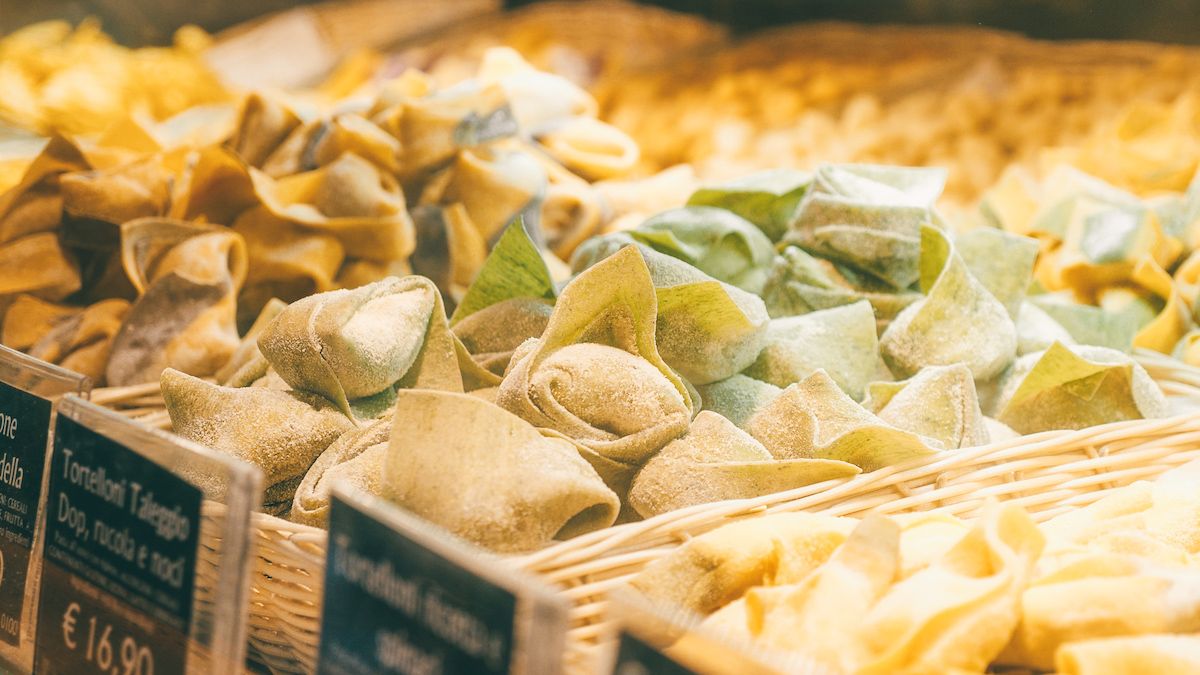
Food is one of the best ways to learn about a country's culture. Local ingredients, preparation techniques and how people eat together are all expressions of a country's identity. When exploring food culture, you are almost guaranteed to experience new flavours and ways of eating.
We have rounded up 32 outstanding culinary experiences we've had during our world travels that define a country's way of life. From discovering unique dishes to exploring distinguished wine regions around the world, you're in for a treat!
Each one of these gastronomic experiences link to a travel guide or itinerary that will help you plan your next trip.
32 Unique Culinary Experiences Around the World
1. eat at a traditional argentine steakhouse for an asado experience.

In Argentina, asado means to grill (BBQ). Asado is somewhat of a religion to Argentines and encompasses more than just a meal. It's a social event with friends or family where different types of meats are prepared outside over charcoal.
One of the best ways to experience Argentina's meat-forward culinary scene is by visiting a traditional steakhouse. In Buenos Aires, the best of the best is Don Julio . The beef is grass-fed and the juicy steaks are grilled to absolute perfection on the traditional v-shaped iron grill. It pairs perfectly with some Malbec wine. The restaurant also ranks #34 on the World's 50 Best Restaurants list and #1 on Latin America's 50 Best Restaurants list.
Reservations book up in advance, so make a reservation online to ensure you get a spot! We were luckily able to get a walk in reservation for lunch.
See our Buenos Aires travel guide for more unique things to do.
2. Discover Pacific-Northwest cuisine on the wild west coast
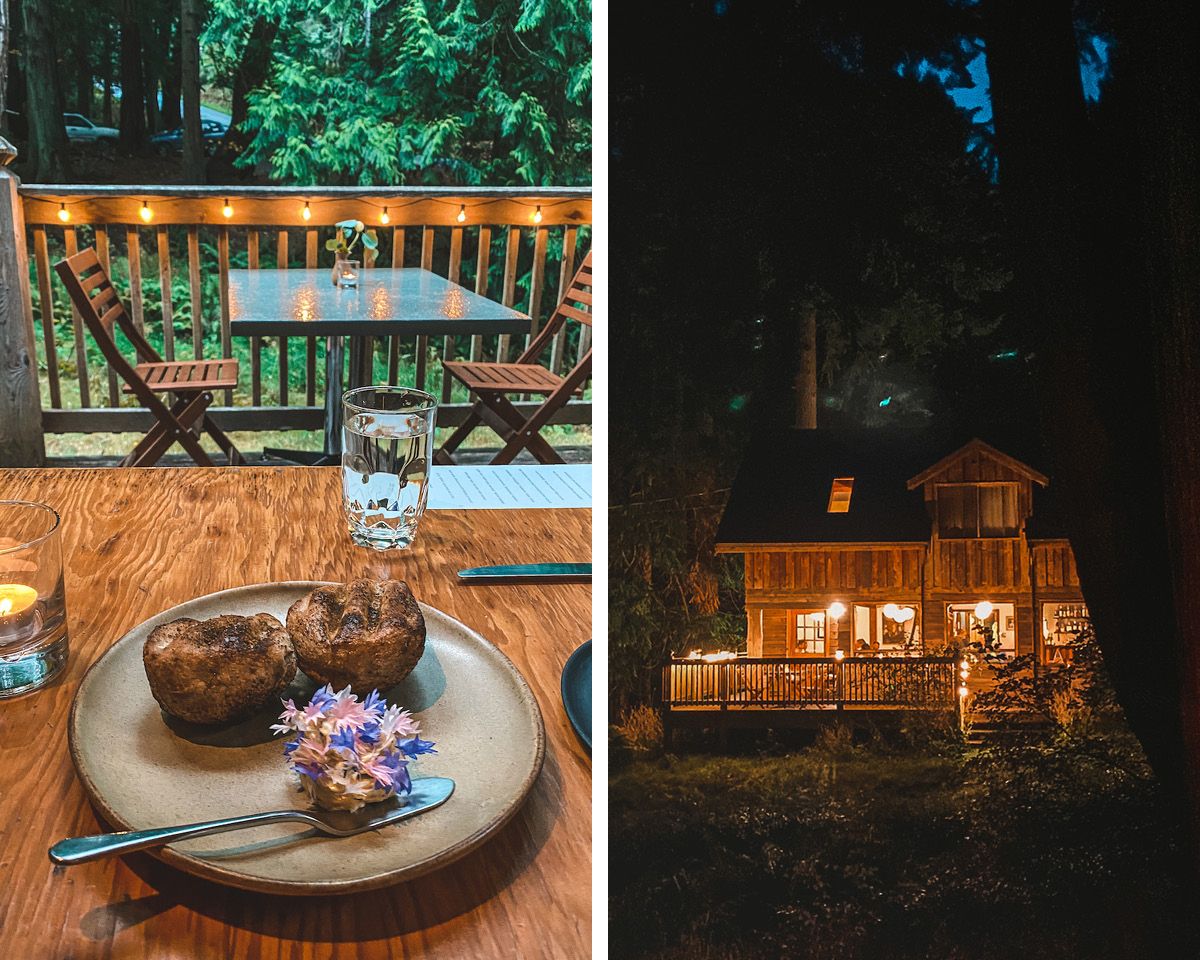
On the west coast of Canada you will find the Pacific-Northwest culinary scene where fresh seafood and veggie dishes are foraged from the land and coast. One of the most magical ways to experience this food scene is by visiting the remote Gulf Islands between Vancouver and Vancouver Island. Galiano Island in particular has one of the best restaurants in Canada called Pilgrimme . It's listed in Canada's 100 Best Restaurants 2020 list and enchantedly sits in the middle of the forest. It's quite the culinary adventure.
Head chef McCleery spent a season in the kitchen of world renowned Noma, a 2 Michelin-star restaurant where he advanced his cooking techniques and brought back new ideas to creatively combine ingredients.
Reservations book up far in advance, so make sure to book online .
See our list of the top 10 things to do on Galiano Island and start planning your trip.
3. Try Peking duck, Beijing's famous dish that has been eaten since the Imperial Era
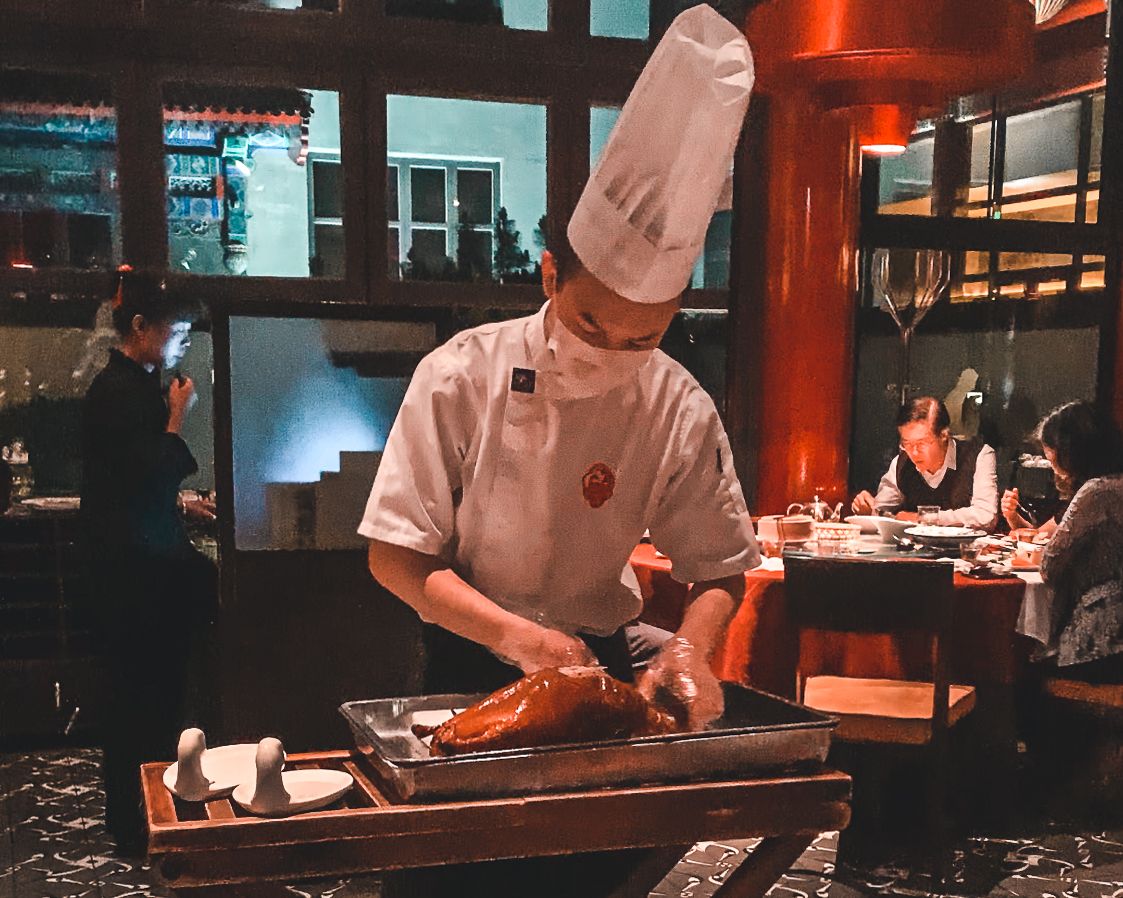
A delightful combination that is equally as sweet as it is savoury, Peking duck is a famous Beijing dish that has been eaten since the Imperial Era. During the Qing Dynasty it was considered a dish that only nobles could afford. The succulent duck has a perfectly crispy outside and is carved by the chef right beside your table.
It gets its crispiness from being glazed in sugar before it's roasted. Peking duck is usually served with pancakes (thin flour tortillas), cucumber and a hoisin or plum sauce.
See our ultimate 10 day China itinerary , which includes a stop in Beijing.
4. Devour a Roujiamo, a hamburger believed to be the world's first
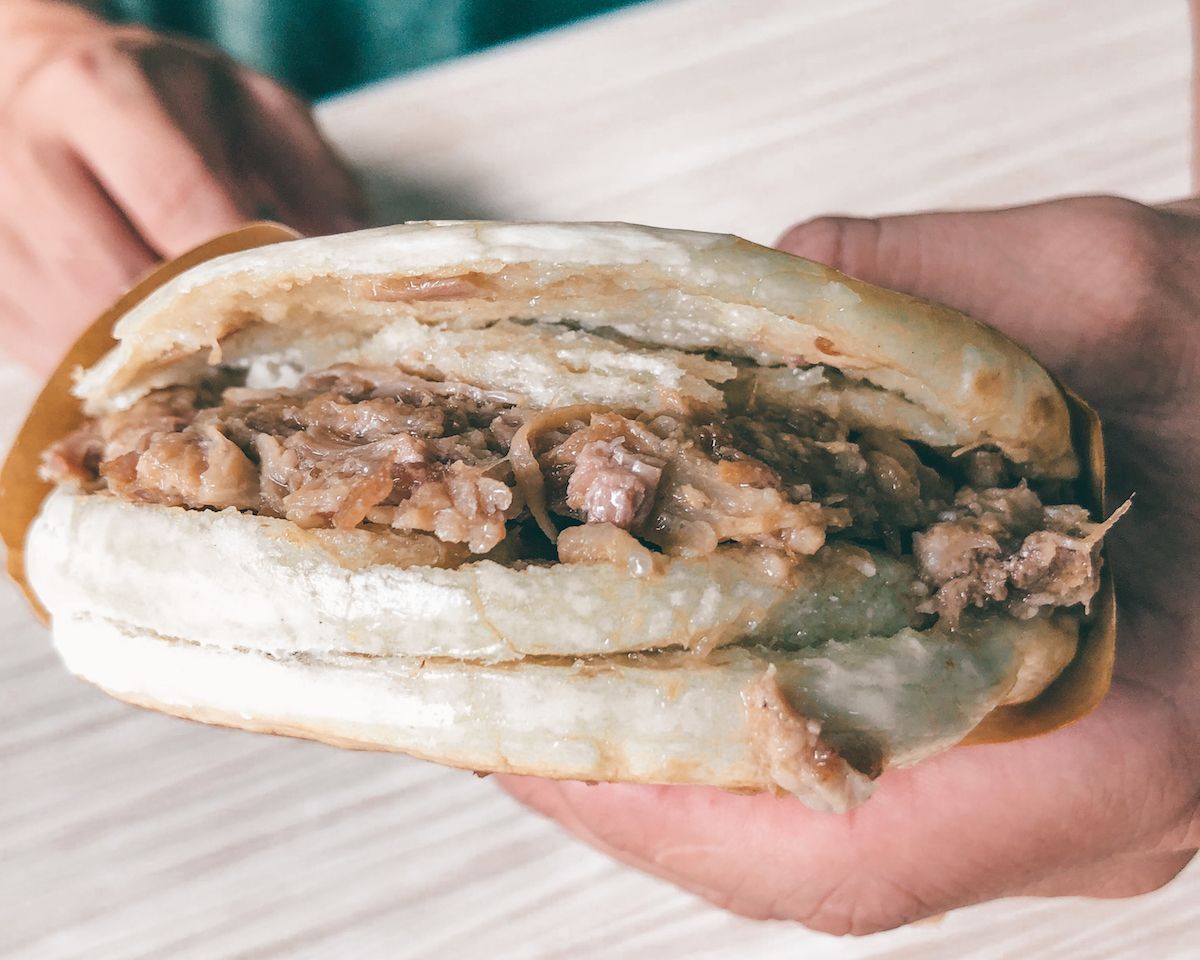
Roujiamo is considered by many as the first hamburger in the world. Its dense bun dates back to the Qin Dynasty (221 to 207 BC) and the meat to the Zhou Dynasty (1046–256 BC). The pan-fried bun is crispy on the outside, soft on the inside and is filled with mouthwatering slow-cooked pork. It's a popular street food in China that is sure to satisfy.
Our favourite roujiamo was from Fanji Braised Meat (樊记腊汁肉) in Xi'an. See our Xi'an travel guide for more info .
5. Dine on New Nordic cuisine at one of Helsinki's top restaurants
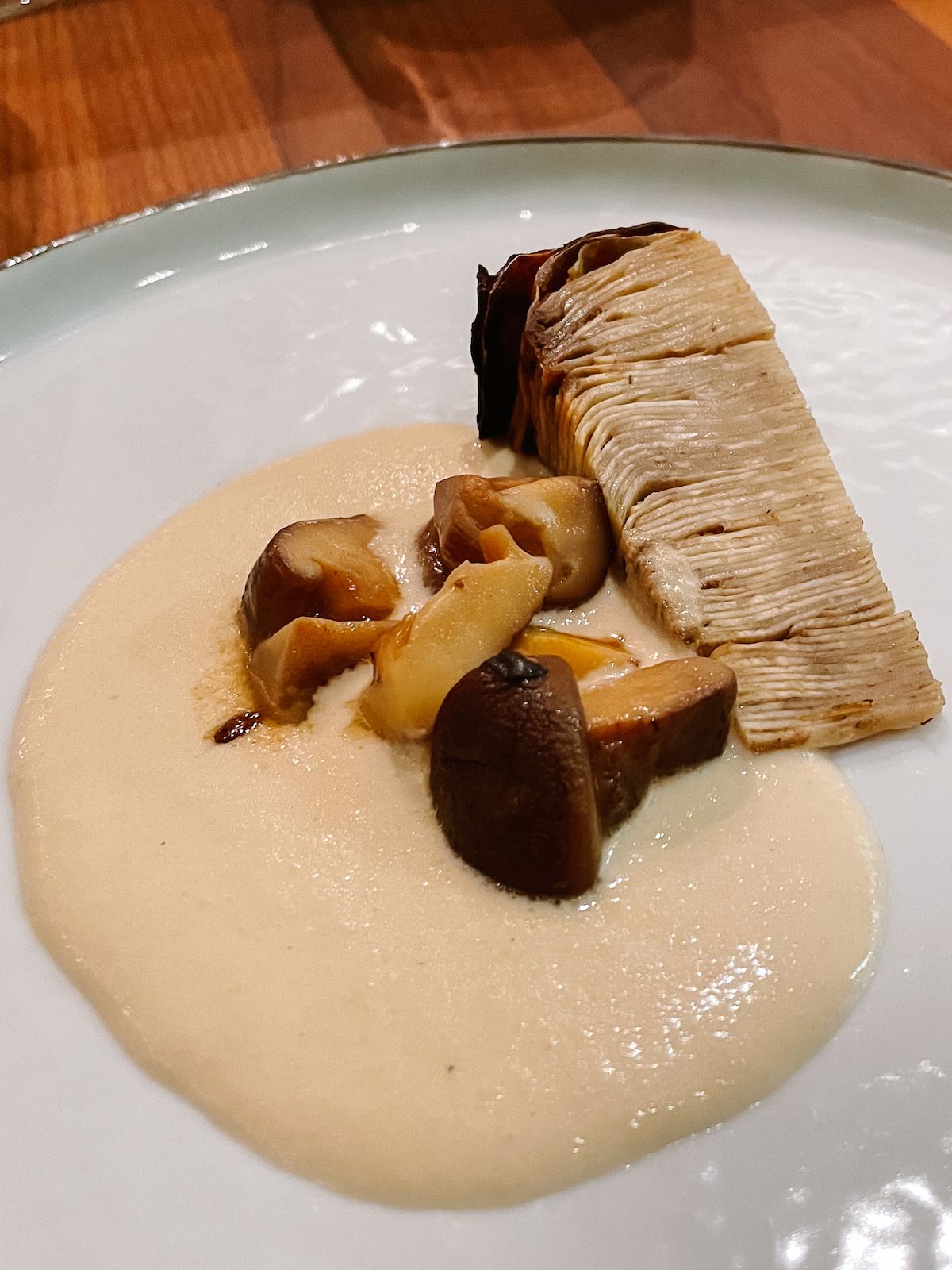
New Nordic Cuisine is an innovative culinary movement where old-world cooking techniques from Scandinavian countries are combined with the use of seasonal, locally-sourced ingredients in a sustainable way.
In Helsinki we saw traditional Finnish techniques like curing, salting, pickling and smoking being used with pure, local ingredients, like wild berries, forest mushrooms, fish and game. It was a treat finding so many quality restaurants offering this inventive type of cuisine.
You can also dine on New Nordic Cuisine in other Nordic countries like Denmark, Sweden, and Norway.
See our Helsinki itinerary , which includes a list of buzz-worthy restaurants serving New Nordic cuisine.
6. Knock back oysters in Cap Ferret, known as the oyster capital of France
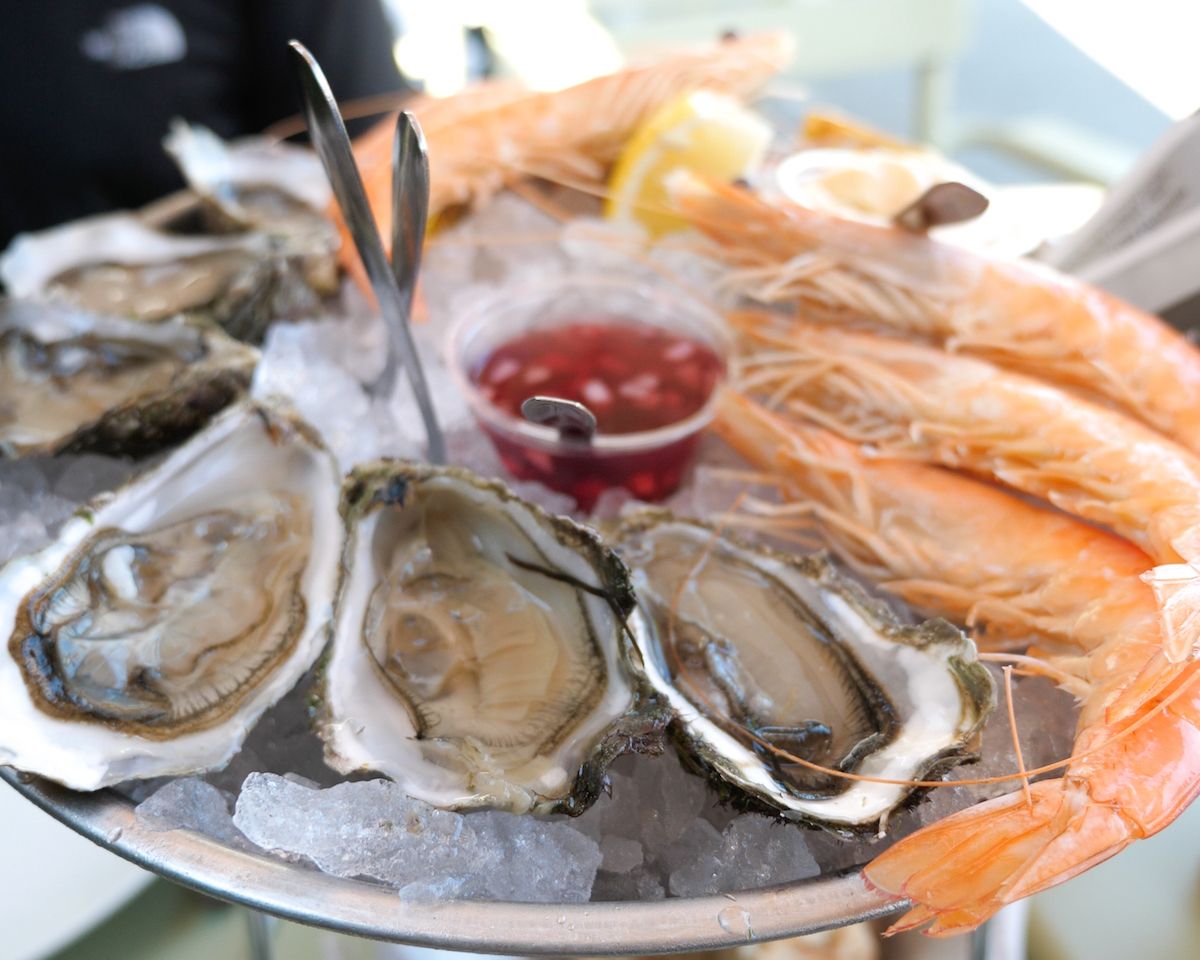
Cap-Ferret is a chic beach town in the southwest of France known for its wild Atlantic beaches and freshly shucked oysters. It's called the oyster capital of France since it supplies the whole country with oysters. Walk along the peninsula and choose from one of the many seaside restaurants for fresh seafood and cold white wine to match.
See our Cap-Ferret travel guide and start planning your trip to this relaxing seaside town.
7. Feast on delicious Georgian cuisine in Tbilisi
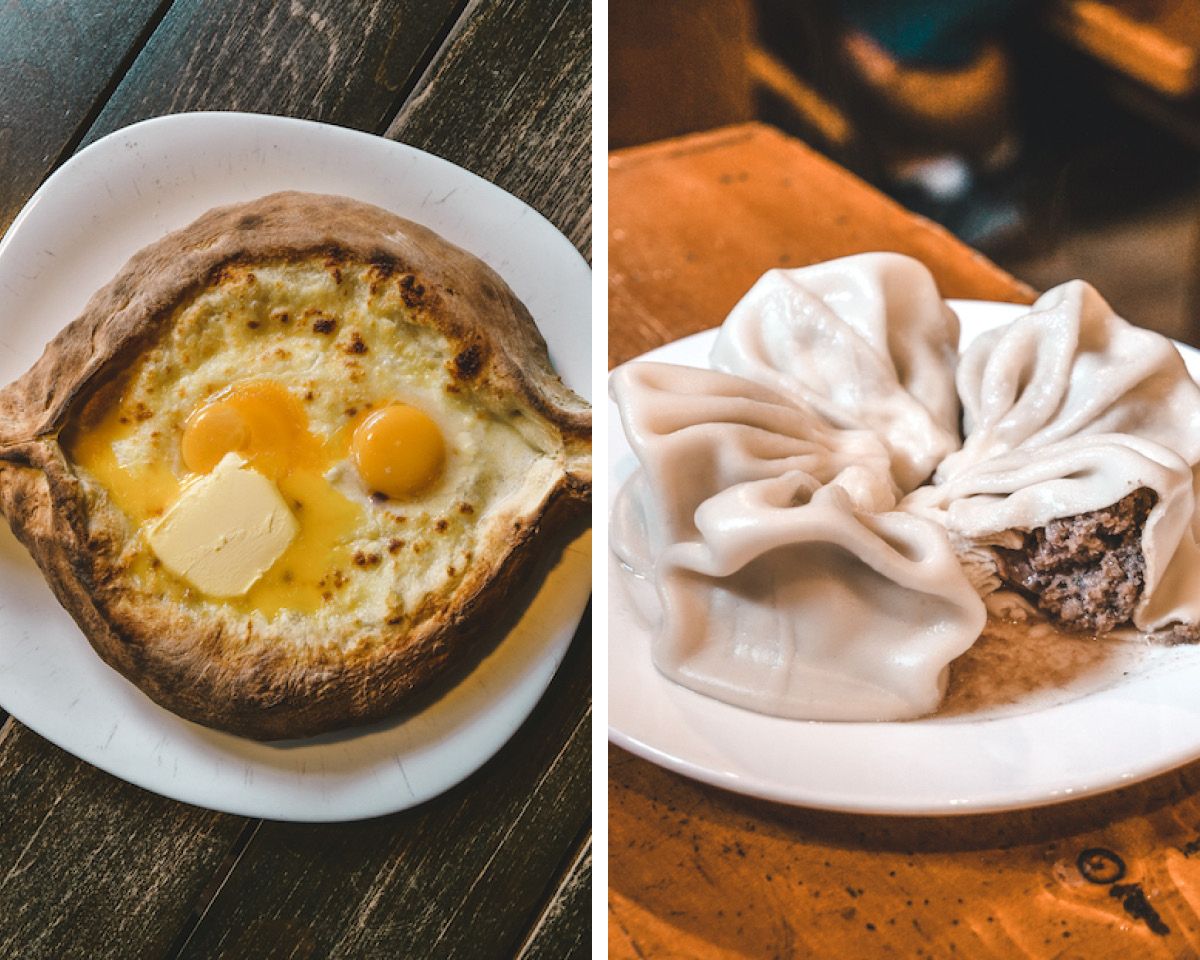
Georgia has an incredible food scene waiting to be discovered. In the capital city of Tbilisi you will find tons of traditional Georgian restaurants with delicious dishes that represent the country's rich culture and influence from the Mediterranean and Middle East. Georgians are very passionate about their food and like to source local, fresh ingredients. There are so many dishes and new flavours to try.
Must try specialities are meat filled dumplings called Khinkali that you eat with your hands and Katchapuri Adjaruli, a bread boat filled with cheese and topped with an egg. We also love Shashlik, skewered charcoal roasted meat, and Pkhali, a plate of vegetable pâtés with beans, beets and walnut sauce. Georgian spices can be found at most local markets, make sure to bring some home!
See our 1 week Georgia itinerary for the food and wine lover .
8. Go on a food tour through Machane Yehuda, the largest market in Jerusalem
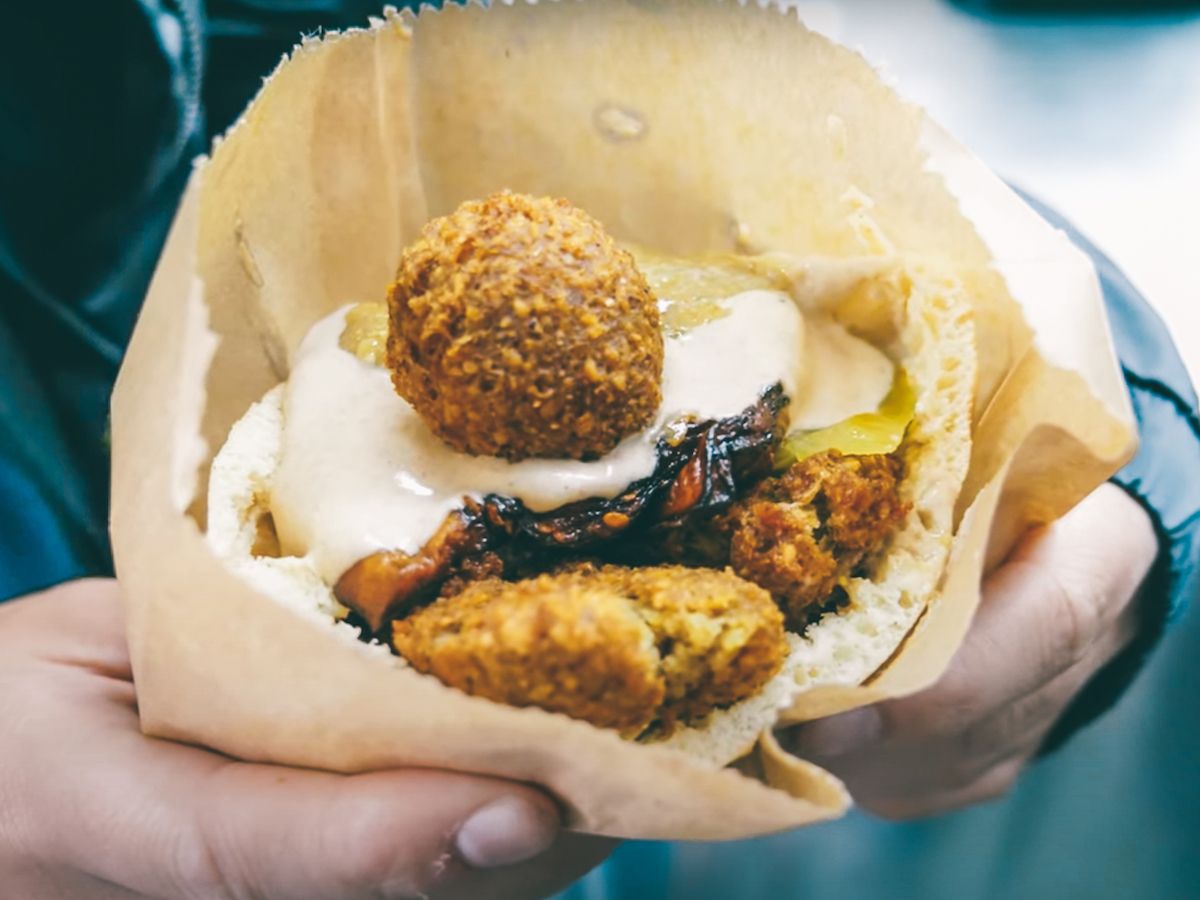
In Jerusalem, one of the oldest cities in the world, you will find Machane Yehuda, an open-air market filled with over 250 vendors selling spices, fresh produce and culinary delights . Walk through the market on your own or go on a food tour to learn more about the local delicacies. Look out for falafel, bourekas, sachlav and arais mmm!
The market is open every day of the week except Saturday. On Fridays it closes early for Shabbat.
See our Israel itinerary for more foodie spots .
9. Get blown away by Neapolitan pizza in Naples, the birthplace of pizza
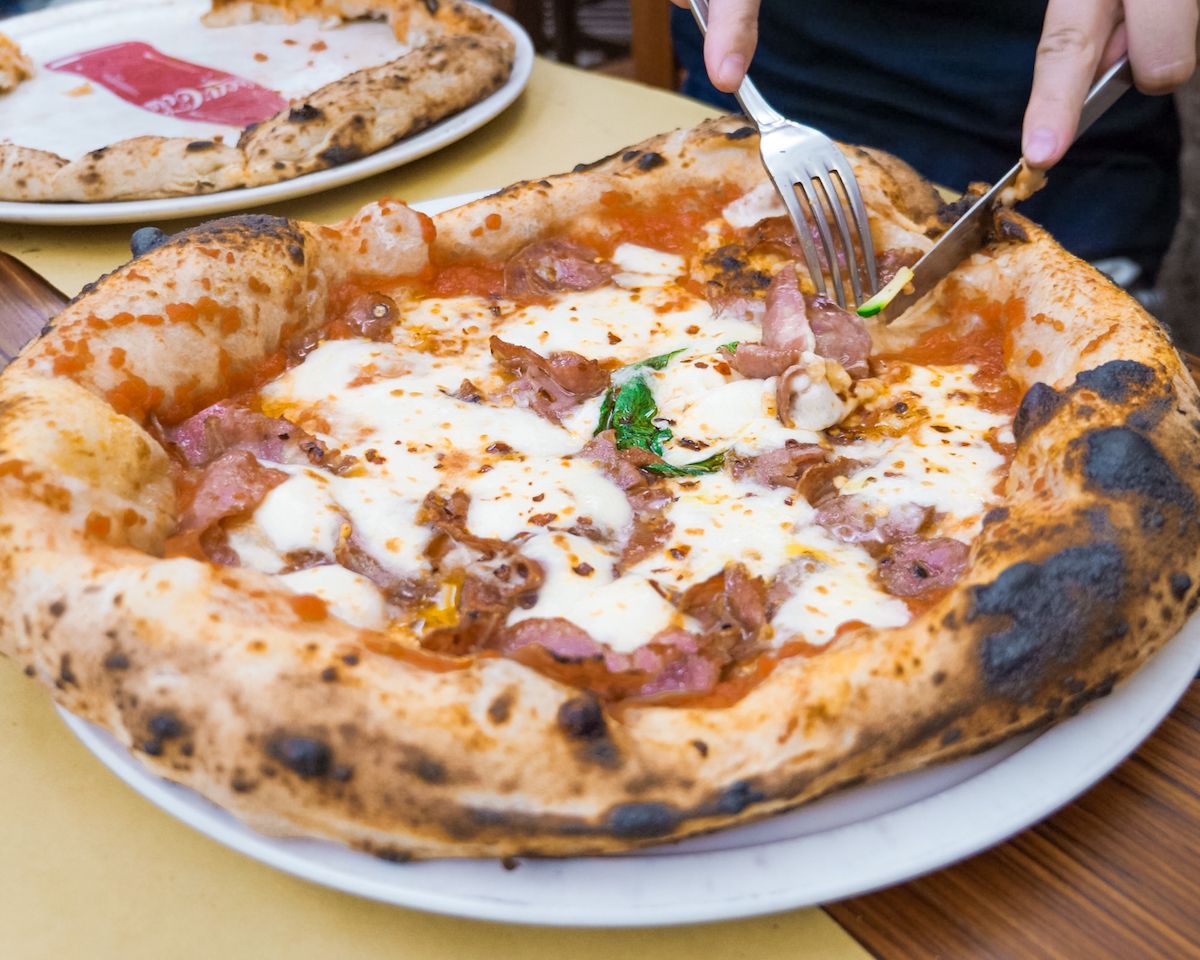
Naples is not a first pick for tourists traveling to Italy, but it's the ultimate foodie destination if you're a die-hard pizza fan. Although you will have to look past the city's shabbiness and crime issue with the local mafia, there is an interesting charm to it. Let me tell you, it was worth visiting to have the best pizza of our lives at Sorbillo. Ari is a pizza fanatic and nothing can touch this outstanding pizza in his opinion.
The pizzeria and its pizza maker, Gino Sorbillo, is the most famous in Naples and possibly the world. It's no surprise the pizza joint is featured in the Michelin guide.
Naples is a great hub for trips to Capri or the Amalfi Coast. See our ultimate 2 week Italy itinerary and start planning your trip.
10. Fill up on fresh pasta and meat ragout in Bologna, Italy's culinary capital
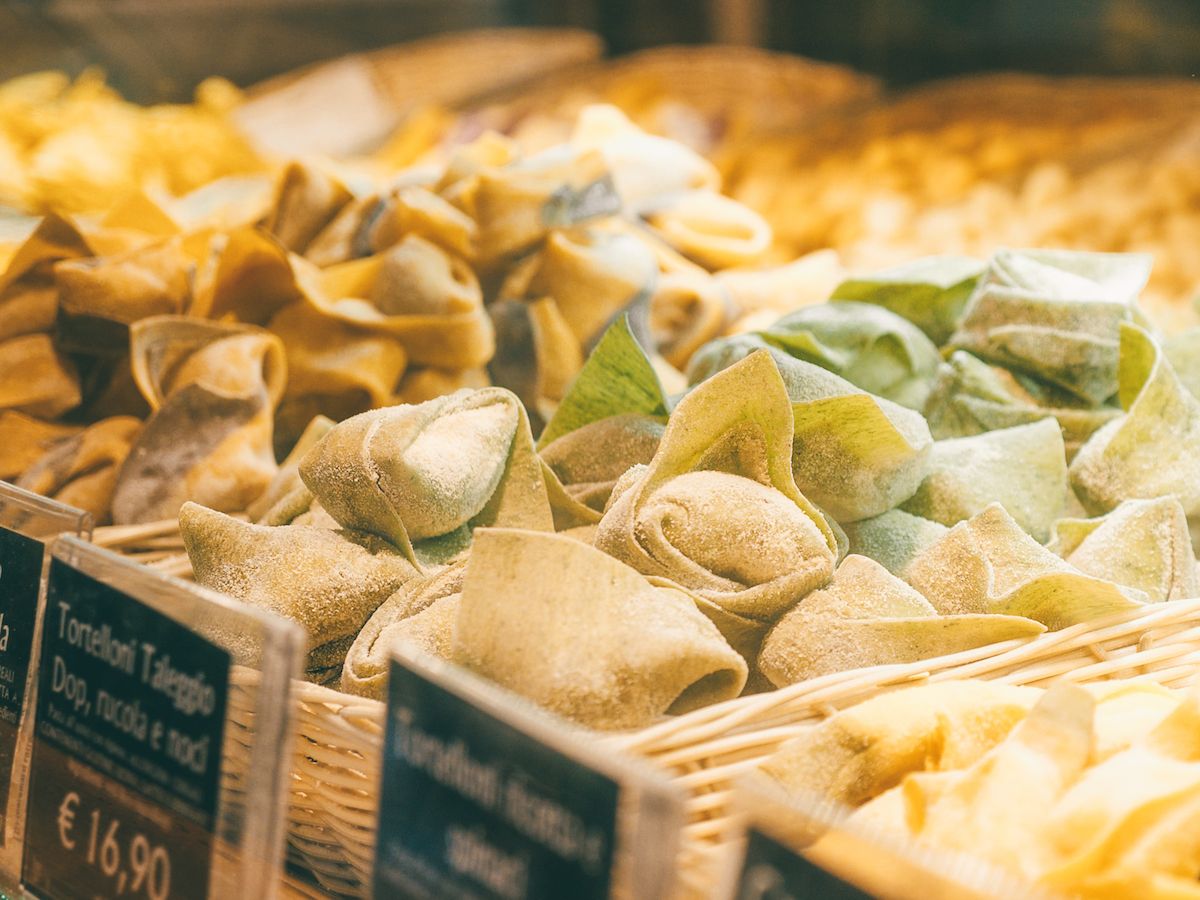
If you love pasta, you will be ecstatic about Bologna , the culinary capital of Italy known for its hand-rolled fresh pasta and meat ragout (internationally known as Bolognese sauce). Bologna is often overlooked by tourists for Italy's more popular cities like Florence, Pisa and Venice, meaning that you will see a more local side to the city and less tourist traps!
See our 2 day Bologna itinerary for our top local foodie spots.
11. Enjoy the freshest sushi at the Tsukiji Fish Market in Tokyo

Sushi is a top reason we travelled to Japan. Nothing can beat the freshness of the sushi you'll find at the Tsukiji fish market in Tokyo. The market used to be for wholesalers only, selling the freshest of fish. However, it became so famous with the public that it is now a hotspot with vendors and sushi joints packed along the small adjoining streets.
Head to the market for lunch and pick one of the many sushi restaurants that line the streets. Some must try pieces are the range of tunas: lean (maguro), medium fatty (chūtoro) and fatty (toro). Start with the lean tuna first and work your way up to the fattiest, so you don't ruin the flavour profiles of the fish.
See our list of 20 alternative things to do in Tokyo for more unique gastronomic experiences.
12. Eat Japanese cuisine omakase style for an element of surprise
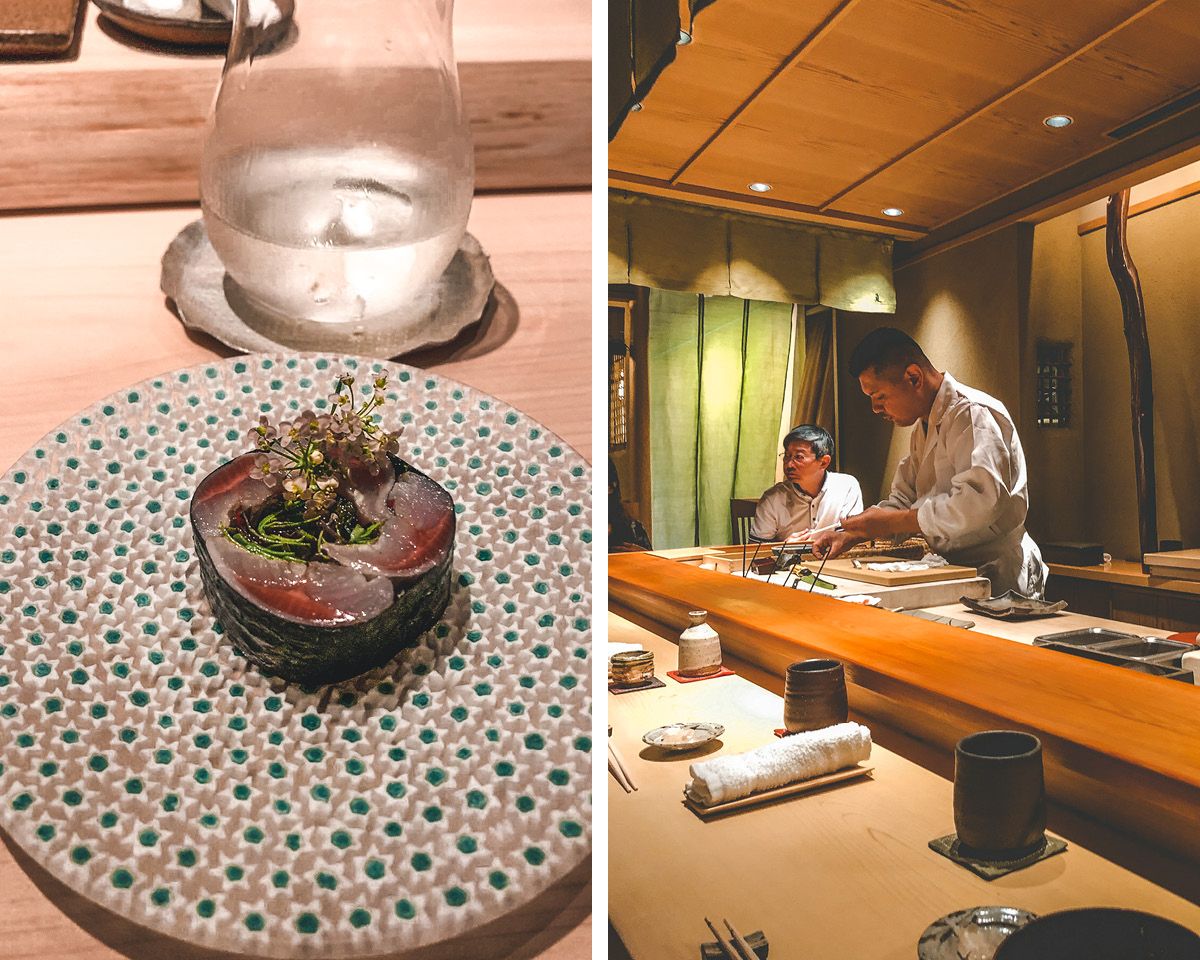
Omakase translates to "I leave it up to you" in Japanese. In other words you entrust the chef to choose what you will be eating. This can be intimidating since there is no menu and you never know what kind of sea creatures you will be eating, however it's an amazing way to try new flavours. Let the chef surprise you!
Omakase is typically a nigiri sushi experience where you are served piece after piece of fresh fish on top of rice until you're full. However there are different omakase experiences in Japan, like tempura and even some vegetarian options.
See our Japan itinerary to see our top omakase picks.
13. Treat yourself to melt-in-your-mouth Japanese Wagyu beef

If you are a steak lover, this is the experience you've been waiting for. Imagine a heavily marbled piece of meat, so soft and full of flavour that it melts in your mouth. You may have seen different kind of wagyu cuts on the menu from USA or Australia, however in our opinion nothing beats Japanese A5 wagyu.
Kobe is one of the most famous and exclusive prefectures where rumour has it that farmers massage their cattle and feed them beer. Like the best French wines stay in France, it's hard to get great Japanese wagyu since most of it stays in Japan. It's worth the splurge once once you visit!
See our 2 week Japan itinerary for more info.
14. Enjoy a kaiseki multi-course meal at a ryokan
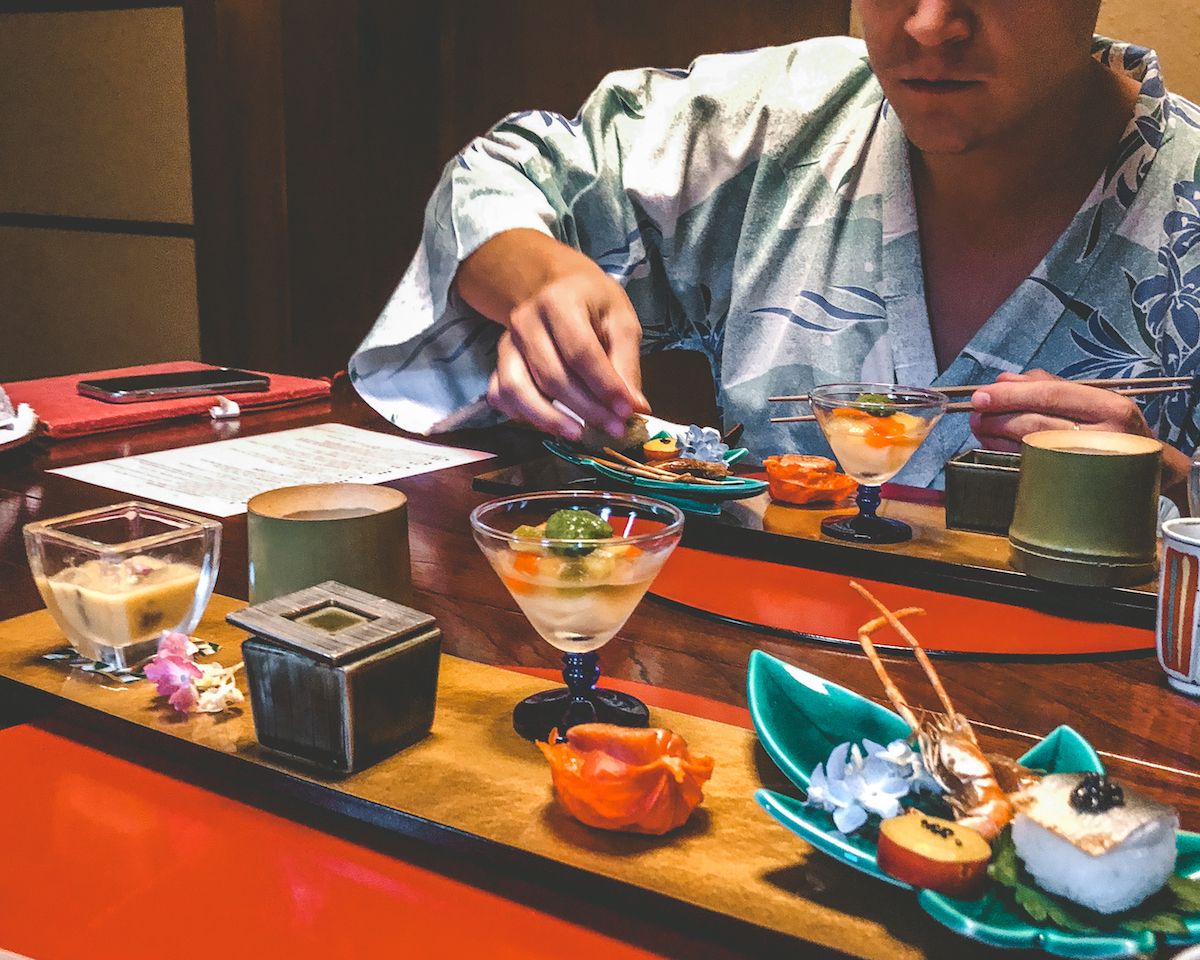
Staying in a ryokan, a traditional Japanese Inn, is a must try experience in Japan. You relax in a homey setting where you really get to be taken care of. Dinner is typically served to you in your room kaiseki style while you wear traditional yukata robes and sit on tatami mats.
Kaiseki is a traditional multi-course dinner where you are served between 6 - 15 courses. Each of these plates are defined by a particular Japanese cooking technique. This is different from omakase, since omakase can be tailored to the diner's reaction throughout the experience. Kaiseki is prepared in advance and is based on what produce is in season.
If you're looking for a relaxing Japanese gastronomic experience, this is the way to do it.
See our Japan itinerary , which includes a ryokan and kaiseki experience.
15. Devour Al Pastor tacos in Mexico City
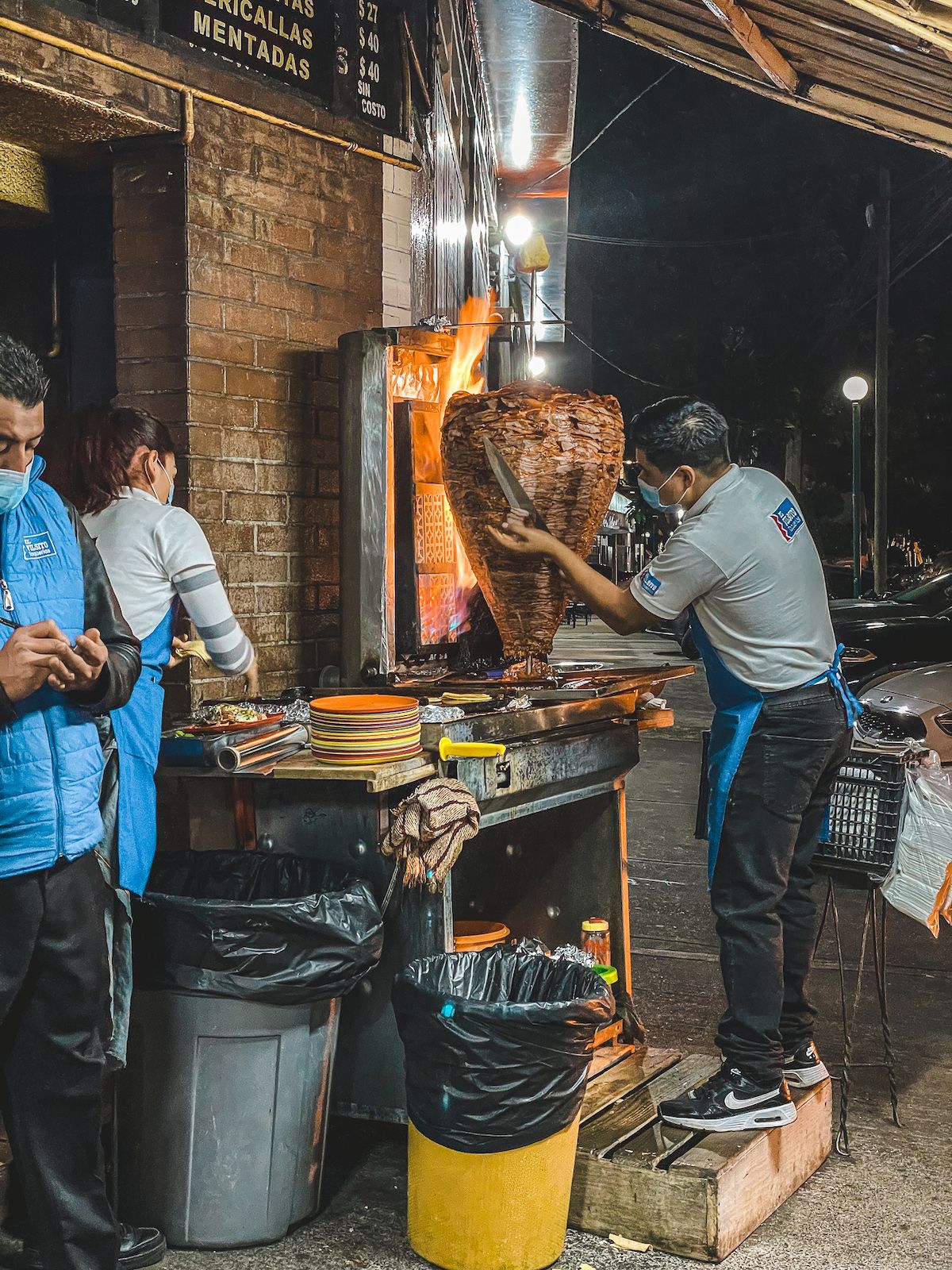
The concept of al pastor was introduced to Mexico by Lebanese immigrants in the 1930s. Spit roasted pork (like the spits you see at shawarma shops) is shaved onto a corn tortilla with onion, pineapple and cilantro . Each shop has their own unique spice rub on the pork, so al pastor is different everywhere you go. But, we find it's the sweet hit of pineapple that really makes them so tasty.
El Vilsito is our favourite street food shop in Mexico City. T he car mechanic shop by day turns into one of the most iconic al pastor taquerias in the city. Stepping up to the open-air taqueria feels like a social affair, with locals and tourists standing at tables chatting and devouring mouthwatering tacos.
See our Mexico City itinerary and start planning your trip.
16. Eat mole, a rich sauce from pre-hispanic times
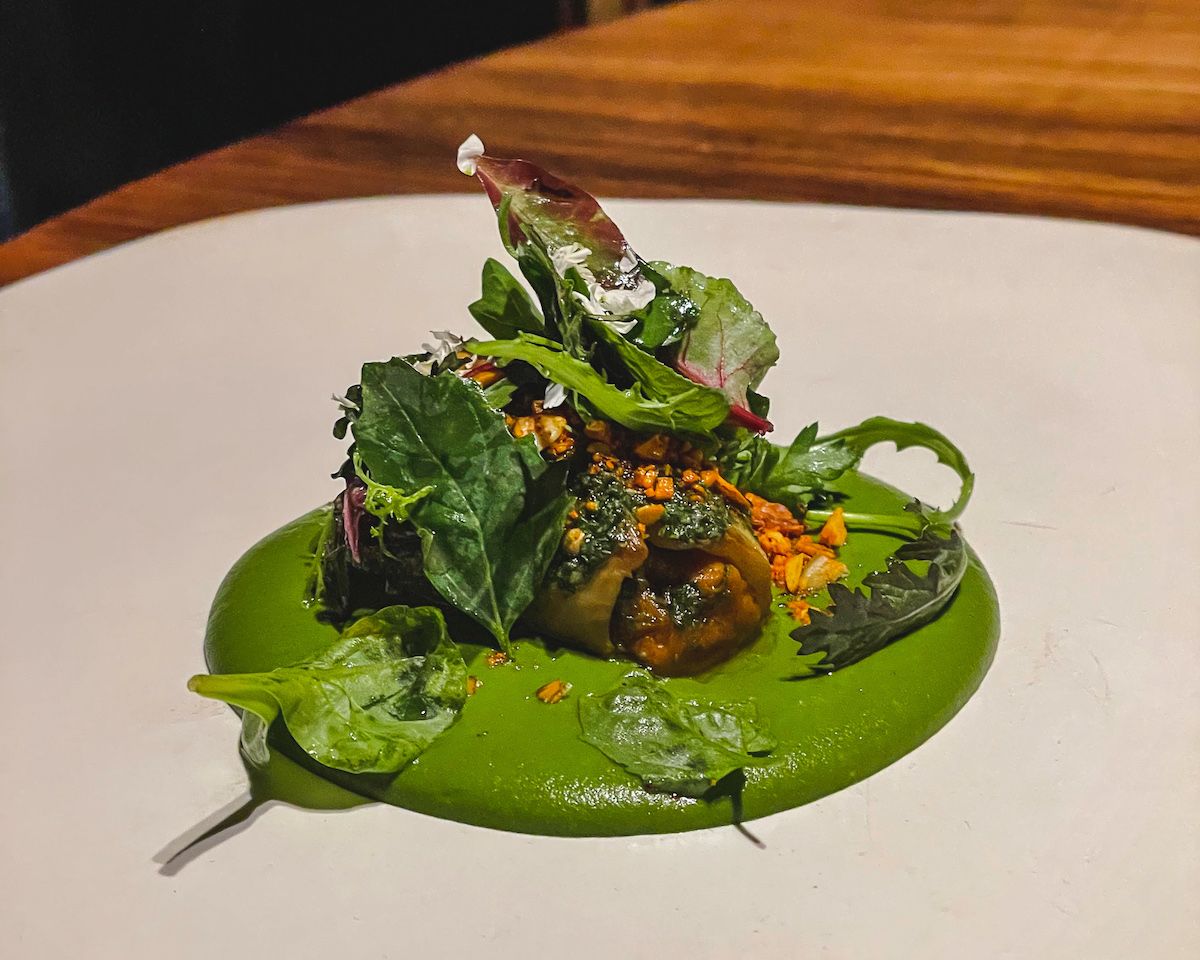
Mole is a rich sauce made with chocolate and chilli peppers that comes from pre-hispanic times. There are many variations to try, such as black, green and red mole.
For the ultimate culinary treat, dine at Pujol in Mexico City to try their famed mole madre that has been aged for more than 1,000 days . Pujol recently was ranked #5 in the World's 50 Best Restaurants list (2022). With Mexico's traditional cuisine listed on the UNESCO's Intangible Cultural Heritage List, it's no wonder you will find some of the best restaurants in the world here.
New Zealand
17. prepare yourself for a feast at the green dragon in hobbiton.
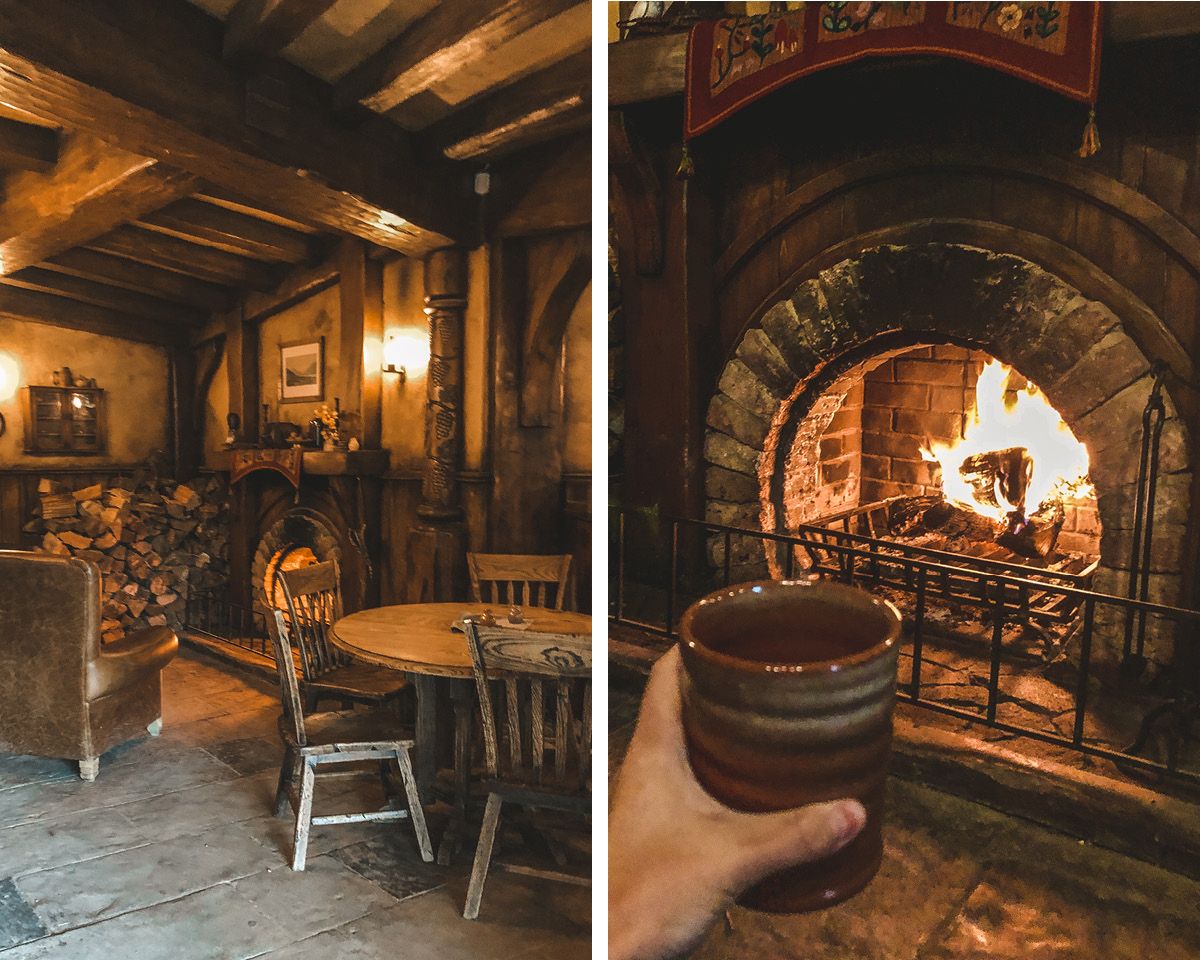
Dining at the Green Dragon in Hobbiton is the quintessential food experience for Lord of the Rings fans. The Hobbiton Banquet tour is the last of the day, meaning you have the entire grounds to yourself, during sunset, without other tour groups nearby.
And it doesn't stop there! After your tour through the movie set, you step into the Green Dragon to have a drink of craft beer by a crackling fire while you await for the feast. Next, you are invited to a large communal table where platters of delicious food, like chicken, fish, sausage, lamb shank, roast veggies, salad, mashed potatoes and gravy are served to you. Dig in! The music and the atmosphere makes it really feels like you're in the movie.
The banquet tour sells out far in advance so make sure to reserve your spot .
See our New Zealand itinerary and start planning your trip to this fun-filled country .
18. Discover Michelin-starred street stalls in Singapore

The hawker centres in Singapore aren't like your typical food courts. You will find hundreds of stalls in these open-air food markets cooking up authentic dishes from different cultures in China, India and Southeast Asia. The dishes coming out of these stalls are of such high quality some even have a Michelin star! It's an amazing place to try different kinds of dishes since they are inexpensive and you can easily come back for more (if you don't mind waiting in line again).
Our favourite food stall is called Hill Street Tai Hwa Pork Noodle , which has earned itself a Michelin star. It was worth the hour-long lineup for the perfectly savoury soup made with fresh homemade noodles and slices of tender pork.
See our 2 day Singapore itinerary for a list of the most popular hawker centres.
South Korea
19. experience seoul's vast foodie scene.
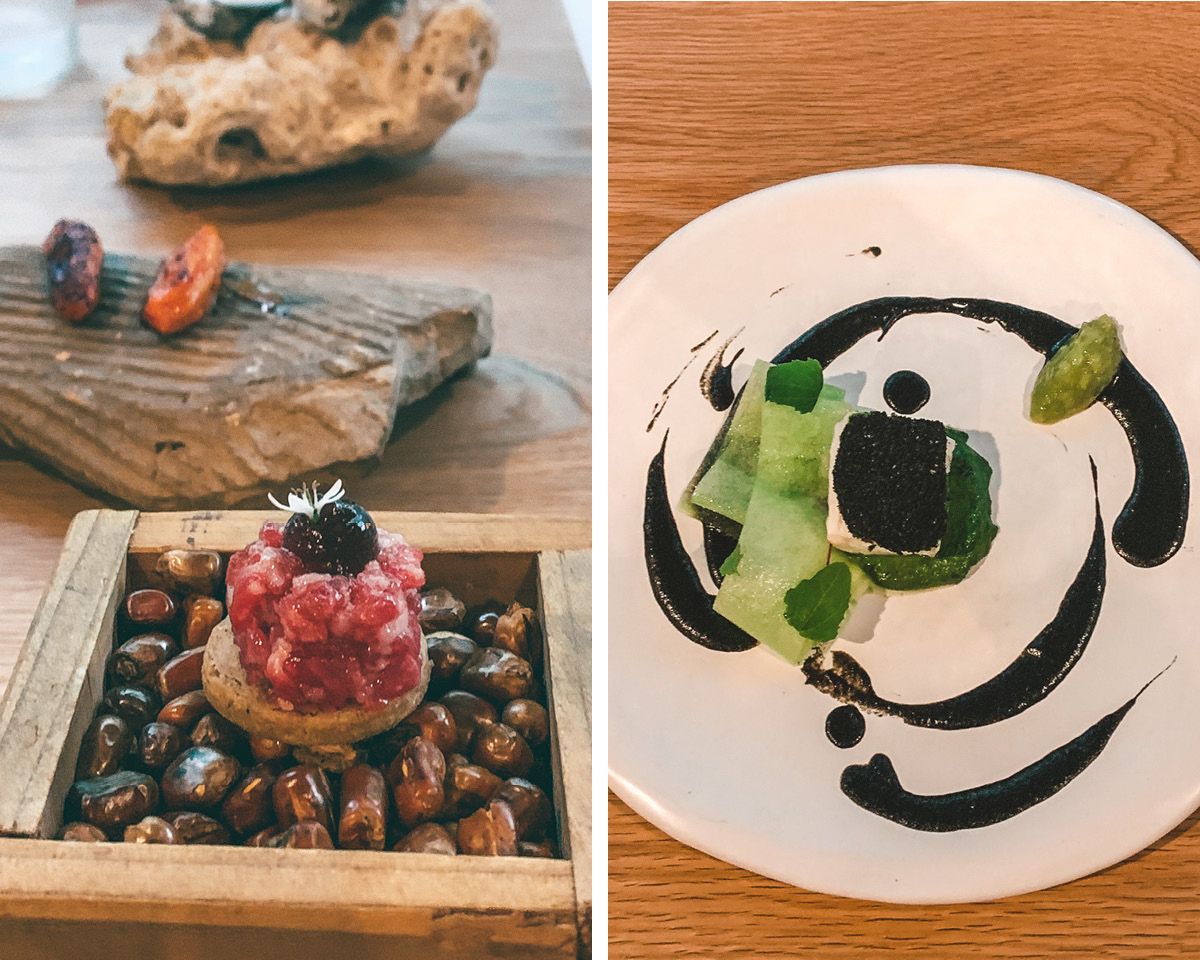
South Korea has a fascinating food culture with unique dishes for every kind of mood. In Seoul there is a plethora of places to choose from, from street food vendors to contemporary fine-dining restaurants. You will see streets lined with restaurants and outdoor seating where Koreans gather to socialize and eat.
A must do gastronomic experience is going to a Korean BBQ restaurant and trying Hanwoo 1++ beef. It's South Korea's premium beef that that competes with A5 wagyu.
Our favourite comfort food is Korean cheese fondue called Dakgalbi where you are served a pan filled with melted cheese, chicken and veggies. It's delicious!
For street food, don't miss the satisfying gamsung, a deep fried pogo-style hot dog covered in bits of fries. YUM!
See our list of alternative things to do in Seoul for more foodie experiences.
20. Go on a pintxo bar crawl in San Sebastian
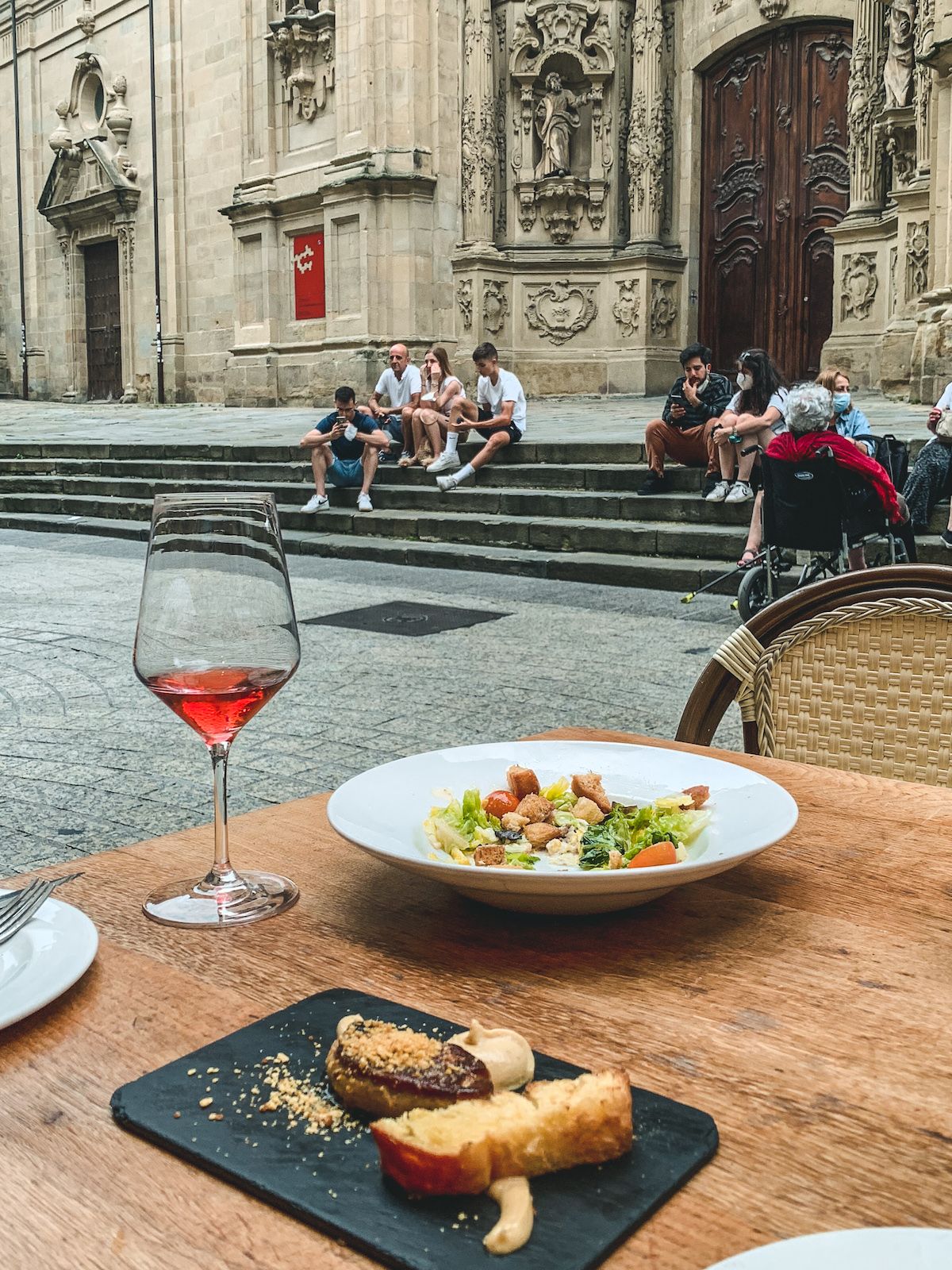
San Sebastian is a happening city in the northern Basque Country, where Europeans love to go for summer vacation. The Basques are one of the oldest ethnic groups in Europe and have a food culture like no other. This is reflected in almost anywhere you eat in the city. You'll find hundreds of pintxo bars serving cheap and delicious gourmet snacks , kind of like next level tapas, and Michelin-starred restaurants around almost every corner.
See our San Sebastian itinerary , which includes our favourite spot to eat pintxos.
Switzerland
21. treat yourself to delicious swiss cheese specialities in the alps.
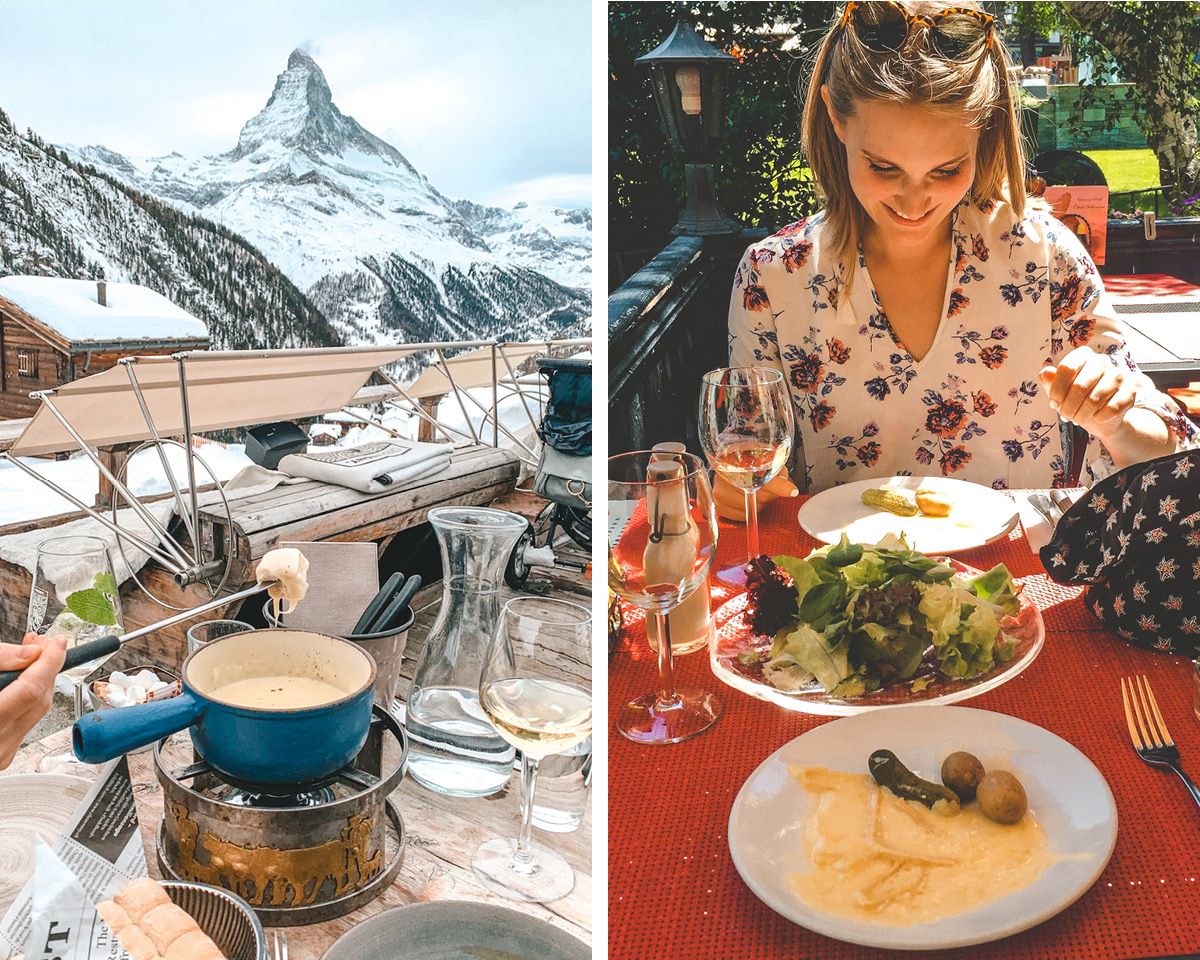
Switzerland is THE place for cheese lovers. When we travel to Switzerland one of the things we are most excited for is eating raclette and cheese fondue, two Swiss cheese specialties. When we try to order these dishes outside of the country it's just not the same!
Raclette is prepared by cutting a big wheel of Raclette cheese in half and heating the cut side under an element until the cheese is golden and bubbling. This gooey deliciousness is then scraped onto a small plate with baby potatoes, pickled onions and pickles. Melted cheese on a plate, what could be better than that!?
Cheese fondue is typically a blend of Emmental and Gruyère cheese with kirsch, white wine and garlic. Once it starts bubbling in the fondue pot, you dip your long fondue fork with a piece of bread into it and pick up as much cheese as you can. This is a fun dish to share with a group, just make sure you make a double order if required!
Both of these dishes pair perfectly with views of the Swiss Alps and local white wine. These meals are especially cozy during wintertime when you want to warm up.
See our list of fun things to do in Zermatt , which includes our favourite Swiss restaurants.
22. Drink Malbec wine and discover Mendoza, Argentina's mountainous wine region
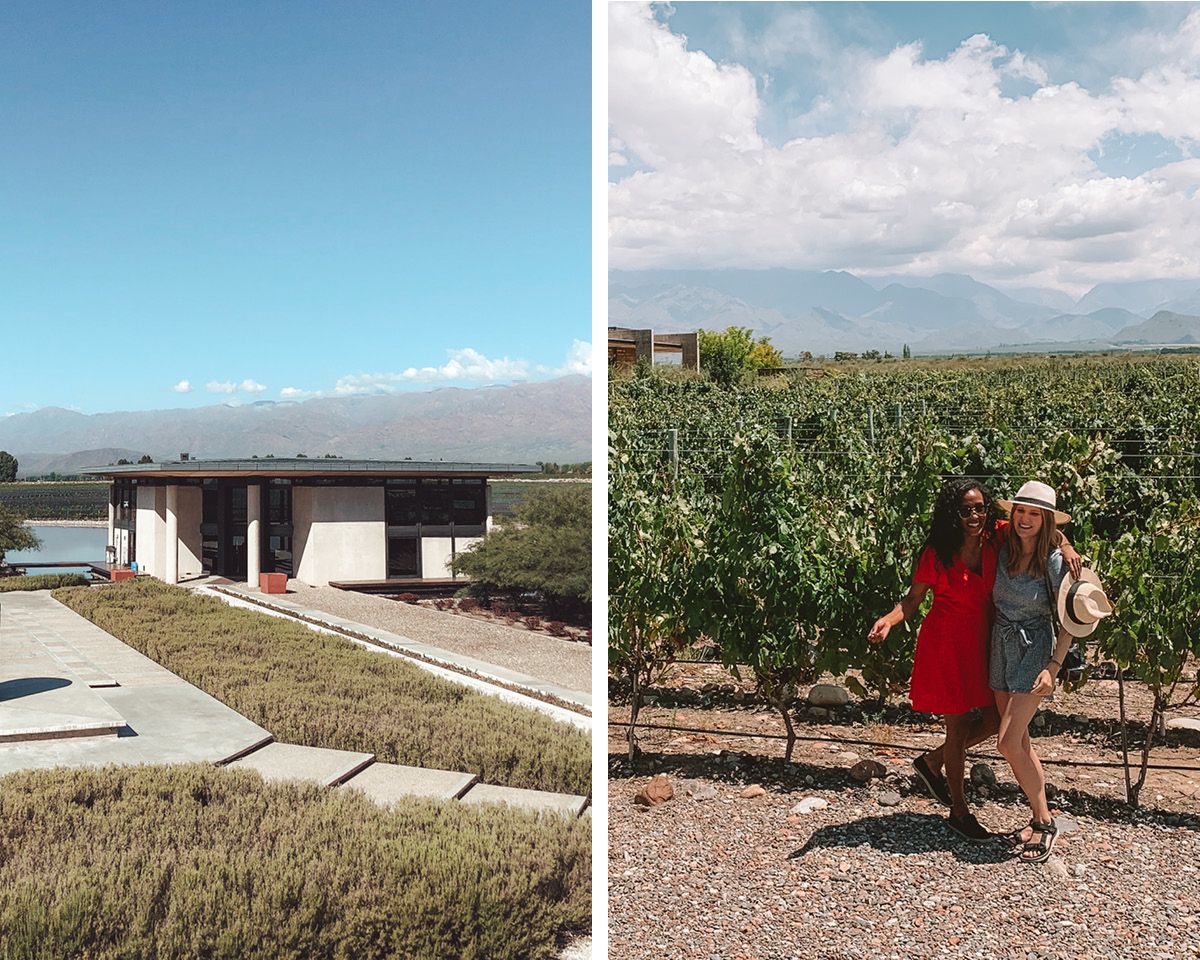
At the edge of the Andes you will find Mendoza, Argentina's largest wine region. The new-world wine region is famous for its Malbec grapes that produce a full-bodied wine with juicy, dark fruit characteristics. It's one of the six grape varieties allowed in a French Bordeaux wine and is a great alternative to Cabernet Sauvignon and Syrah wines.
Mendoza is an extraordinary place to relax and learn about wine. The region has over 1,500 wineries, delicious Argentine restaurants and boutique vineyard hotels with stunning views of the Andes mountains.
See our Argentina itinerary , which includes a stop in this beautiful wine region.
23. Sip a refreshing caipirinha, Brazil's national cocktail
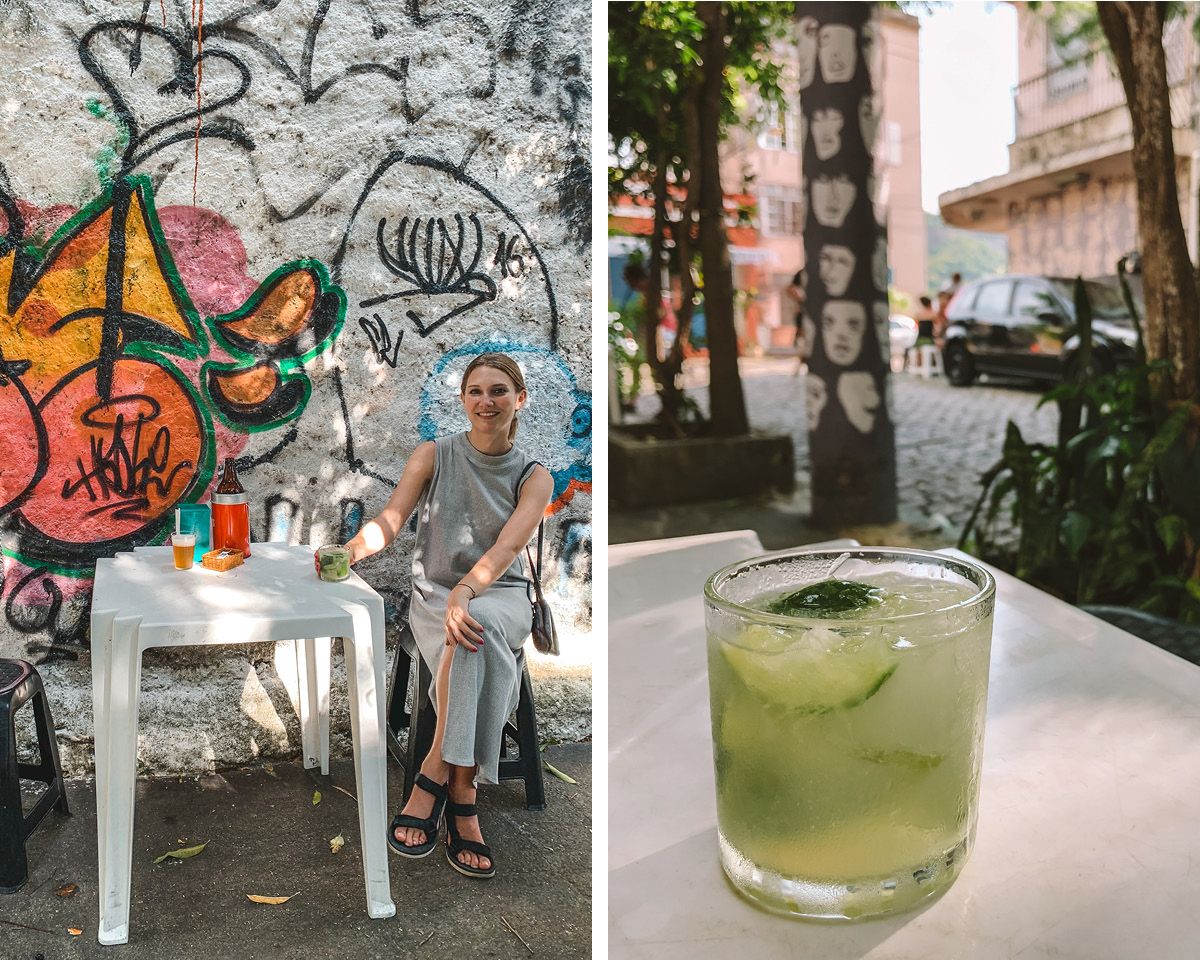
We discovered one of our favourite cocktails in Rio de Janeiro. We saw this cocktail everywhere we went and soon learned it was Brazil's national cocktail. Called the caipirinha, it simply contains 1 muddled lime, 1 spoon of sugar and cachaça, a liquor made from sugarcane.
Cachaça is the national spirit of the country, how tequila is to Mexico. The name cachaça can only be used if it's produced in Brazil, similar to that of champagne in France. A caipirinha pairs perfectly with a sunny day.
The best way to have a caipirinha is outside on a patio or at a bar with views of the beach. They are so refreshing that we even try to make them at home!
See our Rio De Janeiro guide for more fun things to do in the city.
24. Relax with a pisco sour in the mystical desert town of Pisco
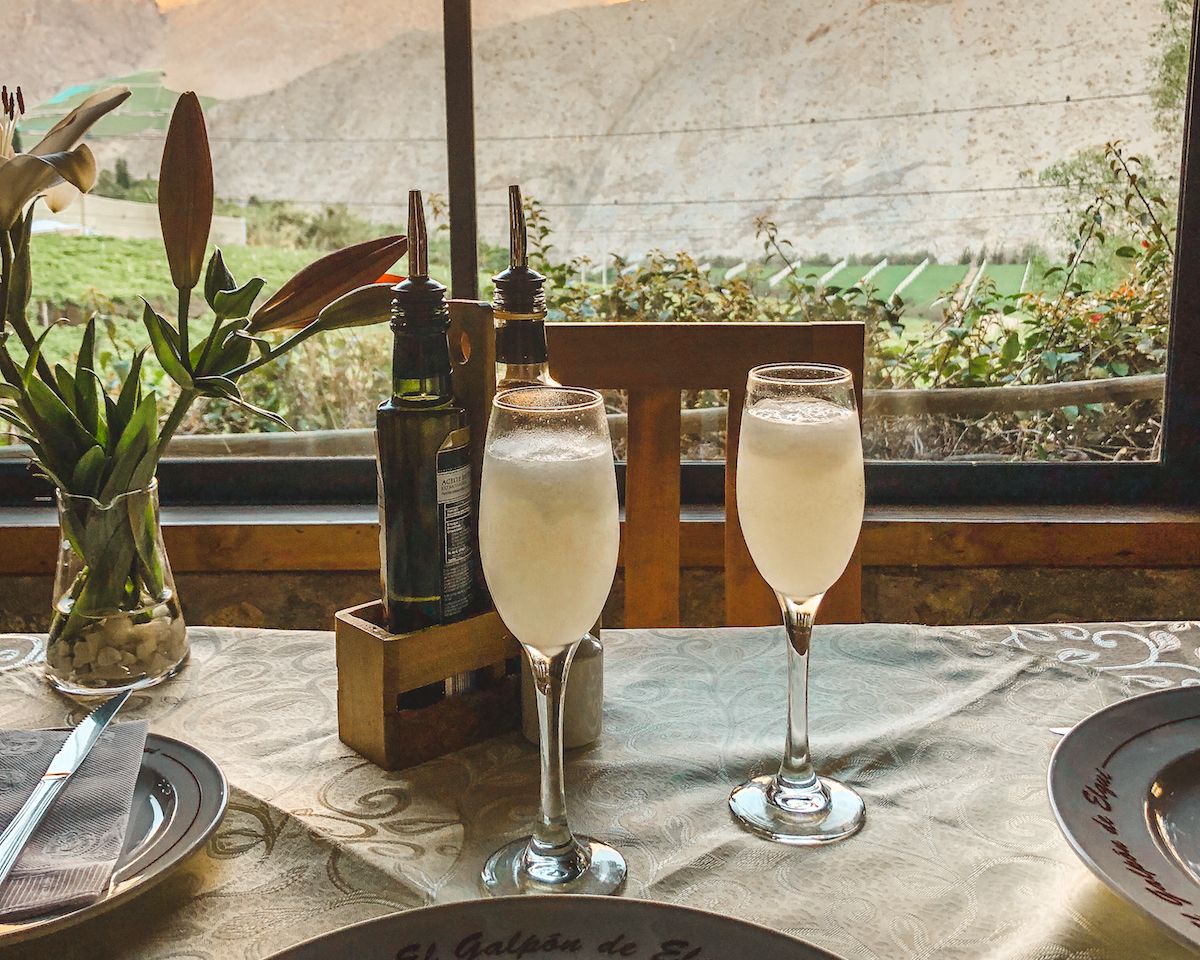
Pisco is a type of brandy made from distilling grapes. One of the best ways to discover Chilean pisco is in the town called Pisco itself. This free-spirited village is located in the mystical Elqui Valley, known for its amazing stargazing and mountainous desert. There are a few distilleries around the area where you can go for a pisco tasting and tour.
Peru and Chile have a longstanding feud with where pisco originally came from and you will notice different flavour profiles depending on where the pisco was produced. A part of this is because each country uses different grapes.
A pisco sour is another one of our favourite cocktails. To make a pisco sour you shake ice in a cocktail shaker with lemon juice, egg white, simple syrup and pisco. It's the perfect combination for a satisfying and tasty drink.
See our Chile itinerary , which includes a stop in Pisco and a tour of a pisco distillery.
25. Sample Pu'erh tea at Da Ke Tang, a teahouse in a 1930s mansion

Pu'erh tea is a fermented tea from the Yunnan province that is compressed into round disks and stored for many years, aging like fine wine. The older the tea and the more recognized the producer, the more you can expect to pay.
In Shanghai you can sample Pu'erh tea in a 1930s mansion called Da Ke Tang . This glamorous spot is tucked away in the back streets and has historically been a hangout for intellectuals and Shanghai's elite. While you can purchase Pu-erh tea here for around $20, watch out for the expensive stuff that will set you back a few thousand dollars!
There are two types called raw and ripened Pu'erh. They look similar when dry, but once you steep them, they are completely different in taste and colour. Raw Pu'reh is usually more expensive than ripened Pu'erh, but it depends on where and when it was made. It's fun having a tasting to see which one you like better.
See our China itinerary , which includes at stop at this luxurious teahouse in Shanghai.
26. Enjoy a fabulous afternoon tea in London

Afternoon tea is an English tradition dating all the way back to 1840, when Anna, the 7th duchess of Bedford, requested that tea, bread and cake be brought to her room around 4pm to satisfy her hunger before a late dinner. She eventually started inviting friends to this affair, and over time this afternoon ritual caught on with others. It transformed into a lavish event where upper-class women dressed up and met in the drawing room around 4pm to drink tea, eat finger sandwiches, pastries and scones, and of course gossip.
In London there are many glamorous places to enjoy afternoon tea. The Ritz has one of the best afternoon teas in the city , where you can take part in the posh lifestyle. Opening in 1906, it has become one of the most prestigious hotels in London, attracting celebrities and royal guests. It may be a bit stuffy, but it's all in the fun.
See our London itinerary and start planning your trip.
27. Learn about the world's oldest winemaking technique in Signagi

Signagi is the perfect place to learn about Georgian wines. Also known as the "city of love" by Georgians, this charming hilltop town has cobblestone streets, traditional houses with wooden porches and beautiful views of the Caucasus mountains. It's located in Kakheti, Georgia's most prominent wine region, and has many wineries to discover.
For over 8,000 years, Georgians have used egg-shaped earthenware vessels called qvevris to ferment their wine. These qvevris are buried in the ground, allowing for a relatively constant temperature. In 2013 this ancient Georgian winemaking technique was added by UNESCO to its Intangible Cultural Heritage list.
See our Signagi guide for the best wineries to visit.
28. Discover Sangiovese wines in Tuscany

Take a road trip into the beautiful Tuscan countryside to discover Italy's famous wine regions. This area is known for its Sangiovese vines that produce a dry red wine. Sangiovese grapes make Italy's most distinguished wines, such as Vino Nobile di Montepulciano, Brunello di Montalcino and Chianti. It's a wine drinkers paradise!
The three main wine-growing areas in Tuscany are Chianti, Montalcino, Montepulciano, each having a considerable amount of wineries to discover. Driving through gorgeous hilltop towns and visiting these captivating wineries feels like you're in a classic Italian movie.
See our 2 week Italy itinerary , which includes a stop in Tuscany.
29. Winery hop by bike through the Marlborough wine region
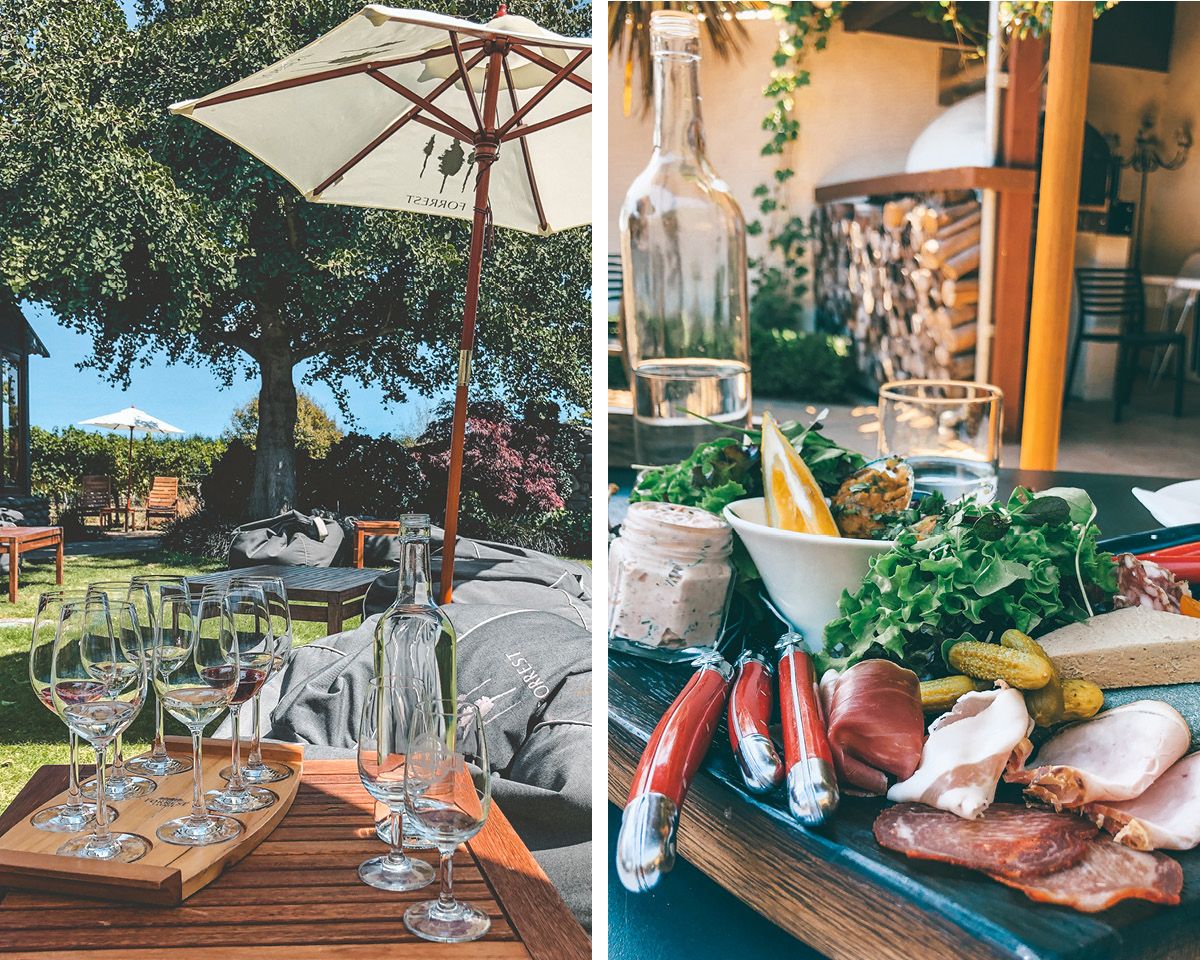
Take a break from your campervan and rent a bike to cycle the golden mile of wineries in Marlborough. The sunny, dry area is New Zealand's largest wine region and is well known for its Sauvignon Blanc wines.
The golden mile starts in the cute town of Renwick and takes you to nine wineries. The best part is that you don't need to make reservations in advance, so you can take your time bike hopping (or wobbling) from winery to winery. Many tastings are also free, which makes it a budget friendly activity. You're in for a relaxing day!
See our New Zealand itinerary , which includes a stop in the Marlborough wine region.
30. Go on a Scotch sipping tour through Scotland

Scottish whisky is Scotland's national drink dating all the way back to the 15th century (and note that is whisky without an "e", unlike Ireland). For years, Scottish producers have been honing their craft, creating the highest quality of whisky . You can tell the country really takes pride in their whisky when you visit distilleries or even order a glass from the bartender. By law, to classify as "Scotch", the whisky has to be distilled and matured in oak casks for at least 3 years in Scotland and must be at least 40% abv in strength.
Go on a scotch sipping tour in Scotland by visiting award-winning distilleries like Talisker Whisky, or try a flight at Bertie's Whisky Bar, what we think may be the most glamorous whisky bar in the world.
See our Scotland itinerary , which includes stops at a distillery and whisky bars.
31. Drink a green bottle outside a convenience store in Seoul

Drinking is a big part of South Korea's gastronomic culture and plays a big role in how Koreans socialize. During the evening you will see tons of tables outside filled with people mingling, eating and drinking soju. Soju is a clear spirit that comes from South Korea and tastes like a sweeter and milder version of vodka. The fruit flavoured versions are tasty and are meant to be taken straight without mix.
It's common to see locals pick up a green bottle (local term for soju) from a convenience store, pay 10 cents for a cup and sit down on plastic chairs in front of the store. There is also typically a microwave to heat up some convenience store style snacks. It's a great way to people watch and pre-drink before the club!
See our list of 13 alternative things to do in Seoul .
32. Experience Seoul's coffee culture
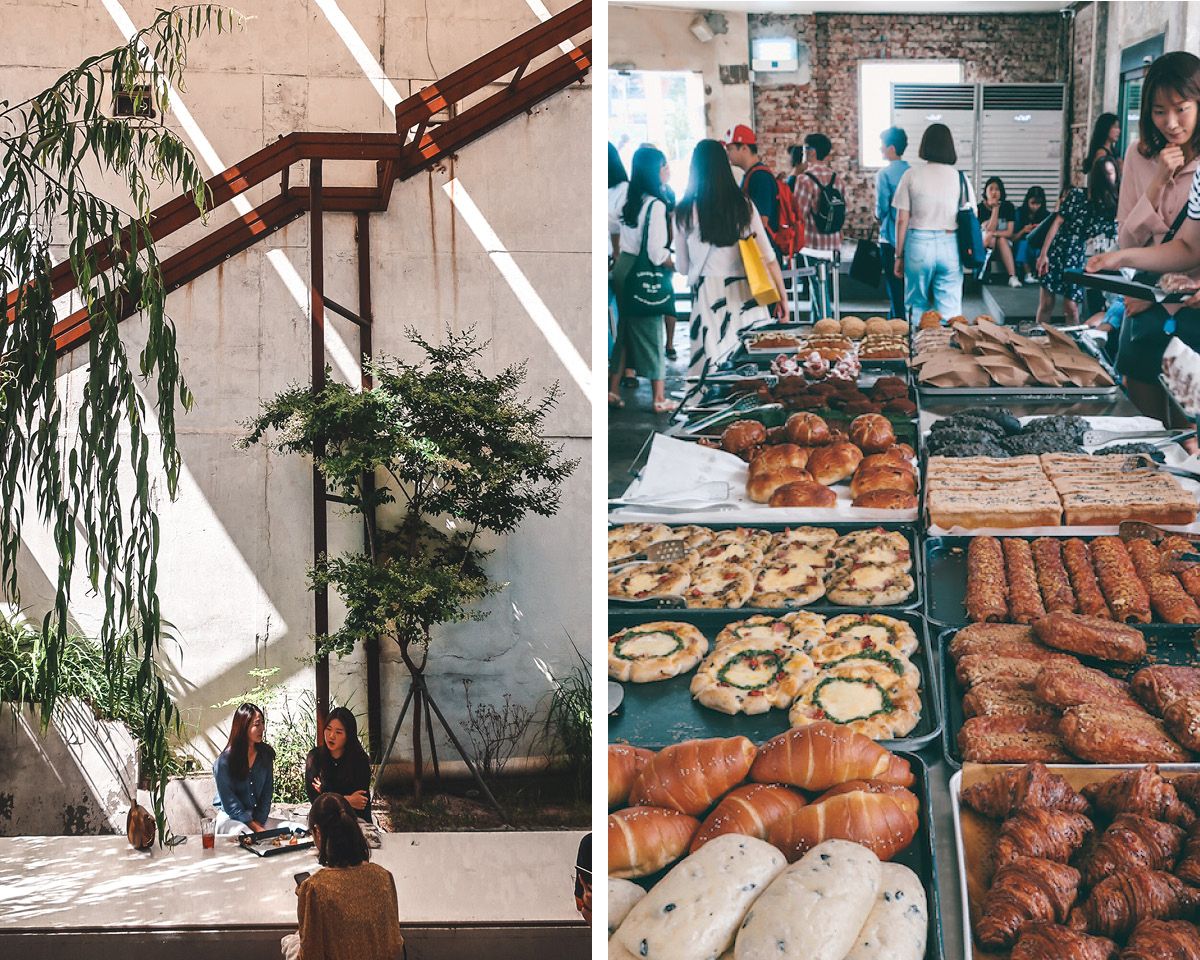
Seoul's coffee culture is like no other. Koreans are serious about their coffee, so much so that it has become the country's popular drink of choice.
Cafes in Seoul aren't your typical coffee joints where you get your caffeine fix and quietly do some remote work. They are social places where young people like to hang out and chat for hours on end. Special attention is placed on the aesthetic, vibe and music, giving each cafe a truly unique appeal. We found some incredible spots in former shoe factories, warehouses and artist workshops.
See our list of the 10 coolest cafes in Seoul .
We hope you enjoyed these unique gastronomic experiences and that they helped inspire your next trip!
Looking for more trip inspiration? Don't miss our list of other unique cultural experiences:
- 37 unique cultural experiences to inspire your next trip 🎨 ⛩️
Featured Posts
11 fun things to do in whistler in winter for non-skiers.
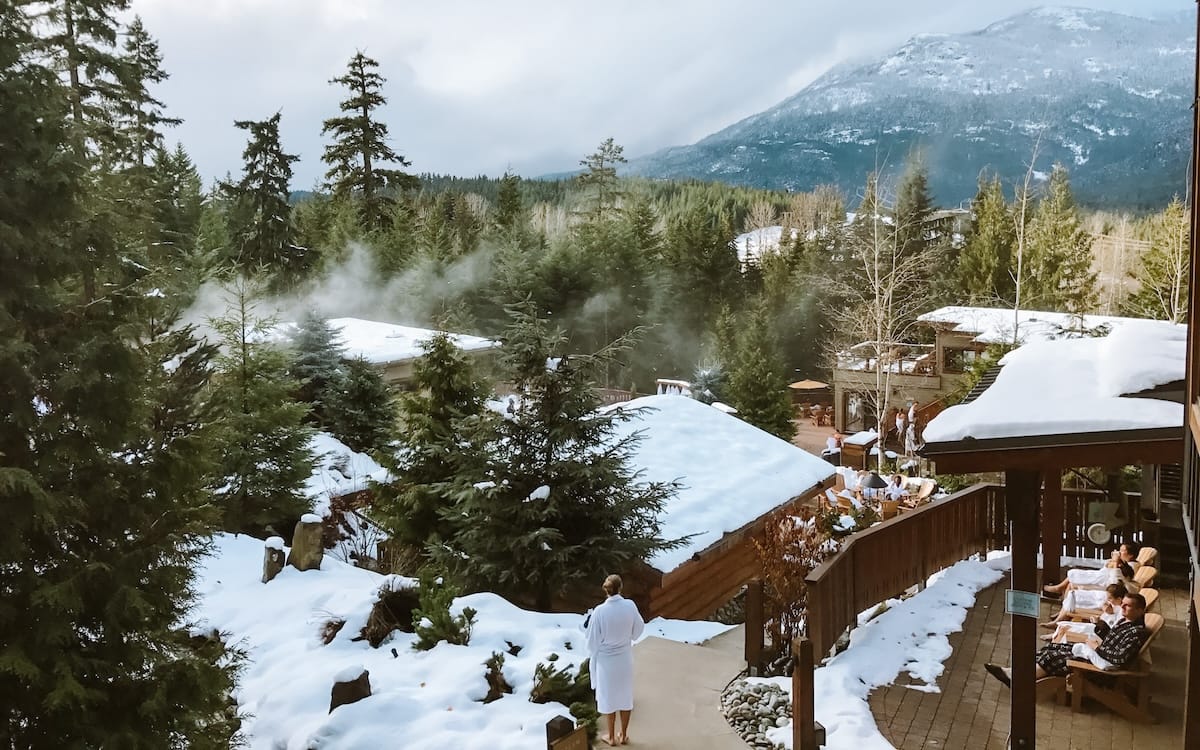
Whistler is absolutely worth visiting in winter if you're not skiing, with its exciting snow excursions, spas in nature, top-notch restaurants and apres-ski scene. We list 11 things to do in Whistler in winter for non skiers, from unique solo activities to fun experiences with your friends.
4 Day Nanaimo to Tofino Road Trip for Relaxation & Adventure
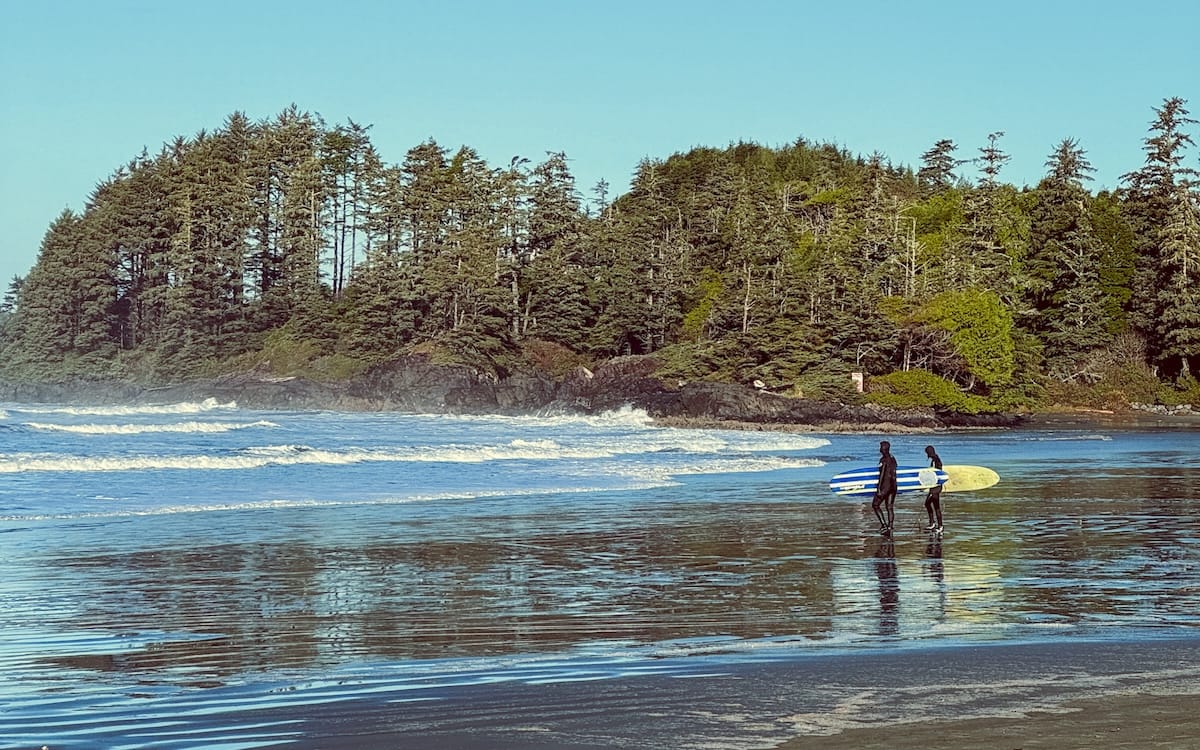
Our 4 Day Nanaimo to Tofino road trip offers a blend of relaxation and adventure with fun experiences, stunning natural sights and delicious coastal eats on beautiful Vancouver Island.
26 Best Restaurants on Salt Spring Island, British Columbia

Salt Spring Island is known for its sustainable farming and locally grown food. Fresh and organic ingredients combined with the island's creative flair make for some delicious spots. We list the 26 best restaurants on Salt Spring Island, each for a unique reason.
Search Groovy Mashed Potatoes - Travel Blog
- International edition
- Australia edition
- Europe edition
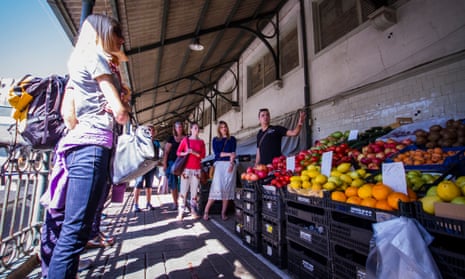

20 of the best food tours around the world
Feast your eyes on these foodie walking tours, which reveal the flavours – and culture – of cities from Lisbon to Lima, Havana to Hanoi
Taste Porto ’s tours are rooted in fundamental beliefs about the gastronomic scene in Portugal’s second city. First, Portuenses like to keep things simple: so, no fusion experiments. Second, it’s as much about the people behind the food, as the food itself. “Food is an expression of culture,” says US-born Carly Petracco, who founded Taste Porto in 2013 with her Porto-born husband Miguel and his childhood buddy André. “We like to show who’s doing the cooking, who’s serving the food, who’s supplying the ingredients, and so on.”
She’s good to her word. Walking the city with one of the six guides feels less like venue-hopping and more like dropping in for a catch-up with a series of food-loving, old friends. Everywhere you go (whether it’s the Loja dos Pastéis de Chaves cafe with its flaky pastries or the Flor de Congregados sandwich bar with its sublime slow-roasted pork special) the experience is as convivial as it is culinary. And it’s not just food either. Taste Porto runs a Vintage Tour option that includes a final stop at boutique wine store, Touriga , where the owner David will willingly pair your palate to the perfect port. Tours from €59pp, tours last 3-3½ hours, tasteporto.com Oliver Balch

A single espresso first thing on an empty stomach is the secret to a long and healthy life. So says 93-year-old Carlos Pina, whose father founded coffee roastery Negrita in 1924 and who still works there. One of only two roasteries left in Lisbon, Negrita is in a former stables in the Graça neighbourhood and has survived because the family own the building: elsewhere across the city rising rents are forcing decades-old businesses to close.
Graça and neighbouring Mouraria are still home to families who shop in local stores, making the two neighbourhoods ideal for Culinary Backstreets : its food tours aim to give visitors an insight into the city’s history and culture. After breathing in the scent of coffee and roasted spices at Negrita, the tour takes in a traditional cerveceria for plates of clams, velvet crab and prego (steak sandwich). Then there’s a shot of cherry liqueur at a local corner store and a takeaway grilled chicken eaten in the no-nonsense bar of a neighbourhood association – another fast-disappearing feature of old Lisbon .
A contrast to these insights into old Lisbon is tiny A Taberna do Mar , which opened in 2018 opposite the church and convent of Graça. Here chef-owner Filipe Rodrigues combines his love of Japanese techniques, Portuguese produce and a passion for sustainability to create inventive dishes. Try samples of horse mackerel bone broth and smoked sashimi of yellow fin tuna. Even the pudding, based on traditional egg custard, has a hint of sardine. At €25 the 10-course tasting menu is a bargain and worth booking if you have another night in the city. €115, tour lasts around 6 hours, culinarybackstreets.com Isabel Choat

An influx of creative talent and relatively affordable startup costs have meant the German capital’s restaurant scene has boomed in recent years. Per Meurling, the Swedish founder of Berlin Food Stories , and Liv Fleischhacker, a food writer and founder of Nosh Berlin , the city’s only Jewish food festival, are here to help sift through the glut of dining options. Tours kick off at Markthalle Neun , a refurbished food hall in the Kreuzberg area, and encompass everything from a look at Berlin’s thriving Turkish diaspora – with a stop for döner kebabs and other signature staples, of course – to German classics, such as eisbein (pickled ham hock) and königsberger klopse (veal meatballs in cream sauce) at Max & Moritz . The guides take turns leading tours but each offers insights on how the city’s history has helped shape its gastronomic present. €90pp, tours 3½ hours, berlinfoodstories.com Diana Hubbell
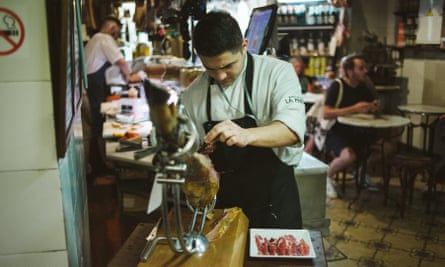
More than mere culinary tours, Devour Barcelona ’s small-group sojourns dive into the history and culture of the city – and steer travellers towards lesser-known local haunts. On a morning stroll on the Tastes & Traditions of Barcelona tour, visitors skip the hordes at Mercat de la Boqueria in favour of a more civilised breakfast of charcuterie, cheeses and cava at Bar Joan at Mercado de Santa Caterina . After more stops in the El Born neighbourhood, the tour winds toward Barceloneta for vermouth and bombas (meat-and-potato croquettes) at Bodega La Peninsular and squid ink-stained paella at Can Ramonet . In the evening, the Tapas, Taverns & History tour delves into everything from the Spanish inquisition to the city war. The exact stops vary depending on the guide but may include a visit to Bodega La Palma for cider-braised pork cheeks or a glass of red straight from the barrel with flash-fried anchovies and cumin-scented butifarra sausage at La Plata , a barebones tapas joint that was a favourite of the late Anthony Bourdain. T ours from €79pp, tours last 2½ to 3 ½ hours, devourbarcelonafoodtours.com DH

The first thing visitors note about Copenhagen is the vast number of bicycles: 43% of all commutes are done by bike. So, it is not surprising that visitors want to explore the city by bike, too. If you master the art of pedalling you should give Foods of Copenhagen ’s culinary bike tour a spin as it involves exploring the less touristy areas of Nørrebro and Refshaleøen.
Cindie Christiansen founded the company three years ago and she takes guests to the hippest places in town. A tour might include modern, open-faced sandwiches at Selma , desserts at Winterspring , hotdogs from Kejser Sausage at the Bridge Street Kitchen and fermented potato fries at Tapperiet Brus . It also includes local drinks, such as Nordic ciders at Rødder & Vin . Christiansen chooses places carefully, mixing street food and fine dining. All the food on the tour is consumed sitting down and eating a full dish rather than tastings. This makes for a longer tour but also for in-depth knowledge and a more sociable experience. £144pp including bike rental (which is yours for the full day), foodsofcopenhagen.com Andrea Bak
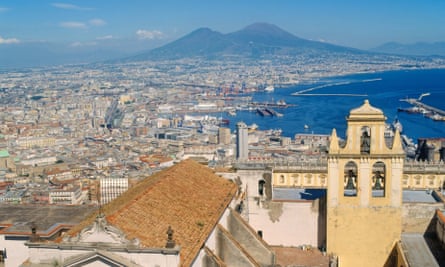
Despite its history and culinary traditions, an outdated reputation keeps Naples off some travellers’ Italian itineraries. Yet, Culinary Backstreets ’ tour – one of the newest among the company’s global offerings – illustrates just how much there is to discover in this hypnotic city. The tour begins outside the old city walls in Porta Capuana with a mid-morning espresso, rum baba and sweet, ricotta-filled sfogliatelle . Next up is a third-generation baccaleria for samples of salt cod, a “healing” glass of sulphuric water from Vesuvius, and a bruschetta-like snack in the city’s last traditional friselle bakery. The 10 stops on the five-hour tour offer much more than quick bites and photo-ops. The guides have fostered relationships with the bakers, vendors, and cooks who make this food scene unique, and this allows rare peeks into bakers’ ovens and chats with artisans. A stroll among the buzzing stalls of a local market highlights a slice of Naples in an area many visitors are unlikely to see. The tour also hits the “must-sees” – perfect for those on a tight schedule who don’t want to miss tasting a Sorbillo pizza or a shot of limoncello. €107 pp, tour 5 hours, culinarybackstreets.com Will Vibert

The Duchess of Palma – Nicoletta Lanza Tomasi – has a crash course in Sicilian cuisine and it begins with a tour of Palermo’s Mercado del Capo. “I didn’t realise I knew so much about the city’s history until I started teaching my cooking class to fund the upkeep of the palace,” she says, working between her favourite spice merchant, fishmonger, shouty fruit and veg traders and stalls stacked with bags of pasta.
Part food tour, part cooking masterclass, Cooking with the Duchess delves deep into the way Palermitans have eaten for centuries, from the Arab traders that first set up Mercado del Capo 1,000 years ago to the Jewish, Normans and Greeks that made this city the street-food capital of Europe. It also ends at Nicoletta’s home, the cacti-lined 18th-century Palazzo Lanza Tomasi – a palace on the city’s seafront, where the Duke’s father, author Giuseppe Tomasi di Lampedusa, once sat to write the iconic novel, Il Gattopardo (The Leopard).
“I have always cooked traditional, Sicilian dishes to preserve the heritage of the island,” says Nicoletta. The four-course menu changes seasonally but street-food inspired chickpea panelle , swordfish rolls and almond and pistachio pesto ruvidelli are examples of the recipes you can get hands on with in the palace kitchen, between herb foraging on the jasmine-laced terrazza and glasses of Sicilian wine. Then on to a tour of the palace and lunch with the Duke and Duchess in the grand banqueting hall. €146, butera28.it Anastasia Miari
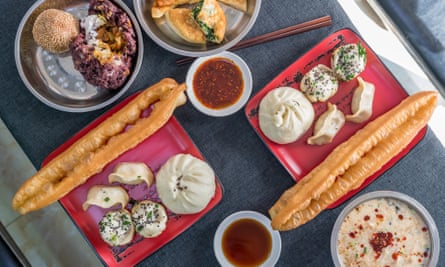
Untour ’s street eats breakfast tour starts with a tasting of three of Shanghai’s four most popular breakfast foods, collectively known as the “four heavenly kings”. There are crispy, oily, fried youtiao doughnuts, which are dipped into a freshly made sweetened soy milk that also helps wash down a dense cifantuan rice ball. This stodgy-and-satisfying Shanghainese dish combines white and red sticky rice, stuffed with salted duck egg and tart mustard pickles. These are enjoyed at Xiangcai Renjia, a Hunan-style restaurant that, in the morning, doubles as a breakfast joint, making use of the free seating to serve food made by the owners of the food stall next door.
Next, the tour moves to the Xiangyang Road area of the Former French Concession, where visitors can sample pancakes, steamed buns and dumplings, all served from tiny holes in the wall. The classic jianbing , or Chinese crepe, is a fitting substitute for the sesame pancake that is traditionally the fourth “heavenly” breakfast item. Jianbing, which is best enjoyed straight off the griddle folded around egg, fried wonton skin, pickles and spicy sauce, can be traced back 2,000 years to north-east China but is now popular across the country as an on-the-go breakfast.
Elsewhere, in a tiny sit-down place next door to the jianbing stall, there are rich and flavoursome pork-filled soup dumplings, served in a traditional bamboo steamer. Of course, breakfast in a city as cosmopolitan as Shanghai isn’t all about tradition: trendy coffee shops also serve western-style choices with Chinese characteristics. At Egg, a cafe on nearby Xiangyang North Road, taste the brownie topped with peanut and numbing Sichuan peppercorns for a tingly, sweet contrast to the morning’s savoury carb feast. £60pp, tour 3 hours , untourfoodtours.com Tess Humphrys

Despite its name, there is more to Little Adventures ’ Wonton-a-thon tour than just a sampling of Hong Kong’s iconic dumplings. Each itinerary is tailored to the tastes of the guests, and could include succulent roast goose or deftly carved duck; a dazzling array of dim sum in an old-school tea house; a jarring shot of snake wine; or learning the finer points of oolong appreciation with a celebrated tea master. Stops on recent tours include Lin Heung Kui and its array of morsels served from trolley-mounted steam tables and sizzling grills, or For Kee, a quintessential cha chaan teng , the Hong Kong equivalent of a greasy spoon diner, known for its pork chops. The tour is narrated by a member of the Little Adventures team, which includes founder and journalist Daisann McLane, a local chef, and some noted food writers. The guides are Cantonese-speaking culinary experts who beyond their infectious enthusiasm for the foods of the Fragrant Harbour – Hong Kong in Cantonese – share their encyclopaedic knowledge of the city they live in and love. £125pp for half-day tour for a group of three. littleadventuresinhongkong.com Vincent Vichit-Vadakan
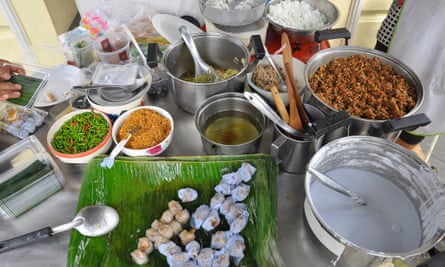
Skip the gloopy stir-fried noodles on the tourist-trap of Khao San Road and explore the intricacies of Thai cuisine with Chili Paste Tour’s Chin Chongtong, a charismatic guide who has called Bangkok home for more than 15 years. Her Chili Paste day tours through Banglamphu, an especially atmospheric neighbourhood in Bangkok, include a street-food breakfast in an alleyway lined with historic shophouses, a stop for young coconut ice-cream from a vendor that has been making it for more than seven decades, lunch with a chef who pounds all of her curry pastes by hand, and a foray into Pak Khlong Talad, Bangkok’s flower market. Meanwhile, the Thonburi Food & Art Walk ventures further off the beaten track to the side of the Chao Phraya River where few travellers go. Sample traditional Thai sweets at a shop that has been making them for 80 years and delicacies such as fried snakehead fish at Wang Lang Market. £57pp, tours up to 6 hours, foodtoursbangkok.com DH

No Footprints Mumbai ’s Khau Gully (street food walk) offers a condensed taste of the city’s street food, starting with the ubiquitous vada pao at the Aram vada pao stall at the grand CST railway station – serving spiced, mashed potato fritter, deep-fried, then pressed into pao (white bread) painted with chutney. A short saunter across is Mumbai’s oldest surviving eatery, Pancham Puriwala, a magnet for migrant labourers drawn to its fluffy puris and gravied potatoes.
In cacophonous Crawford Market, a five-minute walk away, is Badshah, serving its falooda (a colourful jumble of ice-cream, vermicelli noodles, jelly, rose syrup, nuts and basil seeds), the perfect cold drink for sun-charred Mumbai. Nearby is Kyani &Co, Mumbai’s oldest Irani cafe, specialising in all manner of meaty Parsi comestibles from masala-flecked mince to chicken patties to mutton cheese omelettes. Then onwards to Parsi Dairy Farm on Princess Street, purveyors of creamy kulfi (a sort of ice-cream made by simmering creamy milk for hours) and ghee-drenched sweetmeats.
On Chowpatty beach, honeycombed with food shacks, taste pao bhaji : mashed vegetables in a bath of butter, and bhel (potatoes, onions, puri, puffed rice, with a wash of sweet-sour and spicy chutneys), and a dusting of sev (hair-thin strands of fried chickpea flour) on top. Those more stern of stomach can visit the nearby restaurant Soam for the same dishes in more salubrious, air-conditioned environs. Then to the Babulnath dosa vendor for cheese-slicked dosa and spring “Chinese” dosa, the latter stuffed with capsicum, carrots, and skewered with soy and spicy schezwan sauce. The tour ends across the road at Dave Farsan Mart, home to superb vegetarian Gujarati snacks. Around £30pp , transport extra, t ours last 4 ½ -5 hours, nfpexplore.com Meher Mirza

Sangenjaya – known locally as Sancha – developed three centuries ago in Japan’s Edo period, and is named after the three teahouses that provided refreshment to pilgrims heading to the Grand Shrines of Ise. Today, little of that history remains but it has become known for its maze of narrow alleys, home to squat postwar buildings and the tiny restaurants, bars and cafes they contain.
The night-time tour by Tokyo Memories through the neighbourhood is led by Simon Berry, an Englishman who’s lived in Sangenjaya for the last decade. Berry guide guests through a couple of favourites: Takomasu, a street-side takoyaki (fried octopus ball) stall that sells takoyaki “sandwiches”; Ogata, where guests make monjayaki , a cabbage-filled pancake.
Then it’s into the alleys, to Omasu, a kushikatsu restaurant owned by baseball fanatic Yoshi-san (kushikatsu is deep fried skewers of meat and vegetables). It’s easy to get lost in these alleys but Berry navigates them confidently to Kiura, a sake bar behind a sliding door disguised as a shop’s back wall. After the oil-heavy kushikatsu, it’s a welcome change and a strong finish to the tour. The sake is refreshingly light and the food menu stretches from sashimi to a plate of lightly boiled, garlic-covered edamame. £100pp, tour 4 hours, tokyo-memories.com Oscar Boyd
Vientiane, Laos
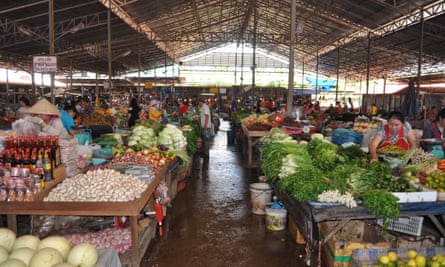
When the French settled into Vientiane amid the heat on the middle Mekong in 1893, they puffed on opium, before a smoking ban reignited colonial passion and planning. They resurrected the City of Sandalwood, razed by marauding Siamese in 1827, with French shuttered buildings, uprighted the broken Buddha effigies, and ventured south to plant coffee. Today, the Lao capital is perfumed with roasting coffee from the dozens of cafes in low-slung buildings drawing down to the river.
Tuk Tuk Safari guide Ere will take you by tuk tuk from the main streets to a stall where aproned ladies pour water through single-origin Lao coffee in cloth filters – producing an intensely earthy caffeine punch. Breakfast may be aromatic khao lam (sticky rice, coconut milk, and taro stuffed in bamboo), lifted off the coals by a family grilling 90 tubes in their front yard each morning. Then comes a lunch of kao piak sen (tapioca noodle soup with chicken, flavoured with kaffir lime leaves, galangal, garlic, lemongrass and padek; Lao fermented fish sauce), and then a trip to a tiny DIY green papaya salad roadside cafe where you’ll grind the chillis that give Lao’s fiery tham mak hoong its reputation. £60pp for full-day tour, tuktuksafari.com Claire Boobbyer
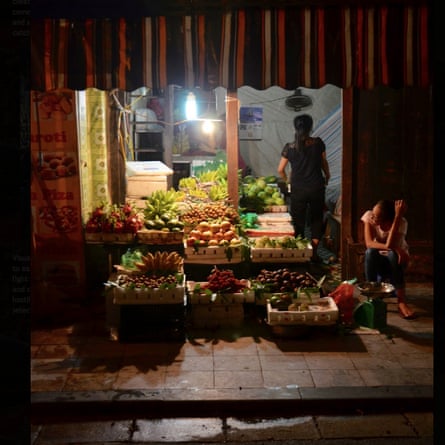
Once you love Vietnam, you’ll love its food forever, too. Aussie expat Mark Lowerson has loved it for 17 years and, along with partner Vang Cong Tu, navigates plastic-stool eating around town as Hanoi Street Food Tours . Mark explains colour and texture in Vietnamese food, talks of Chinese, French, and American influence on the country’s cuisine, and walks foodies through a wet market glistening with fish, and decodes the food offerings at temples while ambling through holy grounds. After bánh đa cá (soup made with tea-coloured noodles from Haiphong), and bánh cuốn (minced pork and wood-ear mushrooms in rice crepes, sprinkled with fried shallots) dipped in a sauce that balances salt, sweet, spice and sour flavours using ingredients such as chilli and kalamansi, the balance tips towards sweet. Take coffee in a tiny cafe where the floor is littered with pumpkin seed shells, and tuck into heavenly soft and chewy black fermented sticky rice with frozen yoghurt ( sữa chua nếp cẩm ). £75pp, tour 3 hours, streetfoodtourshanoi.blogspot.com CB
NORTH AND CENTRAL AMERICA, CUBA

Centuries of immigration have given the Big Apple one of the most diverse culinary scenes on the planet. Whether you’re craving Tibetan momos or Ecuadorian arepas , you’ll be able to find it in one of the city’s ethnic enclaves – provided you know where to look. Several times a month, Nosh Walks ’ Myra Alperson encourages travellers to ditch the hotdogs at Times Square and follow her instead on one of 35 neighbourhood walks in search of Sri Lankan curries in Staten Island or Georgian baked goods in Bay Ridge, or richly spiced Trinidadian dishes in the Bronx. Of particular note are her tours of Greenpoint, a historically Polish neighbourhood on the northern Brooklyn waterfront, in which participants swing by Acme Smoked Fish Factory, which is only open to the public one day a week, and Pyza, a traditional restaurant serving cheese blintzes worthy of a Polish grandmother. $54pp, tours from 3 hours, noshwalks.com DH
Mexico City

This city of eternal spring almost never sees a day without sun, so what better way to take a taco tour than by bicycle. El Taco Club leads small groups (up to 10) through the parks, art-deco buildings and colourful markets of the city’s chic Roma, Condesa and Polanco neighbourhoods to find delicious tacos at hole-in- the-wall taquerias and street stands.
The tour, which varies according to season and day of the week, might include a restaurant where patrons are serenaded by strolling musicians, offering a speciality of central Mexico, barbacoa , which is tender mutton wrapped in agave leaves and roasted in its own juices in an outdoor pit. Or a market stall serving cochinita pibil: slow-cooked suckling pig from the Yucatan marinated in a crimson chilli and achiote paste. A small street stand prepares brisket, tender enough to make any grandmother proud. And simple tacos done with tortillas made of fast disappearing heirloom varieties of corn and organic, locally grown avocados can be sampled at star chef Enrique Olvera’s Molino el Pujol . A visit to a traditional cantina is included to top the journey with a beer or mezcal. £48pp, includes folding bikes, helmets, food and beverages, tour 3 hours , eltaco.club Nicholas Gilman
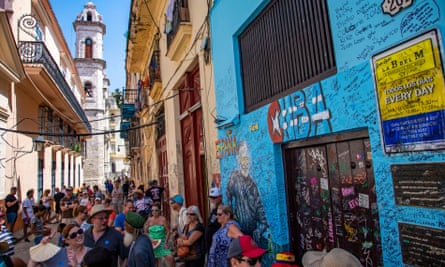
Taste for sugar in Cuba – a nation once rich from selling the sweet stuff – is embedded in the locals’ DNA. From ice-cream to milkshakes, churros and coconut delicacies to coffee sunk with teaspoons of crystals, and cakes fashioned in neon meringue, embrace the island’s candy choices. Irish-born Cubaphile Tanja Buwalda moved to Havana 10 years ago after running a restaurant in Cork. Starting a food blog to recount her travels and Cuban food experiences, she now runs food tours explaining how and where food comes from in Cuba, dual-currency hacks, how private front-room restaurants (paladares) source ingredients, and Cuba’s organic food revolution.
With Tanja, you’ll learn as much about Cuba’s contemporary food issues as you will about what the locals snack on. Try coffee from Habaneros’ windows – an espresso will cost 3p and will probably be dredged in sugar for Cuban tastes – slurp intense guarapo (sugarcane juice), and hunt for the best cookies, and creamy mamey milkshakes, across the city. While cruising around, admire the wedding-cake architecture built during the 20th-century sugar boom and sate savoury cravings as Tanja introduces you to her favourite hamburger joint. £103 for 2-8 people, excluding transport and snacks, contact Tanja.Buwalda at gmail.com CB
SOUTH AMERICA

If you are looking for a way to make an already exciting food scene even more edgy try the Ruta del Callao gastro tour. Callao is Lima’s port, and has its own flavour (musically it prefers salsa to cumbía) and though it has some of the city’s most crime-ridden neighbourhoods – it also has some of its most lip-smacking seafood. Callao is one of the best spots on Peru’s 2,414km coastline to eat ceviche, and Freddy Alarcón’s Combi Roja (red van) is one of the places to try Peru’s flagship dish. Freddy has been cooking on wheels for more than 30 years. With ready smile he can prepare a hake ceviche at lightning speed and diners can sit and eat in the specially adapted van on fake leather seats.
Next stop is El Colorao de Chucuito, run by Andrés Angeles, a former merchant marine who has created 20 of his own dishes. His specialities are muchame de atún , layers of dried tuna fish served with avocado and olive oil, and swordfish in sea snail sauce. In Callao all roads lead to La Punta, a peninsula that juts out into the Pacific, lined with pastel-hued art-deco homes. At its end is Don Giuseppe’s eponymous eatery, owned by an older Genoa-born seaman who met his love on the Peruvian coast and decided to stay. His restaurant is famous for its pan con pejerrey, a crispy fried fish sandwich. Returning from the furthest point of the tour stop off at Kala Tanta, a bakery run by social entrepreneurs Andrés Ugaz and Gaby Wuest who created the tour. Learn to make bread and see how promoting Callao’s gastronomy is tackling crime and youth unemployment. To take the tour contact gabyseptember at yahoo.com or call +51 943209365, the tour takes 4 hours and departs from 10 hotels across Lima Dan Collyns

“This is where Bogotá’s top chefs come shopping,” says Foodies Colombia guide and chef Juliana Salazar, browsing Paloquemao market’s stalls for fruity tropical bounties such as guanábana (soursop), feijoa, pitahaya (dragonfruit) and lulo piled up in perfect pyramids. Colombians have started appreciating the natural bounty of the world’s second-most biodiverse country and flock to the city’s best-stocked mercado.
Street-food kiosks serving local dishes have also grown in popularity and, besides trying a rainbow assortment of sweet natural treats at the Fruti Fruti stand, Juliana gives the lowdown on dishes made by Paloquemao’s finest purveyors. Doña Aurora’s chicken and “meat” tamal tolimense (from Tolima) is described as great hangover fodder, while warm cheesy pandebono rolls and avena (a chilled oatmeal and vanilla drink) are breakfast staples at Pandebonitos de la virgen. Paloquemao’s street-food queen, however, is Doña Rosalba; on Sundays, she sells 2,000 portions of lechona , slow-cooked pork with dried peas and rice that are mixed back into the hog and served with crackling and a white corn arepa. Leave room to sample one last dish – traditional chicken and three-potato Colombian soup ajiaco – finishing the four-hour eating tour totally sated. From £47pp, private groups from two to 16 people , foodies.com.co Sorrel Moseley-Williams
Buenos Aires
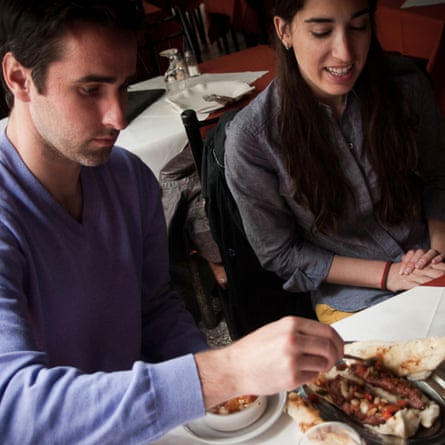
“Asado means uniting: I’d never eat barbecue on my own because it celebrates family and friends,” says Parrilla Tour guide Antonella Saragó at the first of four restaurant stops. Besides pushing waistline boundaries with abundant servings of meat, this three-hour walking tour also opens the doors to unexpected Buenos Aires corners, revealing low-profile but authentic bodegones (taverns) and steakhouses in Palermo and San Telmo.
The first mouthful is legendary Argentine hot sausage sandwich choripán , taken at 120-year-old La Cañita, a former store dating back to when sugar cane grew in this neighbourhood. Unusually, La Cañita’s chori is made from beef rather than pork and homemade chimichurri sauce is the standard topping. Next is pizzeria La Guitarrita (though it also serves empanadas). Here, hand-cut whole-knuckle beef pasties win out over pies, paired with fragrant Torrontés white wine.
The real parrilla deal is revealed at stop three. The sign on this secret spot’s door says “ cerrado” (closed) but Antonella knows better. Here, asador Albertito Odetti tends to slabs of Argentina’s prized beef, grill hood decorated with swirly fileteado letters. It’s a legit hole in the wall, with star dishes scrawled on A4 and stuck to windows; there’s puffy provoleta (cheese), hand-cut chips, malbec and a token salad, which are worthy companions to 800g of medium-rare bife de chorizo and entraña (to share). It all concludes with dulce de leche ice-cream at Persicco . From £66 , 3-hour tour, parrillatour.com SMW
Looking for a holiday with a difference? Browse Guardian Holidays to see a range of fantastic trips
- Food and drink
- Cultural trips
- Walking holidays
- Heritage (Travel)
- Restaurants (Travel)
- Restaurants (Food)
Comments (…)
Most viewed.
- Greek Islands
- Greece FAQs
- Italian Islands
- November 2023
- February 2023
- August 2022
- January 2022
- December 2021
- October 2021
- September 2021
- August 2021
- Destinations
- Family Holidays
- Gastronomy Tourism
- Holiday Accommodations
- Netherlands

Gastronomy Tourism – What is it and why are we so excited about it?
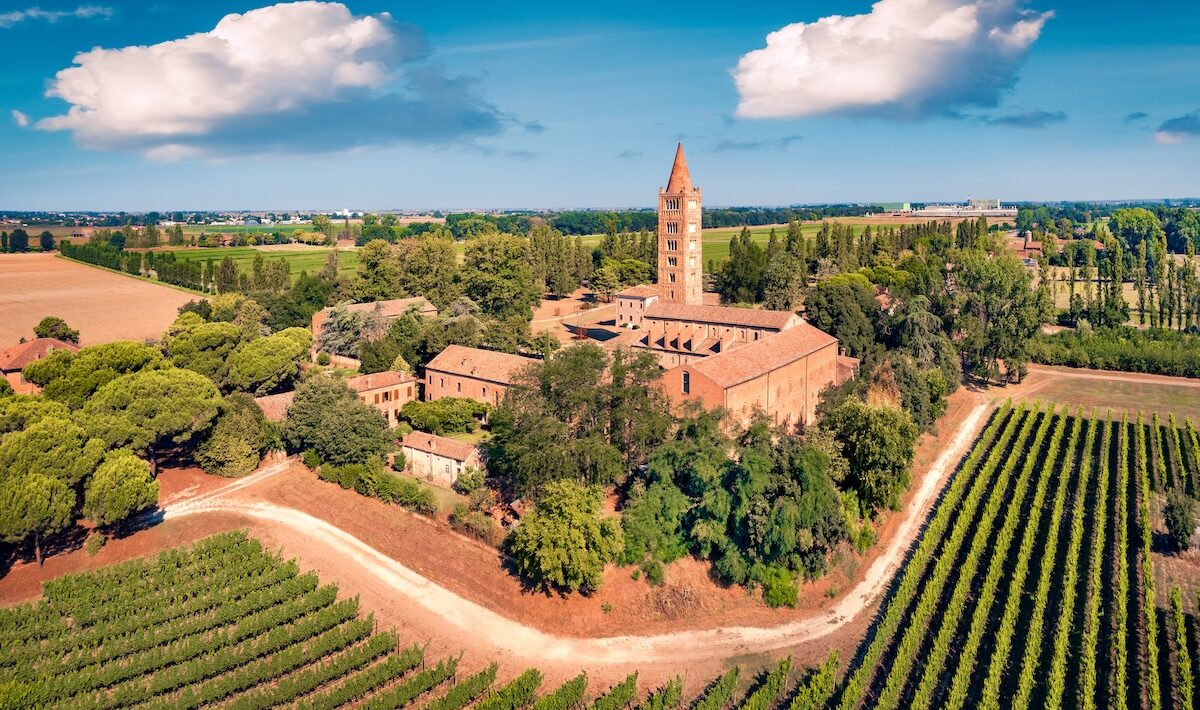
As the clocks change in the UK our thoughts turn to next summer and future holidays. Our combined love of food/drink and travel got us thinking about travelling just to experience food and drink, er experiences. The fancy name is ‘ Gastronomy Tourism ’ or if you want to skip the food and focus on the wine, it would be called’ enotourism.’
What is Gastronomy Tourism?
- What is EnoTourism?
Is Food Tourism a new thing?
- Wine Tasting in Bordeaux, France
- Cooking Up Pasta in Tuscany, Italy
- Tapas Crawl in Barcelona, Spain
- Seafood Journey in Scotland
Examples of Gastronomy Tourism Holidays
Let’s have a quick look at these terms then jump into what it *actually* means for our travel plans into 2024.
Gastronomy tourism, or “food tourism” as it’s often called, is a growing trend where the main attraction is—you guessed it—food and drink. Forget just grabbing a quick bite to eat; this type of holiday is all about diving into the local food scene. Whether it’s wine tasting in France, enjoying a seafood feast in Greece , or taking a cooking class in Italy, food tourism is all about making the most of what’s on your plate and in your glass. Think Rick Stein’s long weekends where the agenda and location are dictated by the food and drink.
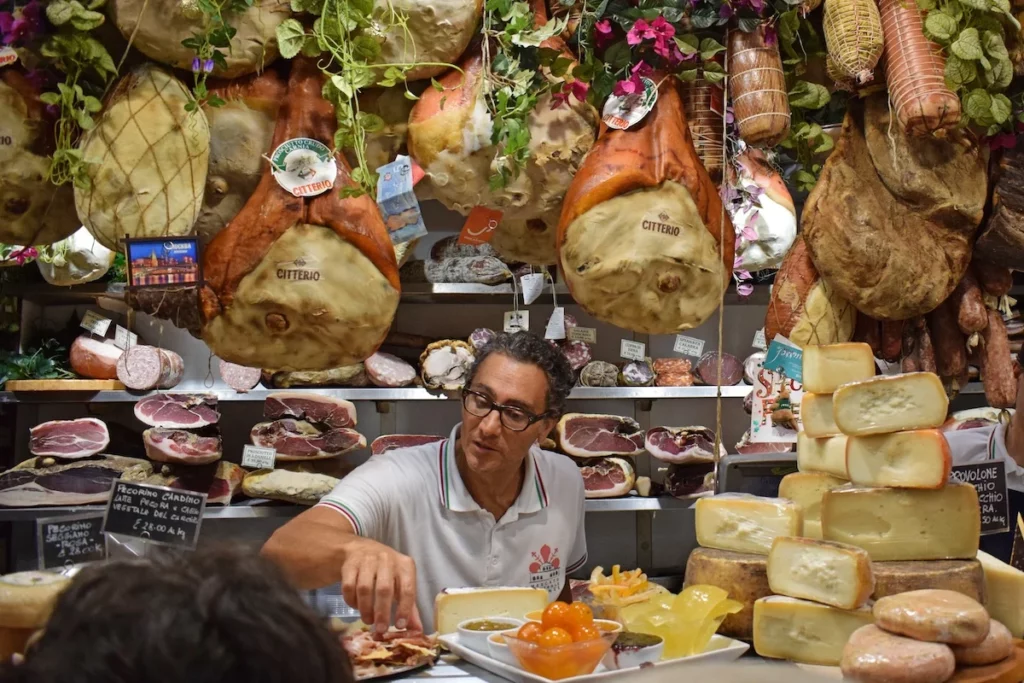
What is Enotourism?
In enotourism, travellers typically visit vineyards and wineries where they can tour the facilities, learn about the winemaking process, and, of course, sample a variety of wines. These trips often include guided tastings led by experts who can explain the different types of grapes, the characteristics of wines from different regions, and the art of pairing wine with food.
Popular destinations for enotourism in Europe include Bordeaux in France, La Rioja in Spain, and Tuscany in Italy. These regions offer not just a wide variety of wines but also stunning landscapes and rich local history, making the trip a multi-sensory experience.
Travelling for food isn’t a new idea. Places like France and Italy have always been hotspots for food lovers. So, what’s different now? Well, food is no longer just a part of the trip; it’s often the main reason people are travelling. Social media has really boosted this trend, with foodie posts inspiring us to try new dishes and visit far-off places. Plus, there’s a bigger focus on local and sustainable food, meaning travellers want to go beyond just eating—they want to know where their food comes from and how it’s made.
1. Wine Tasting in Bordeaux, France
Spend your days visiting famous vineyards and your evenings enjoying top-notch French dishes. A trip to Château Margaux is a good place to start, taste the wine and finish off with a Michelin Starred dinner at Restaurant Soléna in the centre of town. As you might expect from a gastronomy hotspot, the menu is pretty rich – we hear the Blue Lobster (Le Homard Bleu), The Beef (Filet de Boeuf) are good choices. If meat isn’t your thing, you could try Restaurant Akashi, another Michelin Starred restaurant with a great vegetarian menu. We’re eyeing up the Salad of old tomatoes, burrata and pistachios (Salade de tomates anciennes, burrata et pistaches) and the Green asparagus, orange and ginger vinaigrette (Asperges vertes, vinaigrette à l’orange et au gingembre) if it is in season.
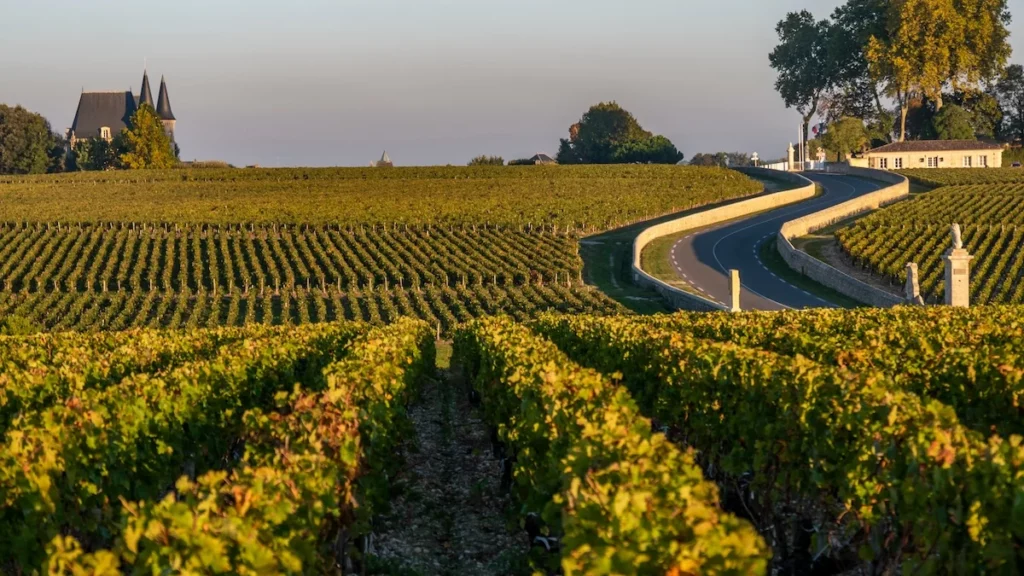
There are 20 Michelin Starred restaurants in Bordeaux so there is plenty to choose from. Many of the major Chateaux also offer accommodation. Château Cordeillan-Bages for example (owned by the same family that own Château Lynch-Bages ) is a converted Catholic Monestary that has been a luxury hotel since the late Eighties.
2. Cooking Up Pasta in Tuscany, Italy
Located in central Italy , Tuscany has long been a foodie destination. For an authentic pasta experience you can check into any number of farmhouses, or wineries to get your hands on some pasta. We hear great things about Tenuta di Spannocchia that offers many different gastronomic experiences including pasta cooking, olive oil tastings and wine tastings. After a busy day ‘trying’ the local wine and pasta you can sleep it off in one of their comfortable rooms or small apartments.
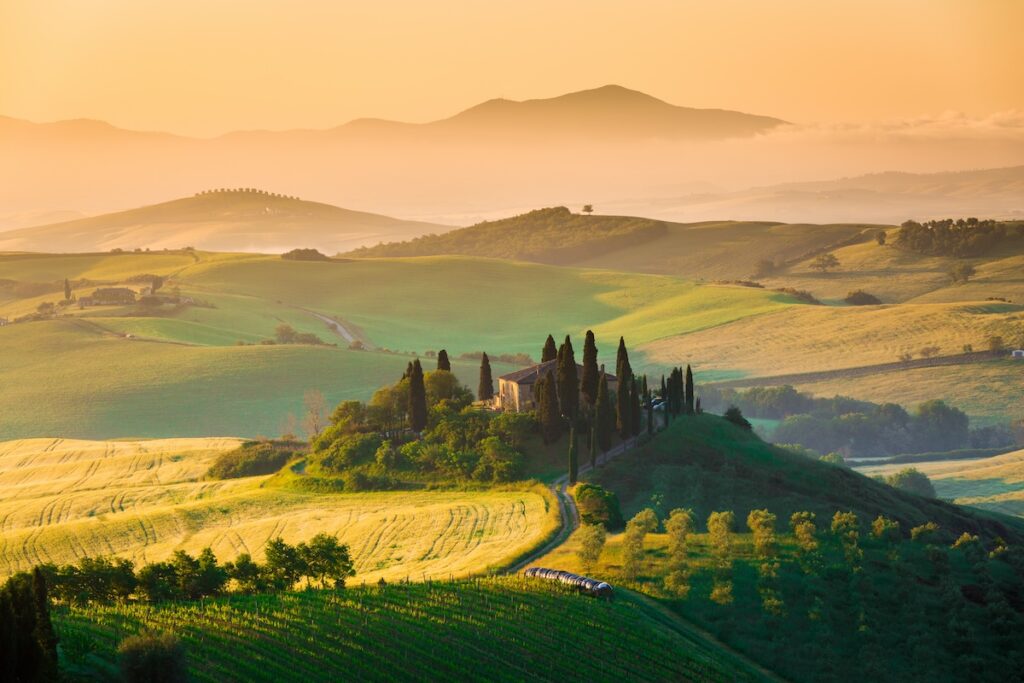
It is worth noting that these ‘farmhouses’ are pretty swanky affairs but if you want to add more wine focus then consider pasta cooking at Fattoria di Montemasso , a family owned winery in the Chianti Classico region. Yes there is a whole region named after a wine (or is it the other way around?)
Note that the Italian word for ‘wineries’ would be ‘vigneto.’ Now you know, vigneto’ – just drop the g so you don’t sound like a tourist! (vee-nyeh-toh.)
When in Tuscany do try the local pasta speciality. Pici are thick, hand-rolled noodles that are typically made with semolina flour and water, often served with a simple tomato or meat sauce.
3. Tapas Crawl in Barcelona, Spain
The Catalan capital offers hundreds of different tapas restaurants giving you endless options for a tapas crawl. At each restaurant you stop for a dish or two before continuing onto the next location. You may start with Patatas bravas, Croquetas de jamón or Gambas al ajillo before moving onto Queso manchego and Padrón peppers before ending with Escalivada (grilled vegetables) or Chorizo al infierno (chorizo sausage in a spicy sauce.) The number of dishes and restaurants.
Whilst the phrase is interchangeable you probably want to find Tapas Bars that are smaller and more intimate than the larger often upscale Tapas restaurants.
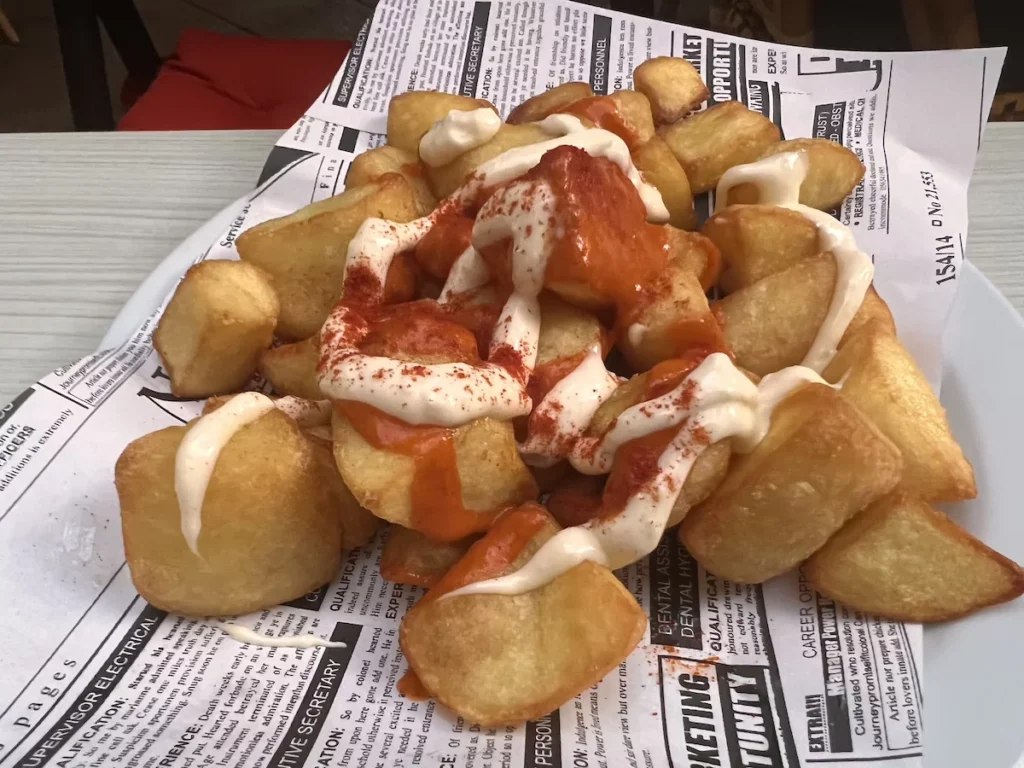
We enjoyed Restaurante Mateo – Tapas y Cerveza on our last trip, tucked away in a little corner of the Gothic Quarter, but there are so many more to try! There is no official route for your gastronomic tour but you can ask your hotel (or Google) for maps and suggestions, or follow your nose and see what you can find!
4. Seafood Journey in Scotland
Take a trip along Scotland’s coast to try some of the freshest seafood around.
There are many places to choose from, including Arbroath for smoked Haddock, Edinburgh for Michelin Starred restaurants like Martin Wishart and the Kitchin or The Isle of Skye for fresh oysters, scallops, and langoustines. Or you could build a full gastronomic holiday in the Argyll and Bute region, home to renowned seafood destinations like Oban, Tarbert, and Lochgilphead.

Head to Loch Fyne for Oysters, The Seafood Shack in Oban for fresh seafood, The Argyll bakers for freshly baked goods or Isle of Mull Cheese for… well you can work it out! The Kilchrenan inn near Oban makes the perfect base to explore the local food scene for a few days.
Gastronomy Tourism offers a unique way to get to know a place, through its flavours and food traditions. It’s not just about eating; it’s about experiencing a place with all your senses. As a team of foodies, we are excited about making gastro tourism the focus of our next travels, So, if you’re planning your next holiday and you’re a bit of a foodie, why not make food the main event?
Jay is the founder of Wine Travel & Song and contributor to Virtual Wanderlust. A published writer and photographer, Jay is an extensive traveller, a passionate music fan but an average cook. He loves the Eagles , U2 , Genesis and Pink Floyd. A trusted Google Local Guide & TripAdvisor Superstar , Jay's travel photos have been seen over 26 million times and counting!
Related Posts More From Author
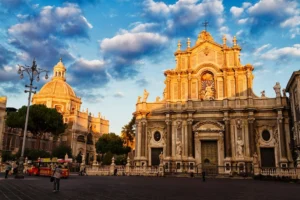
Catania Travel Guide 2024

Agrigento Travel Guide 2024
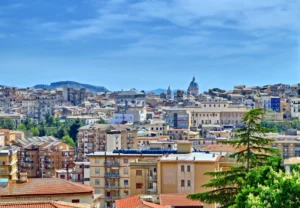
Caltanissetta Travel Guide 2024

Movies & Shows set in Sicily
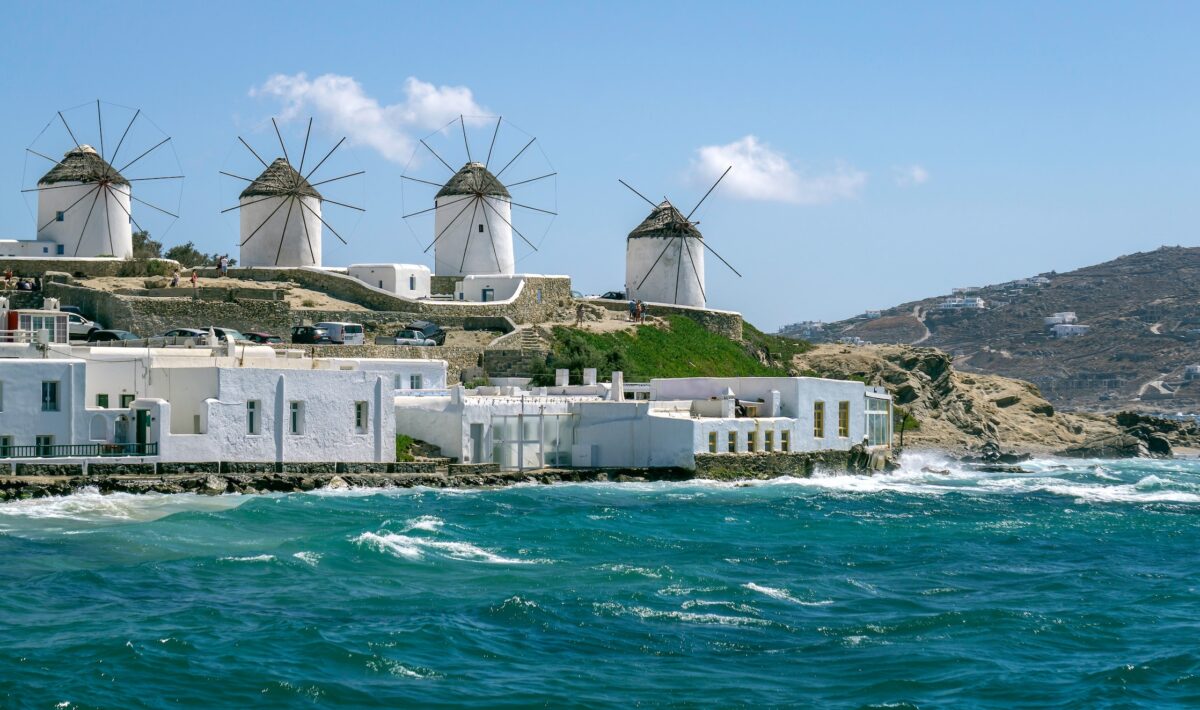
Your Ultimate Mykonos Holidays Guide

Your Ultimate Santorini Holidays Guide
Gastro-tourism: a hotelier's guide to a delectable travel trend
When people decide to travel, they choose their destination for a variety of reasons. While some people hope to go on traditional vacations, many want to board a plane to try something new .
Travel enthusiasts now chase down to the perfect trip by checking out the cuisine in different regions. It's a trend called gastro-tourism, which encourages people to roam the world for the next great dish that makes their taste buds sing.
Read this guide to gastro-tourism, a delectable travel trend!
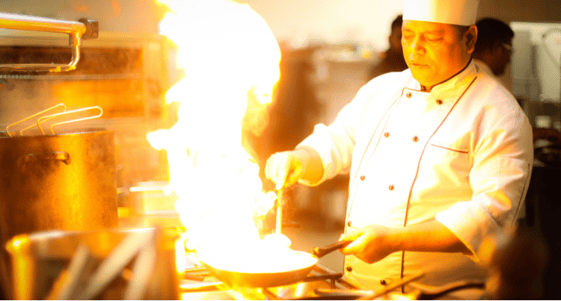
In total, tourism accounts for more than 10% of the global economy, and f ood experiences are an excellent way for people to bond while they're away from home.
Encourage your guests to indulge their senses in local foods, so that they don't have to stop their culinary adventures when they head to your hotel for the night.
Couples want classes
After people get away from home, they want to create special memories with the ones they love. That's why so many couples escape to a dreamy destination and sign up for classes they can do on their own. It gives them an experience they can treasure, like immersive cultural cooking classes.
When couples try to cook something new together, they reinforce skills like communication and teamwork. Then they get to eat something incredible and bask in their success. They'll look back on the class with fondness, which is why hotels have begun to offer cooking lessons for couples, right on their property.
Hoteliers can hire a professional chef to visit a couple of times a week and host a couples' cooking class at a discounted price for guests. It's something your competitors may not offer, which gives your property more appeal to first-time visitors and shows that management cares about creating a fun environment.
People like watching food preparation
Technology has created a world where brands seem more transparent than ever. They establish social media profiles to talk with customers on a personal level, so it's natural for people to expect transparency in other ways. Hotels can let guests peek behind the scenes by creating open floor plans in the dining area.
Let guests watch in-house chefs craft their meals. They'll love learning how their food gets to their table almost as much as tasting it for the first time. It's part of the culinary experience that rounds out any meal.
.png?width=600&name=Typsy%20%20We%20teach%20hospitality%20to%20the%20world%20%20typsy.com%20blog%20banner%20_%20(1).png)
Tourists chase chocolate treats
New cultural or regional foods win people over every day, but chocolate is always a crowd favorite. It's a lifelong comfort food for many – their first choice when they want a snack or dessert. People travel to taste it in new dishes all the time so that hotels can jump into this trend with ease.
There are a few ways hoteliers can offer more chocolate treats for guests beyond the room service menu. Leave individually wrapped pieces in rooms to welcome new arrivals, or go bigger to transform your property into a foodie's paradise.
Some hotels have begun featuring a trained chocolatier to design gourmet sweets when guests walk up to their counter. Build a restaurant specifically for chocolate creations to make your hotel a landmark in the gastro-tourism world. You'll get guests who travel for the experience and win others over who wander in out of curiosity.
Research local cuisine
Before you jump into any projects, research the local cuisine in your area to figure out what people want to eat. Find the most popular restaurants and dishes, then update your amenities by bringing in gourmet chocolatiers or renovating your in-house kitchen. Food lovers will adore property updates like these because they create new options for their culinary travels.
Remember: people travel for experiences they can’t get at home. Encouraging guests to indulge their foodie heart’s desire is a great way to create a memorable experience for them – one that just might see them come back.
You might also like
Topics: Hospitality marketing , Hotels , Hospitality managers
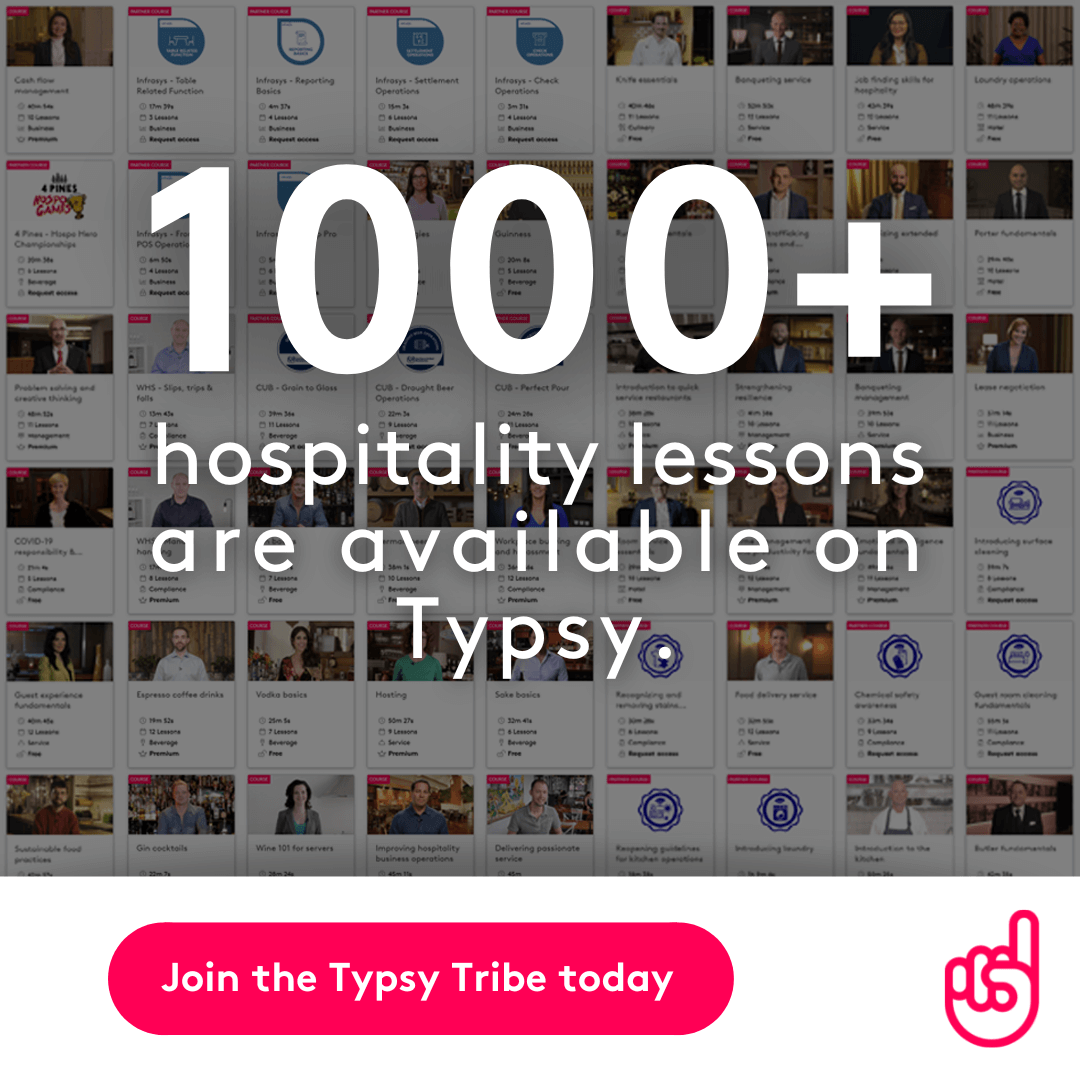
About Typsy
Browse by category
- Case studies (7)
- COVID-19 (41)
- cybersecurity (1)
- Expert Q&A (10)
- Health and wellbeing (49)
- Hospitality career tips (108)
- hospitality courses (1)
- Hospitality insights (158)
- Hospitality managers (314)
- Hospitality marketing (134)
- Hospitality operations (109)
- hospitality recruitment (1)
- hospitality skills shortage (8)
- Hospitality staff (188)
- hospitality technology (1)
- Hospitality training (103)
- Hospitality trends (11)
- Hotels (259)
- onboarding (1)
- online hospitality training (2)
- Restaurants (292)
- Schools (23)
- Travel & tourism (4)
- Typsy updates (101)
Recent posts
Search this blog.
- There are no suggestions because the search field is empty.

Find the right Typsy plan for you
For job seekers, casual workers, university students, travelers and career builders, for businesses and teams of any size.

- BBA Public Accounting
- BBA General Business
- BBA Finance
- BBA Management
- BBA Marketing
- BBA Risk Management & Insurance
- Master of Business Administration (MBA)
- Certificate in Accounting
- Certificate in Banking & Financial Services
- Certificate in Financial Literacy
- Certificate in Financial Technology & Cybercrime
- Certificate in Global Supply Chain Management
- Graduate Certificate in Functions of Business
- BS Child & Family Studies – Child Development
- Certificate in Early Childhood Director
- Certificate in Family Services
- Certificate in Infant/Toddler Care and Education
- BA Communication Studies
- Certificate in Communication Studies
- Certificate in Dispute Resolution
- Certificate in Communication in the Workplace
- MS Computer Science
- Certificate in Artificial Intelligence in Data Science
- Certificate in Cybersecurity and Digital Forensics
- Certificate in Game Design
- AA Police Studies
- BS Corrections & Juvenile Justice Studies
- BS Criminal Justice
- BS Police Studies
- MS Criminal Justice Policy & Leadership
- Certificate in Correctional Intervention Strategies
- Certificate in Juvenile Justice
- BS in Elementary Education
- MAEd Master of Arts in Education
- MAT Master of Arts in Teaching
- EdS Specialist in Education
- AS Paramedicine
- BS Emergency Medical Care — Emergency Services Administration
- BS Emergency Medical Care — Fire Service
- BS Fire, Arson & Explosion Investigation
- BS Fire Protection Administration
- BS Fire Protection & Safety Engineering Technology
- Certificate in Industrial Fire Protection
- AA General Studies
- BA General Studies
- BS Health Services Administration
- BS Homeland Security
- MS Safety, Security & Emergency Management
- Certificate in Homeland Security
- Certificate in Security Management
- BS Global Hospitality and Tourism
- Undergraduate Certificate in Gastronomic Tourism
- Undergraduate Certificate in Sustainable Hospitality
- MS Instructional Design & Learning Technology
- Graduate Certificate in Online Learning Design
- Graduate Certificate in User Experience Design
- MS Nursing – Rural Health Family Nurse Practitioner
- MS Nursing – Psychiatric Mental Health Nurse Practitioner
- DNP Post-MSN DNP
- Post-MSN Certificate – Family Nurse Practitioner
- Post-MSN Certificate – Psychiatric Mental Health Nurse Practitioner
- BS Occupational Safety
- MS in Safety, Security & Emergency Management
- Graduate Certificate Construction Safety
- Graduate Certificate in Cyber & Security Management
- Graduate Certificate in Emergency Management & Disaster Resilience
- Graduate Certificate in Occupational Safety
- Graduate Certificate in Safety Leadership & Management
- Certificate in Social Intelligence & Leadership
- Bachelor’s to OTD
- Master’s to OTD
- AAS Paralegal Studies
- BA Paralegal Science
- Post-Baccalaureate Certificate in Paralegal Science
- BA Political Science
- BS Psychology
- Certificate in Veterans Studies
- MS Psychology-Applied Behavior Analysis
- MS Industrial Organizational Psychology
- Graduate Certificate in Psychology — Applied Behavior Analysis
- MPA Public Administration
- Certificate in Community Development
- Certificate in Emergency Management & Disaster Resilience
- Certificate in Applied Policy
- Certificate in Non-Profit Management
- Master of Public Health – Health Promotion
- BSW Social Work
- MSW Social Work
- Certificate in Addictions Intervention
- Certificate in Child & Family Services
- Certificate in Leadership & Management
- Certificate in Mental Health
- Certificate in Social Advocacy & Justice
- BS Sport Management
- See All Programs
- Types of Financial Aid
- Applying for Financial Aid
- Understanding Financial Aid
- Financial Aid Policies
- Scholarships
- How to Apply
- Application Deadlines
- Admission Requirements
- Transfer Students
- Transfer from KCTCS
- Visiting & Non-Degree Seeking Students
- Corporate Educational Partnerships
- State Authorization & Professional Licensing Information
- Student Resources
- Faculty Resources
- Online Military Students
- BBA Risk Management & Insurance
- BS Child & Family Studies – Child Development
- BS Corrections & Juvenile Justice Studies
- MS Criminal Justice Policy & Leadership
- BS Fire, Arson & Explosion Investigation
- BS Fire Protection & Safety Engineering Technology
- MS Safety, Security & Emergency Management
- MS Instructional Design & Learning Technology
- MS in Safety, Security & Emergency Management
- Graduate Certificate in Cyber & Security Management
- Graduate Certificate in Emergency Management & Disaster Resilience
- Graduate Certificate in Safety Leadership & Management
- Certificate in Social Intelligence & Leadership
- Certificate in Emergency Management & Disaster Resilience
- Certificate in Child & Family Services
- Certificate in Leadership & Management
- Certificate in Social Advocacy & Justice
What is Gastronomic Tourism?
Humans need food to survive. It provides us with key nutrients that are essential to daily functioning and wellbeing. But food is more than nutrition. Food reminds us of family dinners. It makes us happy when we are sad. It introduces us to different cultures. Gastronomic tourism draws from these psychosocial factors.
The United Nations World Travel Organization (UNWTO) defines gastronomy tourism as a “type of tourism activity which is characterized by the visitor’s experience linked with food and related products and activities while travelling.” Gastronomic tourism can include venues like wine tours, distillery tours, culinary tours, and farm tours. These types of tours are growing rapidly around the world. According to a study published in 2013, nearly “39 million United States leisure travelers choose a destination based on the availability of culinary activities”. Those who don’t choose the destination based on culinary activities will seek specific culinary activities after the destination is decided upon.
Gastronomic tourism is perfectly suited to meet the needs of age and culturally diverse individuals. Food is uniquely suited to promoting individual cultures and bringing people from diverse backgrounds together. For example, visitors to Poznan, Poland each October and November can experience Saint Martin’s Croissant Feast. During this time, bakeries throughout the city create croissants topped with a sugar glaze. This event has thrilled locals and visitors since at least 1860. Not only can visitors get a glimpse of Polish culture, but the purchase of croissants supports the economy and creates jobs for the local people.
No matter where you live, you can develop a gastronomic tour. Perhaps you start with highlighting the food and beverage restaurants in your local area. You might even create a specific date each month to bring local food trucks together with live music. Whatever you can imagine, you can create. Gastronomic tourism provides an opportunity to turn your passion for food, spirits and culture into an exciting and rewarding career.
Earn your online bachelor’s degree from a regionally accredited university that has been an online education leader for more than 15 years. Complete the form to learn more about how you can earn your bachelor’s in global hospitality and tourism and pick up an in-demand certificate in gastronomic tourism or sustainable hospitality along the way, giving yourself a competitive edge in the job market. Contact us today to get started.
By: Karina Christopher, PhD, RD, LD, associate professor, EKU Department of Applied Human Sciences
Exploring the Essence of Gastronomic Tourism and Its Distribution Channels in Greece
- Conference paper
- First Online: 12 February 2020
- Cite this conference paper

- Katsoni Vicky 3
Part of the book series: Springer Proceedings in Business and Economics ((SPBE))
1167 Accesses
1 Citations
Culinary culture has always been the longest-surviving part of a culture and tradition since it reflects daily life styles, religious beliefs, habits, traditions and customs. Gastronomy tourism has become a major and rapidly growing component of the attractiveness of tourism destination in recent years, as it is another treasure of cultural heritage. Greece boasts a fascinating gastronomic culture, thanks to a plethora of artisanal products, distinctive regional cuisines of over 4000 years of cultural heritage. This paper explores the basic principles of gastronomic tourism and investigates the way Greek Gastronomic tourism should be managed, in cooperation and coordination with both public and private tourism stakeholders, through carefully designed promotional activities in a variety of distribution channels.
This is a preview of subscription content, log in via an institution to check access.
Access this chapter
- Available as PDF
- Read on any device
- Instant download
- Own it forever
- Available as EPUB and PDF
- Compact, lightweight edition
- Dispatched in 3 to 5 business days
- Free shipping worldwide - see info
- Durable hardcover edition
Tax calculation will be finalised at checkout
Purchases are for personal use only
Institutional subscriptions
Alonso, A. D., & Liu, Y. (2011). The potential for marrying local gastronomy and wine: The case of the fortunate islands. International Journal of Hospitality Management, 30 , 974–981.
Article Google Scholar
Diaconescu, D. M., & Nistoreanu, P. (2013). Gastronomic tourism—Option for the development of local communities. Cactus Tourism Journal, 8 (2), 42–43.
Google Scholar
Eurostat. (2014). http://epp.eurostat.ec.europa.eu/ [Online]. Retrieved April 30, 2019, from http://epp.eurostat.ec.europa.eu/portal/page/portal/tourism/stat_illu/monthly_data/evolution ; http://epp.eurostat.ec.europa.eu/portal/page/portal/tourism/stat_illu/monthly_data/evolution
Everett, S., & Aitchison, C. (2008). The role of food tourism in sustaining regional identity: A case study of Cornwall, South West England. Journal of Sustainable Tourism, 16 (2), 150–167.
Everett, S., & Slocum, S. L. (2013). Food and tourism: An effective partnership? A UK based review. Journal of Sustainable Tourism, 21 (6), 789–809.
Gaztelumendi, I. (2012). Global trends in food tourism . Madrid: WTO World Tourism Organization.
Getz, D., & Robinson, R. N. S. (2014). Foodies and their travel preferences. Tourism Analysis, 19 (6), 659–672.
Getz, D., Robinson, R., Andersson, T., & Vujicic, S. (2014). Foodies & food tourism . Oxford: Goodfellow Publishers.
Green, G. P., & Dougherty, M. L. (2008). Local using link ages for food and tourism: Culinary tourism as a community development strategy. Community Development, 39 (3), 148–158.
Hall, M., & Mitchell, R. (2005). Gastronomic tourism: Comparing food and wine tourism experiences. In İ. M. Novelli (Ed.), Niche tourism, contemporary issues, trends and cases (pp. 89–100). Oxford: Elsevier Butterworth-Heinemann.
Ispas, A. (2011). Marketing turistic (tourism marketing) (p. 13). Brasov: Transilvania University Brasov.
Kivela, J., & Crotts, J. (2006). Tourism and gastronomy: Gastronomy’s influence on how tourists Experience a destination. Journal of Hospitality & Tourism Research, 30 , 354–377. Management, 26, (3); 447–458.
Lee, K.-H., Packer, J., & Scott, N. (2015). Travel lifestyle preferences and destination activity choices of slow food members and non-members. Tourism Management, 46 , 1–10.
Ottenbacher, M., & Harrington, R. (2013). A case study of a culinary tourism campaign in Germany: Implication for strategy making and successful implementation. Journal of Hospitality and Tourism Research, 37 (1), 3–28.
Presenza, A., & Chiappa, G. D. (2013). Entrepreneurial strategies in leveraging food as a tourist resource: A cross-regional analysis in Italy? Journal of Heritage Tourism, 8 (2–3), 182–192.
Presenza, A., & Iocca, S. (2012). High cuisine restaurants: Empirical evidences from a research in Italy. Journal of Tourism, Hospitality and Recreation, 3 (3), 69–85.
Retrieved April 2019, from https://news.gtp.gr/2017/06/21/hotrec-quality-cuisine-greece-europes-top-3-foodie-destinations/
Retrieved April 2019, from https://www.hotrec.eu/
Sanchez-Canizares, S. M., & Lopez-Guzman, T. (2012). Gastronomy as a tourism resource: Profile of the culinary tourist. Current Issues in Tourism, 15 (3), 229–245.
SETE. (2018). https://conference.sete.gr/2018/
Sirse, J. (2014). Gastronomic cities: City strategy on gastronomy as a tool for tourism and employment development . Burgos: European Union. Retrieved from www.urbact.eu/project
Smith, S., & Costello, C. (2009). Culinary tourism: Satisfaction with a culinary event utilizing importance-performance grid analysis. Journal of Vacation Marketing, 15 (2), 99–110.
Tomás, L.-G., & Sandra, S.-C. (2012). Culinary tourism in Córdoba (Spain). British Food Journal, 114 (2), 168–179.
WTO. (2012). Global report on food tourism . Madrid: World Tourism Organization.
Yeoman, I., McMahon-Beattie, U., Fields, K., Albrecht, J. N., & Meethan, K. (2015). The future of food tourism . Bristol: Channel View Publications.
Book Google Scholar
Download references
Author information
Authors and affiliations.
Department of Tourism Management, University of West Attica, Athens, Greece
Katsoni Vicky
You can also search for this author in PubMed Google Scholar
Editor information
Editors and affiliations.
University of West Attica and IACuDiT, Athens, Greece
Vicky Katsoni
Manchester Metropolitan University, Manchester, UK
Thanasis Spyriadis
Rights and permissions
Reprints and permissions
Copyright information
© 2020 Springer Nature Switzerland AG
About this paper
Cite this paper.
Vicky, K. (2020). Exploring the Essence of Gastronomic Tourism and Its Distribution Channels in Greece. In: Katsoni, V., Spyriadis, T. (eds) Cultural and Tourism Innovation in the Digital Era. Springer Proceedings in Business and Economics. Springer, Cham. https://doi.org/10.1007/978-3-030-36342-0_8
Download citation
DOI : https://doi.org/10.1007/978-3-030-36342-0_8
Published : 12 February 2020
Publisher Name : Springer, Cham
Print ISBN : 978-3-030-36341-3
Online ISBN : 978-3-030-36342-0
eBook Packages : Literature, Cultural and Media Studies Literature, Cultural and Media Studies (R0)
Share this paper
Anyone you share the following link with will be able to read this content:
Sorry, a shareable link is not currently available for this article.
Provided by the Springer Nature SharedIt content-sharing initiative
- Publish with us
Policies and ethics
- Find a journal
- Track your research
UN Tourism | Bringing the world closer
Share this content.
- Share this article on facebook
- Share this article on twitter
- Share this article on linkedin
UNWTO Strengthens Links Between Agriculture, Gastronomy and Tourism
- All Regions
UNWTO has held the 8th edition of its World Forum on Gastronomy Tourism co-organized with Basque Culinary Center (BCC), with a focus on the links between product, gastronomy and tourism.
The promotion and preservation of local products, the contribution of tourism to sustainable development, innovation and food waste all took center stage as UNWTO and BCC, also welcomed more than 300 online participants from 50 countries.
Opening the Forum, UNWTO Secretary-General Zurab Pololikashvili said: “Gastronomy Tourism can play a leading role in promoting responsible agricultural practices, protecting biodiversity and reducing the environmental footprint. It can also create new opportunities for communities to thrive and protect their heritage and traditions and become an engine of growth and diversification for destinations supporting our roadmap towards the Sustainable Development Goals.”
Gastronomy Tourism can play a leading role in promoting responsible agricultural practices, protecting biodiversity and reducing the environmental footprint
Joxe Mari Aizega, General Director of Basque Culinary Center, added: "We are at a time to promote transformative dynamics and link gastronomy tourism with rural development. Territory, innovation and creativity are key to successfully moving towards a new scenario in which to promote a model of responsible gastronomy tourism focused on caring for people and the environment. It is essential to promote sustainable practices, harnessing the power of technology as an engine of growth and promoting the professional development of the sector, and to work to maintain the authenticity and diversity of the gastronomic offer."
The opening ceremony also featured Rosana Morillo, Secretary of State for Tourism of Spain, Eneko Goia, Mayor of San Sebastian, Azahara Domínguez, Deputy for Mobility, Tourism and Territorial Planning, Provincial Council of Guipuzkoa, and Javier Hurtado, Regional Minister for Tourism, Trade and Consumer Affairs of the Basque Government.
On the occasion, world-renowned chefs Martin Berasategui and Pedro Subijana, notorious for their contributions to Basque cuisine's international recognition, were designated UNWTO Ambassadors for Responsible Tourism.
Tourism for Development and Growth
The Forum put the spotlight on gastronomy tourism's role in the preservation of local territories and the promotion of sustainable practices. A high-level panel of tourism ministers – Bulgaria, Puerto Rico and Zimbabwe focused on policies that strengthen agriculture, gastronomy and tourism. Expert-led discussions also focused on the protection of culinary traditions, the value of geographical indications, advancing the sustainability and resilience of rural areas, enabling producers to thrive in an increasingly interconnected and technology-driven world.
With gastronomy tourism one of the pillars of the UNWTO Agenda for Africa – Tourism for Inclusive Growth, the Forum also explored the sector's potential as a source of inclusive growth across the region. In a special address, the First Lady of Zimbabwe, Auxillia C. Mnangagwa, a committed promoter of African gastronomy highlighted that "gastronomy tourism globally has become an effective tool of attracting tourists, particularly those who are cognisant of the natural and nutritional value embedded in traditional foods. As nations we should be able to tap into our nutritional traditional cuisines to ensure a healthy living and socio-economic development of our nations. This is in line with our heritage-based philosophy for promoting tourism."
Also on the occasion, UNWTO designated Chef Fatmata Binta as Ambassador for Responsible Tourism for her role in promoting African Gastronomy and community development. Chef Binta is a modern-day nomadic chef connected to the Fulani culture, customs, and cuisine of the biggest Nomadic group in West and Central Africa.
Gastronomy Tourism Startup Competition
In Donostia – San Sebastian, selected finalists from previous UNWTO Startup Competitions working on Gastronomy pitched their ideas. The solutions presented featured exceptional, personalized culinary experiences curated by renowned chefs (Searchef), streamlining waste management in hospitality (Eatinn), celebrating the flavours of Moroccan street food (Machi Mouchkil), establishing sustainability certifications and restaurant guidelines (Ecofoodies), and introducing a locally crafted, quality food delivery app (Oh les Chefs).
Oh les Chefs emerged as the winner, primarily for its strong potential for international expansion. They will gain access to a dedicated workspace within the LABe- Digital Gastronomy Lab for six months. Additionally, the startup will actively engage in the Culinary Action!, gastronomy entrepreneurship programme by Basque Culinary Center and enjoy a six-month membership in the GOe Digital Community.
To date, more than 700 startups from more than 100 countries have taken part in the competition. Applications are now open for the 4th Edition of the UNWTO Gastronomy Tourism Startup Competition in collaboration with the Basque Culinary Centre and powered by Alpitour World.
A Roadmap for Food Waste Reduction in Tourism
Drawing from the recommendations in the Global Roadmap for Food Waste Reduction in Tourism , released by UNWTO in collaboration with UN Environment Programme, the "Circular Solutions for Reducing Food Waste" session showcased diverse initiatives by hotels, restaurants and cruise lines.
Solutions ranged from prevention measures, such as mindful procurement and menu design; redistribution of food surplus to vulnerable groups and biomaterial processing; to circular strategies like composting or energy recovery. The discussions also emphasized the significance of education, innovation, and supportive regulations and policies in accelerating change.
Inaugural dinner offered by Chefs of Mahaia Kolektiboa
The inaugural dinner of the Forum was hosted by Chefs of Mahaia Kolektiboa, a collective of chefs committed to the evolution of Basque cuisine.
Aitor Arregi (Elkano), Jon Ayala (Laia Erretegia), Xabi Gorrotxategi (Casa Julián), Dani López (Kokotxa), Javi Rivero (AMA), Roberto Ruiz (HIKA), Gorka Txapartegi (Alameda) and Armintz Gorrotxategi (Rafa Gorrotxategi), all dedicated members of the Mahaia Kolektiboa, showcased the essence of Basque cuisine, a hallmark of Donostia – San Sebastian that draws visitors from around the world.
UNWTO Announces the 2024 host of the World Forum on Gastronomy Tourism
The 2024 Forum will take place in Manama, Bahrain, the first time it will be held in the Middle East.
To conclude in an experiential way at the Forum, tomorrow, October 7, attendees will have the opportunity to choose from 6 different excursions to experience and savor local gastronomy.
Similarly, the parallel event "Culinary Plaza", open to local citizens and organized by the Basque Culinary Center, in collaboration with the UNWTO, will highlight culinary specialties from destinations such as Zimbabwe, Saudi Arabia, Porto and Botswana. It will do so through a gastronomic fair in food market format where it will be possible to delve into the culinary culture of these corners of the world and taste their cuisine in a unique atmosphere.
This year's Forum is organized by the World Tourism Organization (UNWTO) and the Basque Culinary Center (BCC), with the support of the Ministry of Industry, Trade and Tourism of Spain, Basque Government, and the Provincial Council of Guipuzkoa, the City Council of San Sebastián.
World Forum on Gastronomy Tourism
San sebastian, spain, related links:.
- 231006-unwto-strengthens-links-between-agriculture-gastronomy-and-tourism-en.pdf?VersionId=YHuBA70Wb1B12xXP83v6iUwjFcK6SCWv
- UNWTO Gastronomy Tourism
- 8th UNWTO World Forum on Gastronomy Tourism
- 4th Global Gastronomy Tourism Startup Competition
- Global Roadmap on Food Waste Reduction in the Tourism Sector
- Basque Culinary Center
Related Content
Un tourism and icca partner around sustainable developm..., un tourism launches women in tech startup competition: ..., un tourism joins launch of ireland’s first sustainable ..., un tourism: putting communities at the centre of touris....

IMAGES
COMMENTS
These examples show how gastronomy tourism has been turned into a development tool, inclusion and regional integration in Japan. Gastronomy Tourism - The Case of Japan. A Tour of African Gastronomy. So much of a nations' culture is defined by food. UN Tourism is proud to invite you to join our Tour of African Gastronomy.
Gastronomic tourism is also an economic driver for destinations. It generates revenue for local businesses, including restaurants, cafes, food markets, and small-scale producers. By attracting food-loving travelers, destinations can support local entrepreneurs and contribute to the growth of the local economy.
Start with the lean tuna first and work your way up to the fattiest, so you don't ruin the flavour profiles of the fish. See our list of 20 alternative things to do in Tokyo for more unique gastronomic experiences. 12. Eat Japanese cuisine omakase style for an element of surprise. Omakase in Tokyo.
Taste Porto 's tours are rooted in fundamental beliefs about the gastronomic scene in Portugal's second city. First, Portuenses like to keep things simple: so, no fusion experiments. Second ...
Gastronomy tourism, or "food tourism" as it's often called, is a growing trend where the main attraction is—you guessed it—food and drink. Forget just grabbing a quick bite to eat; this type of holiday is all about diving into the local food scene. Whether it's wine tasting in France, enjoying a seafood feast in Greece, or taking a ...
It's a trend called gastro-tourism, which encourages people to roam the world for the next great dish that makes their taste buds sing. Read this guide to gastro-tourism, a delectable travel trend! In total, tourism accounts for more than 10% of the global economy, and food experiences are an excellent way for people to bond while they're away ...
What Is A Gastro-Tourism Site? An individual place that provides guests with opportunities to create unique, memorable experiences that highlight kitchen cultures and local or regional foods or beverages. Gastro-Hosts facilitate opportunities for friendly, fun, authentic, hands-on memorable activities.
Girish Prayag. Gastronomic tourism is a growing niche in tourism, hospitality, marketing, regional development, and education. Gastronomy also features prominently as an enabler of tourist experiences through events and festivals. Gastronomic consumption is a significant motive of visitation for tourists and also capable of providing diverse ...
As governments seek to revitalise their hard-hit tourism industry, gastronomy will have a key role to play enriching the tourism offer and stimulating economic development in destinations all around the world. The UNWTO's annual World Forum on Gastronomy Tourism brings together experts from across tourism and gastronomy with the aim of ...
The Guidelines for the Development of Gastronomy Tourism have been developed by UNWTO and the Basque Culinary Center (BCC), a UNWTO affiliate member, as part of its long-term collaboration. The guidelines aim to serve as a practical toolkit to support the development of gastronomy tourism in destinations by providing recommendations on key aspects such as planning and management by national ...
The United Nations World Travel Organization (UNWTO) defines gastronomy tourism as a "type of tourism activity which is characterized by the visitor's experience linked with food and related products and activities while travelling.". Gastronomic tourism can include venues like wine tours, distillery tours, culinary tours, and farm tours.
Gastronomy tourism. Gastronomy tourism is a widely used term for food-related tourism such as culinary tourism, gastro-tourism, food tourism, wine tourism and gourmet tourism (Pavlidis & Markantonatou, Citation 2020).It represents an experiential trip to a gastronomic region and includes visits to primary and secondary food and drink producers, gastronomic festivals, food fairs, events, farmer ...
In sustainable gastro nomy tourism, visitors are encourag ed. to participate in the cultural life of the destination, explained and interpreted mainly through the cuisine, ... An example of such a ...
The Guidelines for the Development of Gastronomy Tourism have been developed by UNWTO and the Basque Culinary Center (BCC), a UNWTO affiliate member, as part of its long-term collaboration. The guidelines aim to serve as a practical toolkit to support the development of gastronomy tourism in destinations by providing recommendations on key aspects such as planning and management by national ...
Gastronomic tourism activities that can be carried out at a destination provide direct and indirect employment and financial income (Ottenbacher and Harrington 2013).Gastronomic tourism becomes an important indicator of tourists' status and relates to what, where, when, and with whom they eat, and consequently plays a very important role in the marketing activities of the tourism destination ...
Gastronomic tourism is a growing niche in tourism, hos-pitality, marketing, regional development, and edu-cation. Gastronomy also features prominently as an enabler of tourist experiences through events and festi-vals. Gastronomic consumption is a significant motive of visitation for tourists and also capable of providing diverse experiential ...
Culinary tourism is central to modern tourism and directly contributes to a country's hospitality industry and economy. It is important from the country and culture's perspective to develop their food culture in order to support the growing trend of culinary tourism. As food is a reflection of a culture's eating habits, and intern a ...
2.1. Key Concepts. In recent times, the usage of the term gastronomy tourism for the appellation of food-related types of tourism has increased [].Scientists and practitioners of the tourism sector also widely use definitions such as food tourism, gastro-tourism, wine tourism, gourmet tourism, and culinary tourism [].Over recent decades, tourism studies have generated a plethora of different ...
6 Oct 2023. UNWTO has held the 8th edition of its World Forum on Gastronomy Tourism co-organized with Basque Culinary Center (BCC), with a focus on the links between product, gastronomy and tourism. The promotion and preservation of local products, the contribution of tourism to sustainable development, innovation and food waste all took center ...
gastro-tourism can advance and be maintained through basic infrastructure, such as transportation and safety (Williams et al, 2014). This work is invaluable in rendering insig hts
Summit: An Example of G astronomic Tourism. International Journal of Hospitality . Management, 31: (2), 309-318. ... Gastro-tourism as destination branding . in emerging markets. Int.
The term 'gastro-tourism' is identified in specific research as an alternative and synonym for Gastronomic Tourism, referring to the attitude of seeking authentic, memorable, and appealing culinary experiences in local, regional, or international destinations (Garanti and Stylianou, 2022; Turgarini, 2021; Williams et al., 2019).